UNITED STATES
SECURITIES
AND EXCHANGE COMMISSION
Washington,
D.C. 20549
FORM 6-K
Report of Foreign Private Issuer Pursuant to Rule
13a-16 or
15d-16 of the Securities Exchange Act of 1934
For the month of May 2024
Commission File Number: 333-155412
JBS S.A.
(Exact Name as Specified in its Charter)
N/A
(Translation of registrant’s name into English)
Av. Marginal Direita do Tietê
500, Bloco I, 3rd Floor
São Paulo, SP, Brazil
(Address of principal executive offices)
(Indicate by check mark whether the registrant
files or will file annual reports under cover of Form 20-F or Form 40-F.)
Form
20-F: ☒ Form 40-F: ☐
EXHIBIT INDEX
SIGNATURES
Pursuant to the requirements
of the Securities Exchange Act of 1934, the registrant has duly caused this report to be signed on its behalf by the undersigned, thereunto
duly authorized.
Date: May 23, 2024
| |
JBS S.A. |
| |
|
| |
By: |
/s/ Guilherme Perboyre Cavalcanti |
| |
Name: |
Guilherme Perboyre Cavalcanti |
| |
Title: |
Chief Financial and Investment Relations Officer |
2
Exhibit
99.1

Results 1Q24 JBS
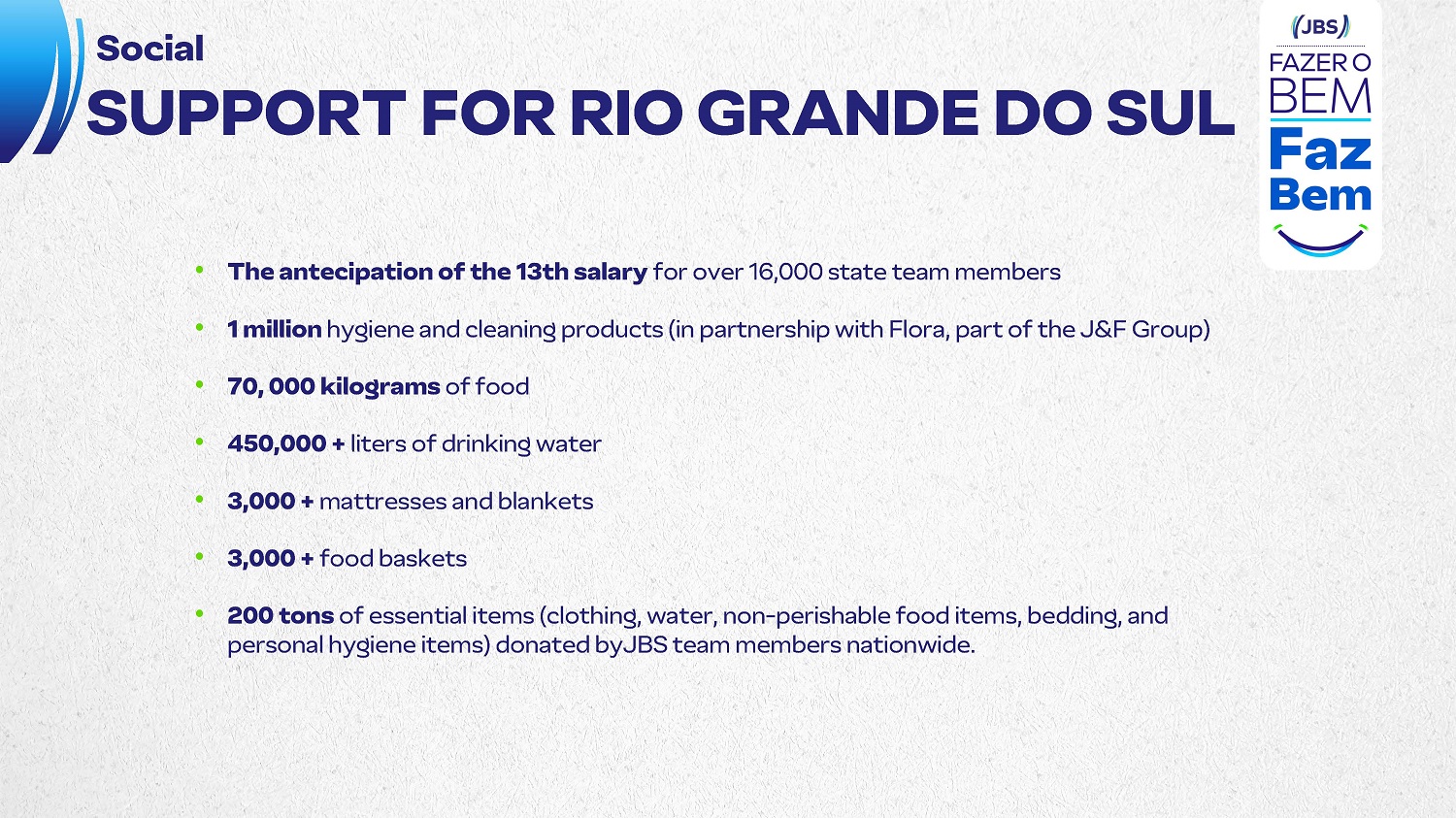
• The antecipation of the 13th salary for over 16,000 state team members • 1 million hygiene and cleaning products (in partnership with Flora, part of the J&F Group) • 70, 000 kilograms of food • 450,000 + liters of drinking water • 3,000 + mattresses and blankets • 3,000 + food baskets • 200 tons of essential items (clothing, water, non - perishable food items, bedding, and personal hygiene items) donated byJBS team members nationwide. Social SUPPORT FOR RIO GRANDE DO SUL
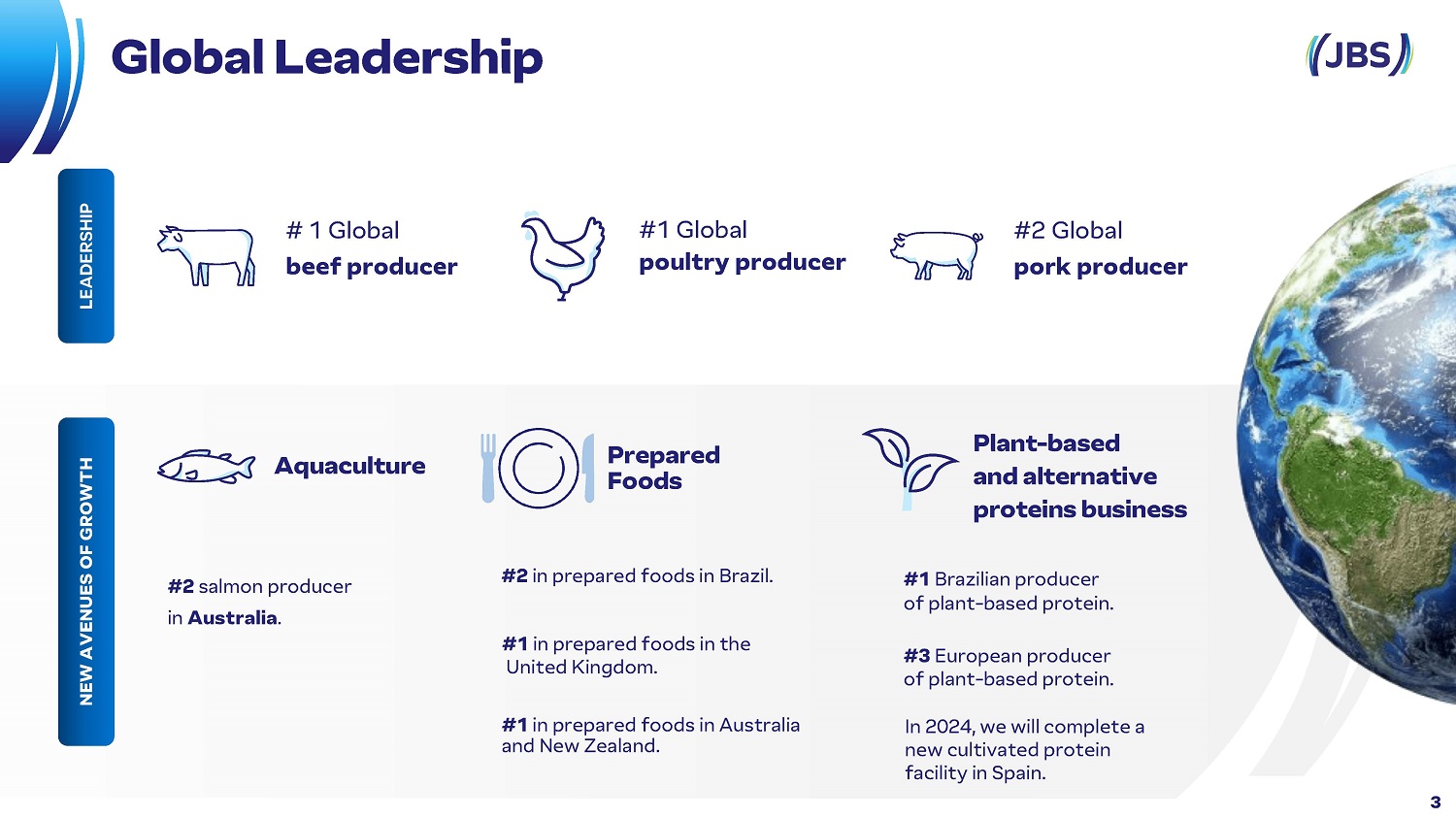
# 1 Global beef producer #1 Global poultry producer #2 Global pork producer Aquaculture Plant - based and alternative proteins business #3 European producer of plant - based protein. #2 salmon producer in Australia . In 2024, we will complete a new cultivated protein facility in Spain. Prepared Foods #1 Brazilian producer of plant - based protein. #2 in prepared foods in Brazil. #1 in prepared foods in the United Kingdom. #1 in prepared foods in Australia and New Zealand. LEADERSHIP NEW AVENUES OF GROWTH Global Leadership 3
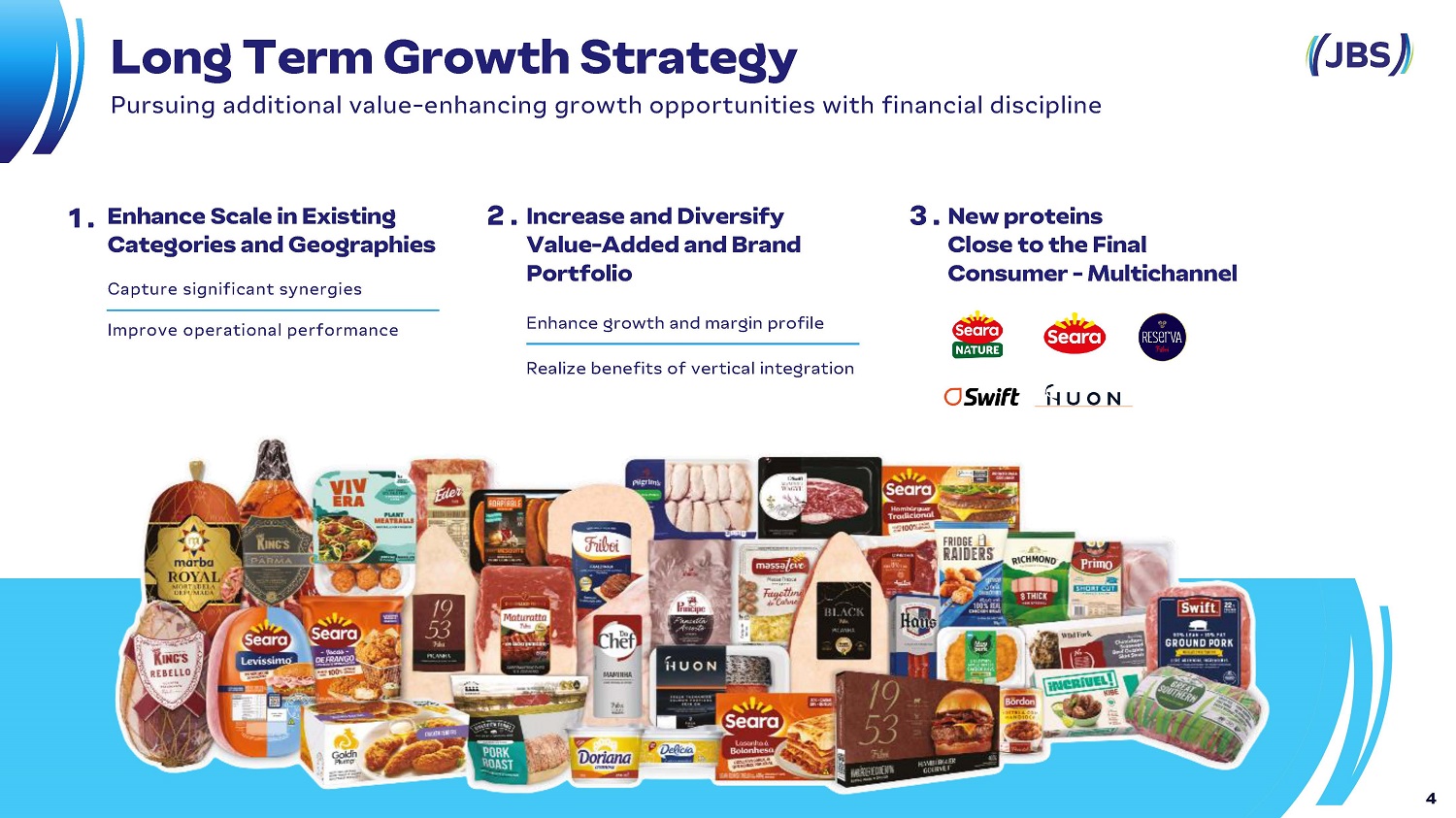
1 . Enhance Scale in Existing Categories and Geographies Capture significant synergies 2 . Increase and Diversify Value - Added and Brand Portfolio Long Term Growth Strategy Pursuing additional value - enhancing growth opportunities with financial discipline Improve operational performance Enhance growth and margin profile Realize benefits of vertical integration 3 . New proteins Close to the Final Consumer - Multichannel 4
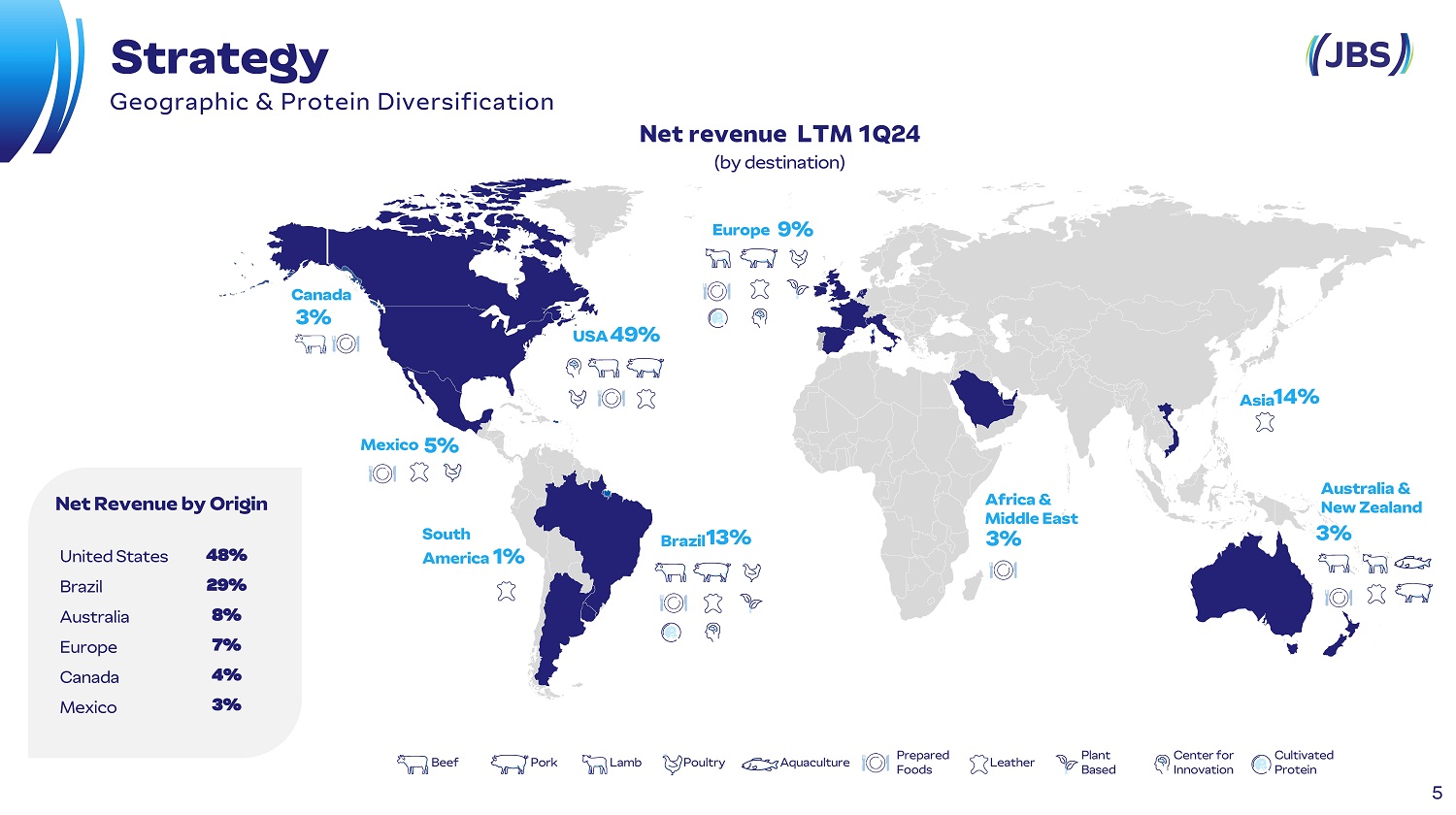
Net Revenue by Origin Canada Mexico 48% United States 29% Brazil 8% Australia 7% Europe 4% 3% Beef Pork Lamb Poultry Aquaculture Leather Plant Based Center for Innovation Cultivated Protein Prepared Foods South America 1% Mexico 5% Brazil 13% Asia 14% Africa & Middle East 3% USA 49% 3% Canada Australia & New Zealand 3% Net revenue LTM 1Q24 (by destination) Europe 9% 5 Strategy Geographic & Protein Diversification
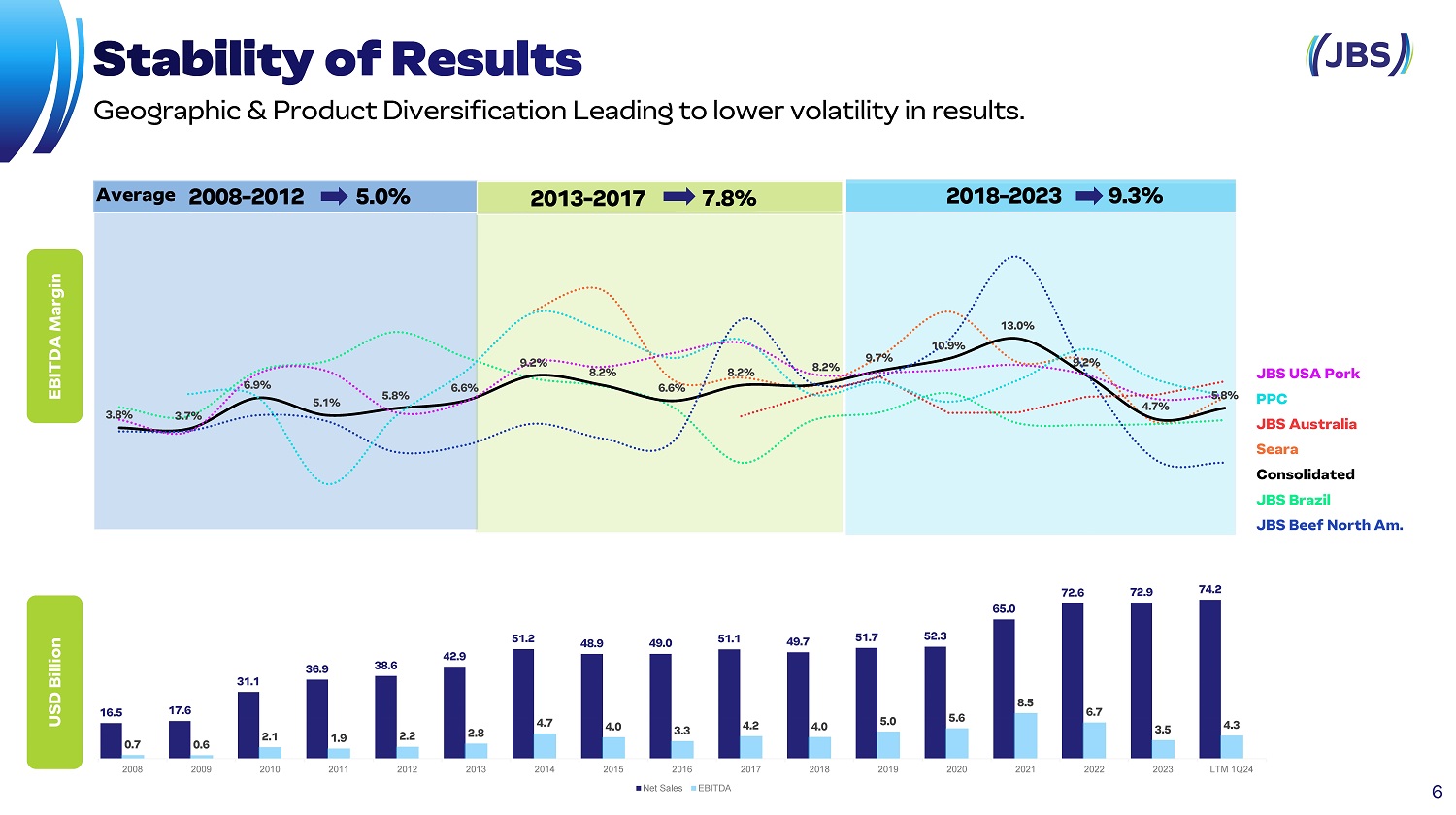
16.5 17.6 31.1 36.9 38.6 42.9 51.2 48.9 49.0 51.1 49.7 51.7 52.3 65.0 72.6 72.9 74.2 0.7 0.6 2.1 1.9 2.2 2.8 4.7 4.0 3.3 4.2 4.0 5.0 5.6 8.5 6.7 3.5 4.3 2008 2009 2010 2011 2012 2013 2014 2015 2016 Net Sales 2017 2018 2019 2020 2021 2022 2023 LTM 1Q24 EBITDA 3.8% 3.7% 6.9% 5.1% 5.8% 6.6% 9.2% 8.2% 6.6% 8.2% 8.2% 9.7% 13.0% 10.9% 9.2% 4.7% 5.8% EBITDA Margin USD Billion Geographic & Product Diversification Leading to lower volatility in results. 6 JBS USA Pork PPC JBS Australia Seara Consolidated JBS Brazil JBS Beef North Am.
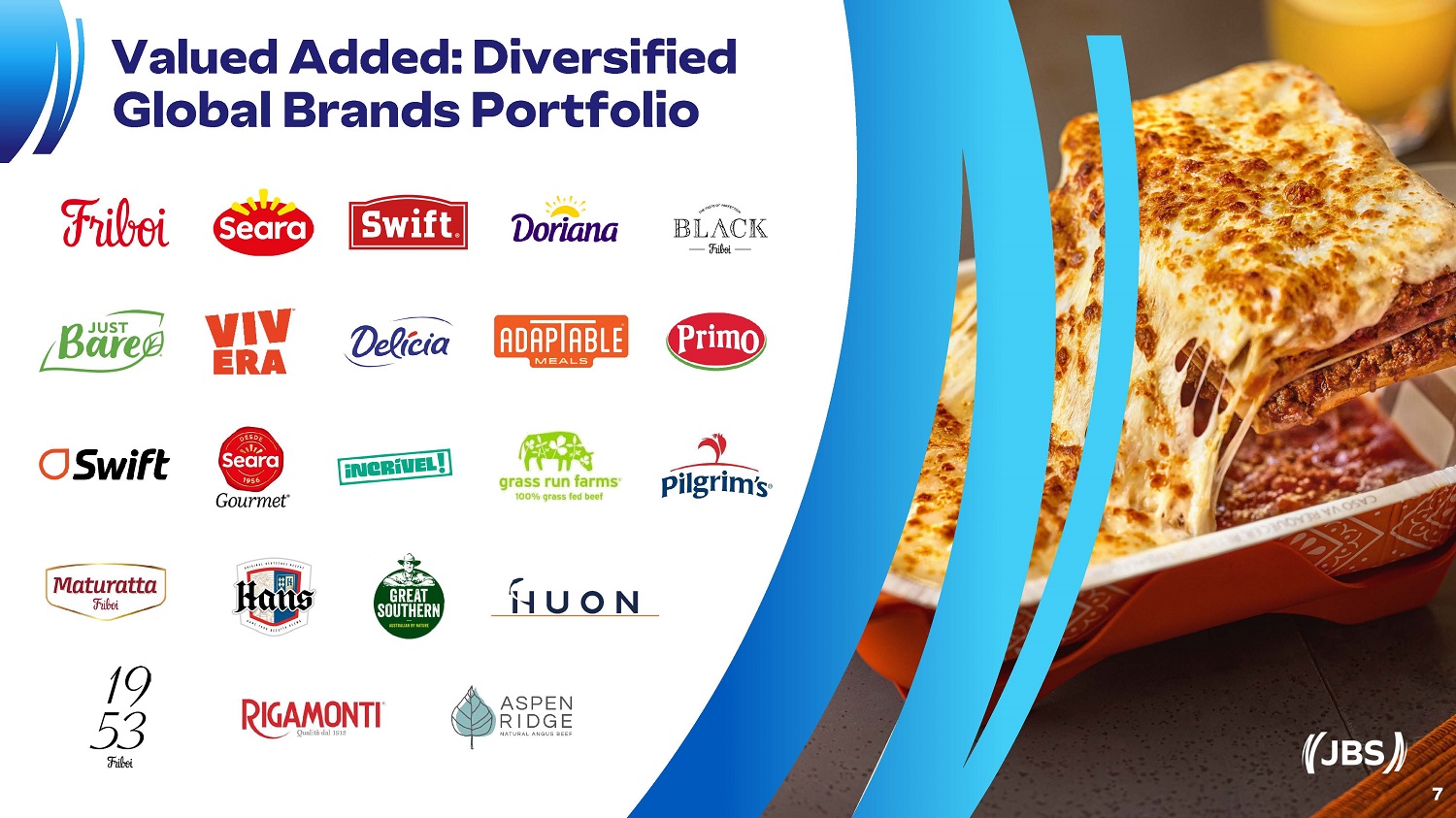
Valued Added: Diversified Global Brands Portfolio 7
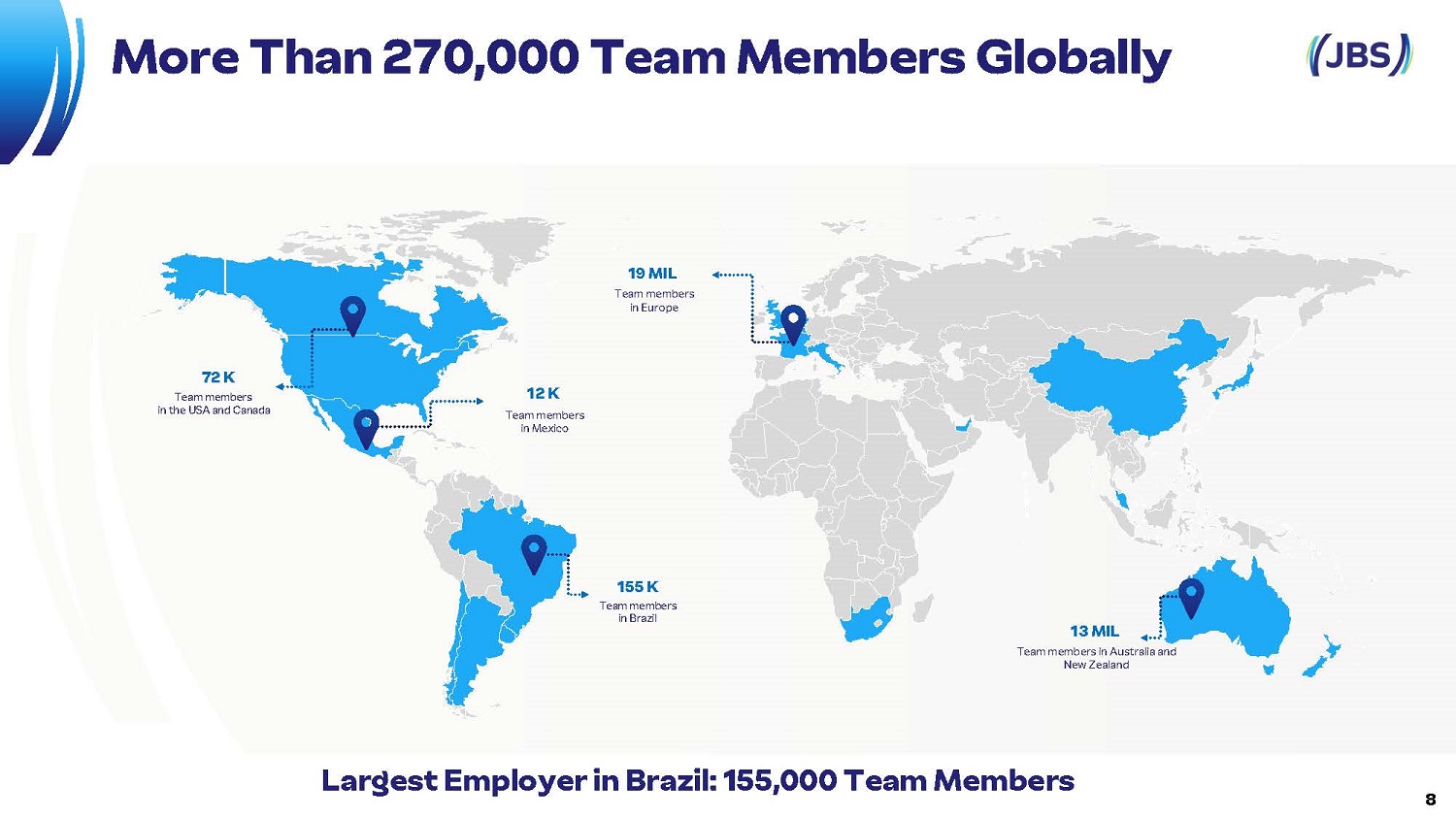
13 MIL Team members in Australia and New Zealand 155 K Team members in Brazil 12 K Team members in Mexico 8 19 MIL Team members in Europe 72 K Team members in the USA and Canada Largest Employer in Brazil: 155,000 Team Members More Than 270,000 Team Members Globally
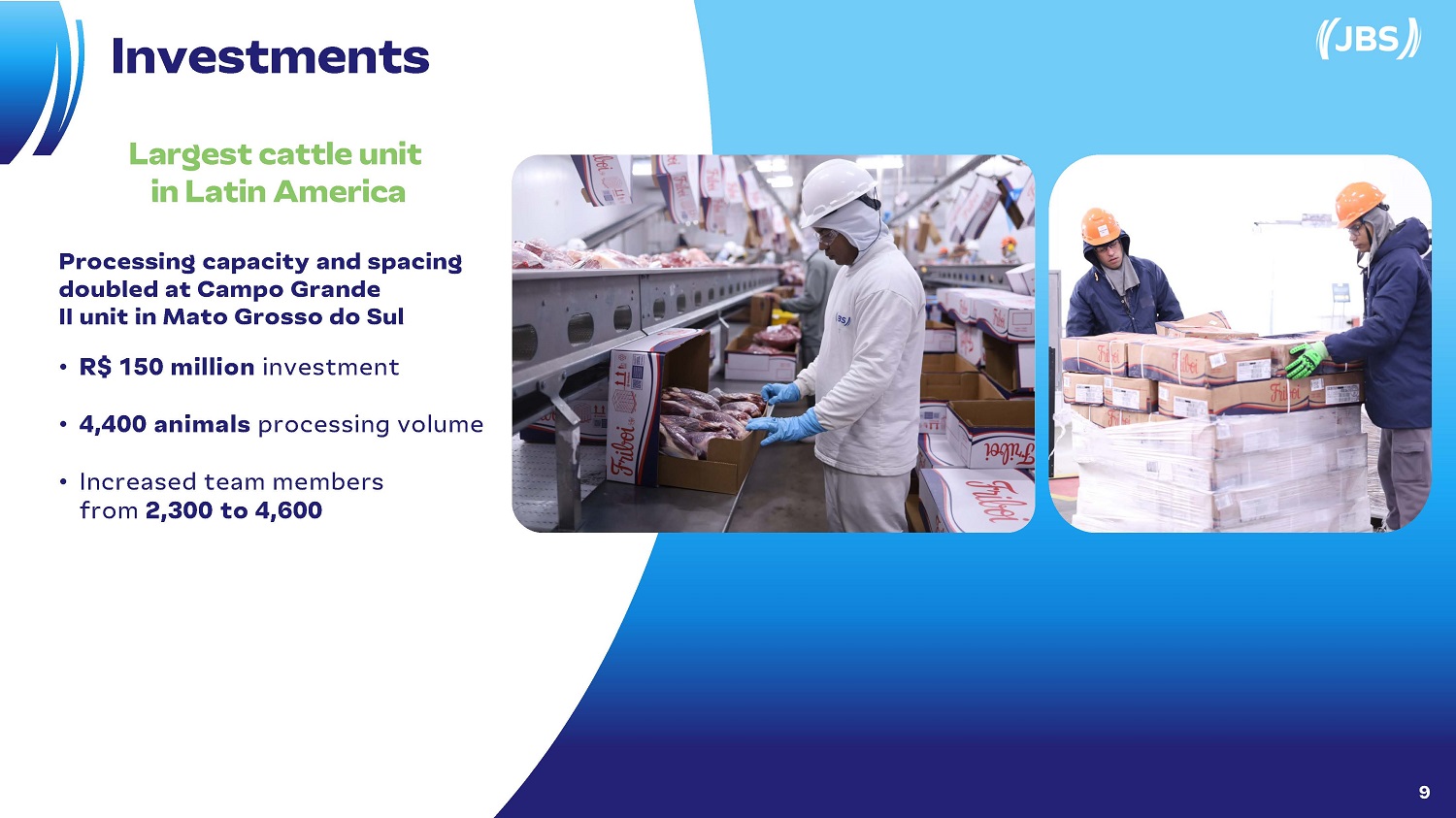
Investments Largest cattle unit in Latin America Processing capacity and spacing doubled at Campo Grande II unit in Mato Grosso do Sul • R$ 150 million investment • 4,400 animals processing volume • Increased team members from 2,300 to 4,600 9
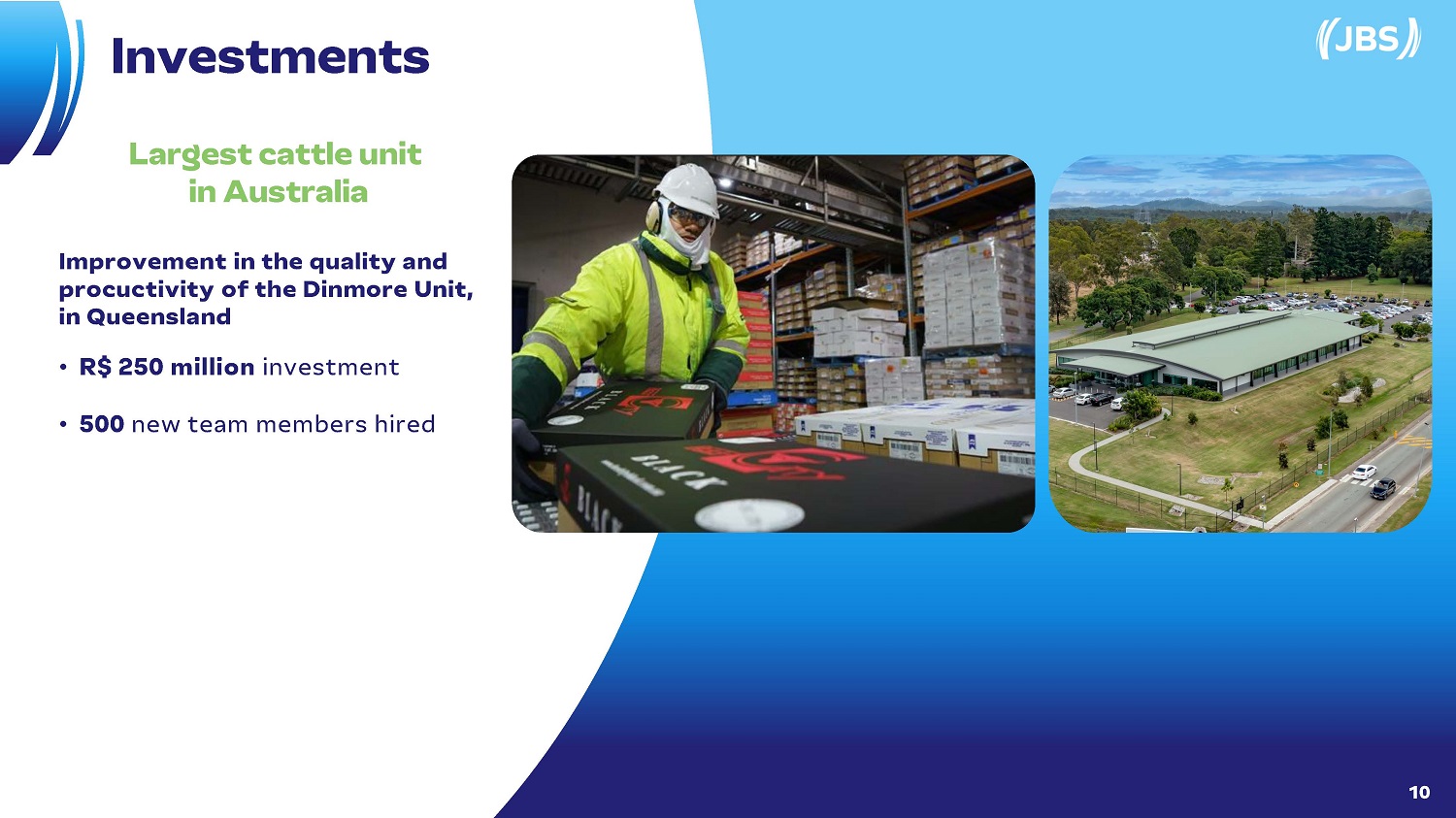
Largest cattle unit in Australia Improvement in the quality and procuctivity of the Dinmore Unit, in Queensland • R$ 250 million investment • 500 new team members hired Investments 10
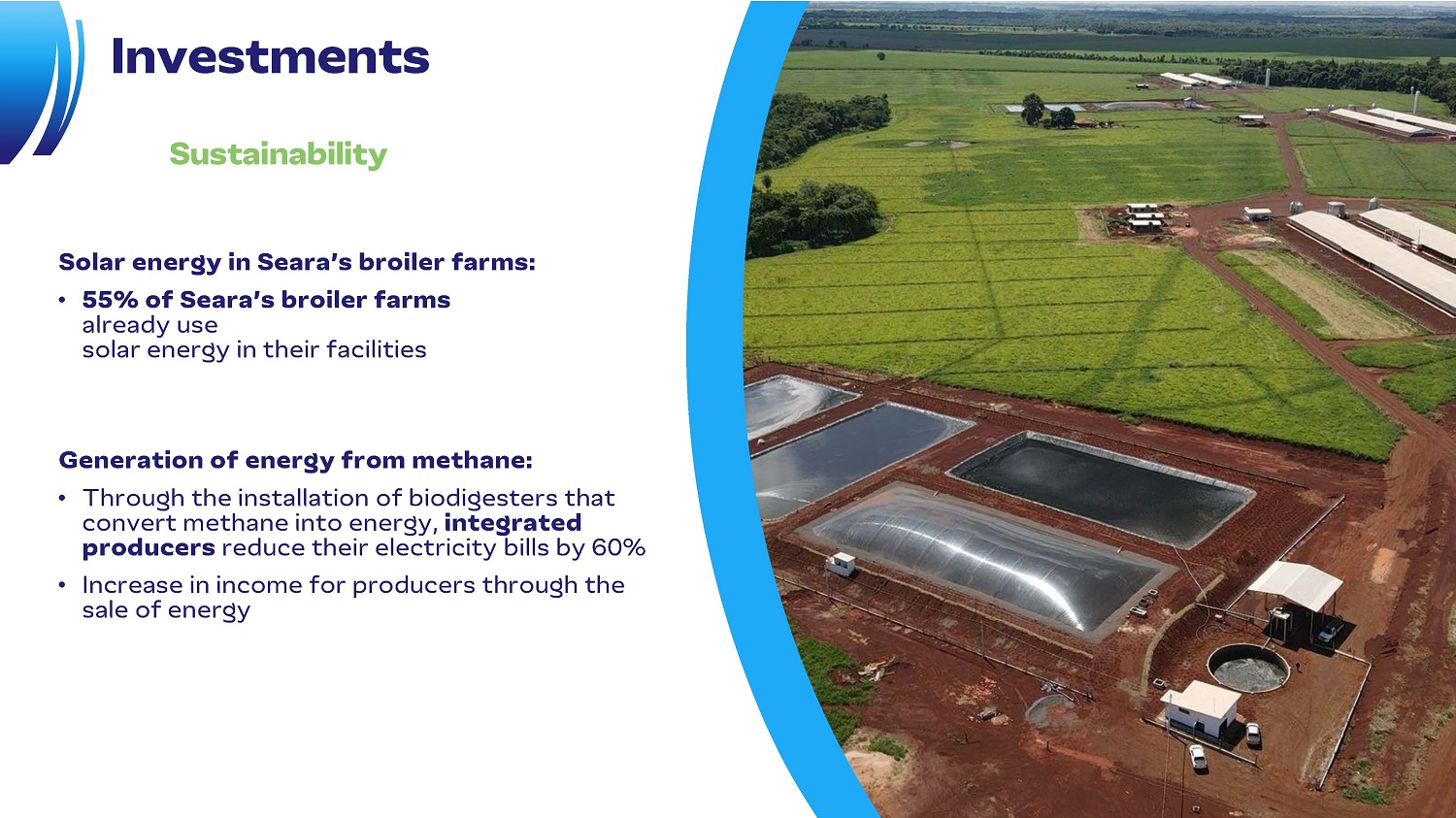
Investments Sustainability Solar energy in Seara’s broiler farms: • 55% of Seara’s broiler farms already use solar energy in their facilities Generation of energy from methane: • Through the installation of biodigesters that convert methane into energy, integrated producers reduce their electricity bills by 60% • Increase in income for producers through the sale of energy

Through the Beyond Borders program, the Company offers its team members the opportunity to internationalize their professional careers by changing roles or extending their knowledge to another country, strengthening JBS's organizational culture worldwide. 12 Instituto J&F Over 900 students enrolled in the education center, preparing young people for business. Better Futures Tuition - free community college tuition for JBS team members and their dependents. More than 6,000 people signed up. Instituto J&F MASTER Continuous training program for team members on the front line of production. Hometown Strong Community investment projects that support the communities where JBS is located through cash donations, infrastructure improvements and affordable housing. Social JBS projects around the world Beyond Borders Nourishing dreams, generating possibilities
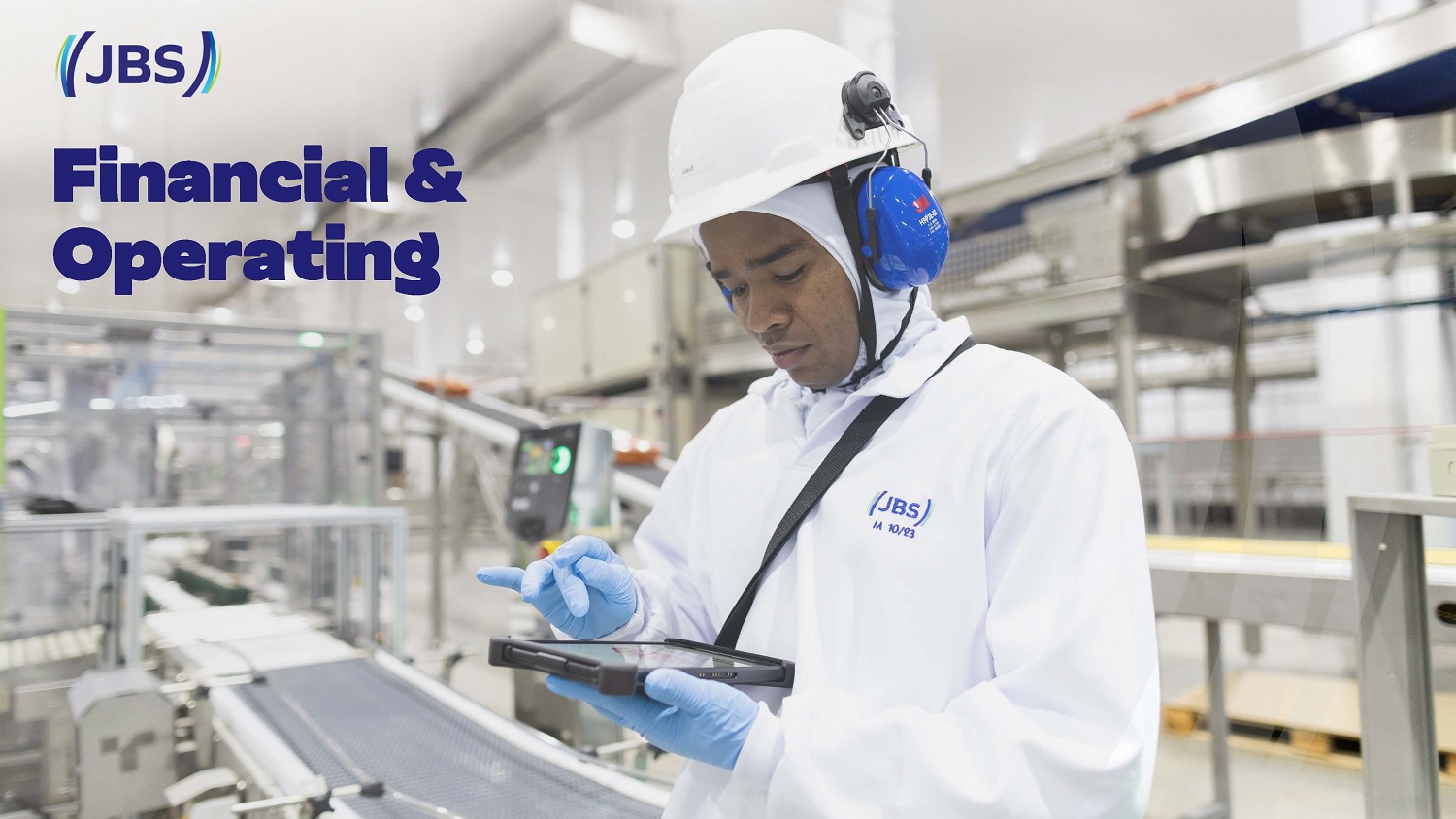
Financial & Operating
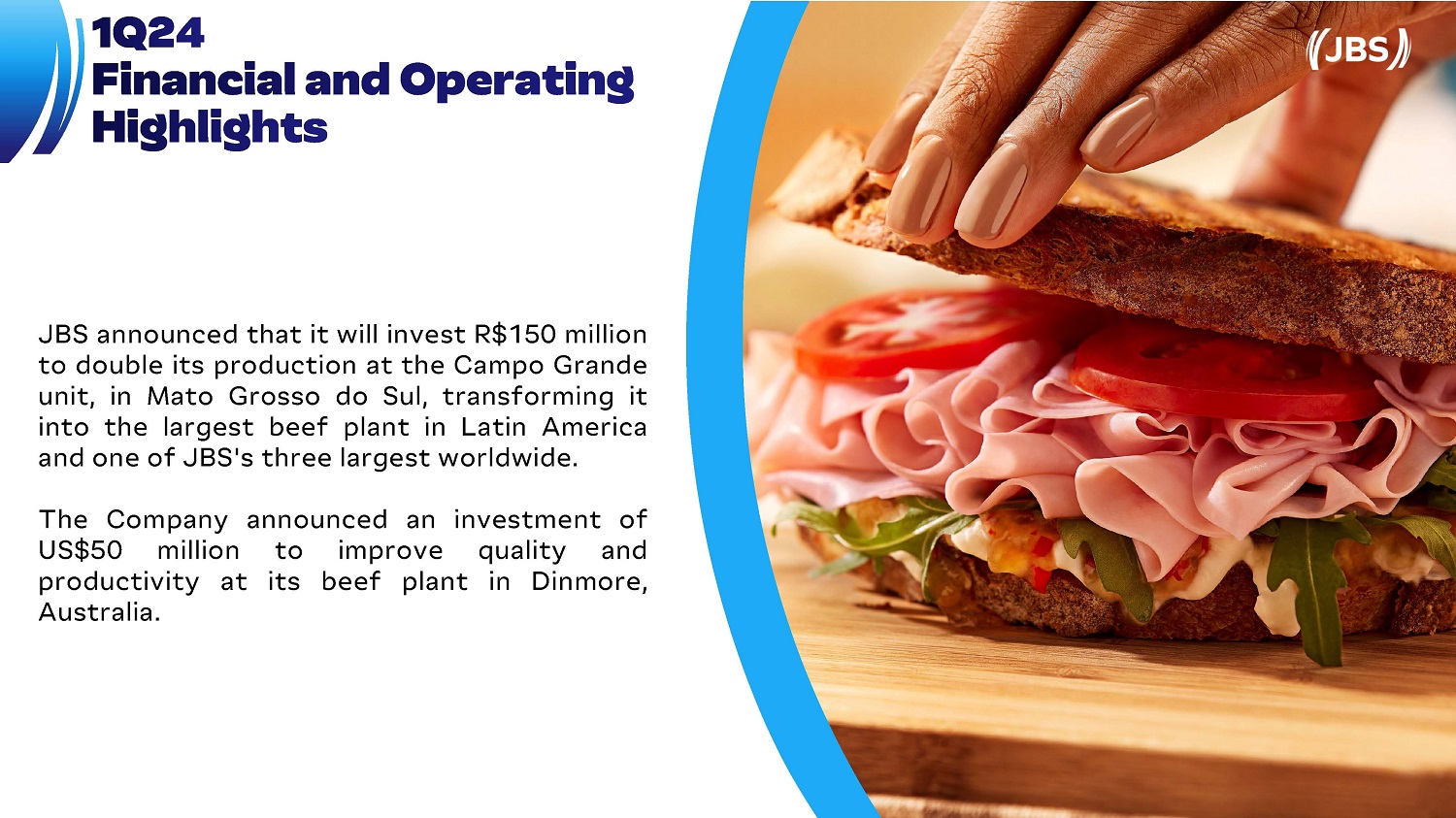
JBS announced that it will invest R $ 150 million to double its production at the Campo Grande unit, in Mato Grosso do Sul, transforming it into the largest beef plant in Latin America and one of JBS's three largest worldwide . The Company announced an investment of to improve quality and its beef plant in Dinmore, US$50 million productivity at Australia.
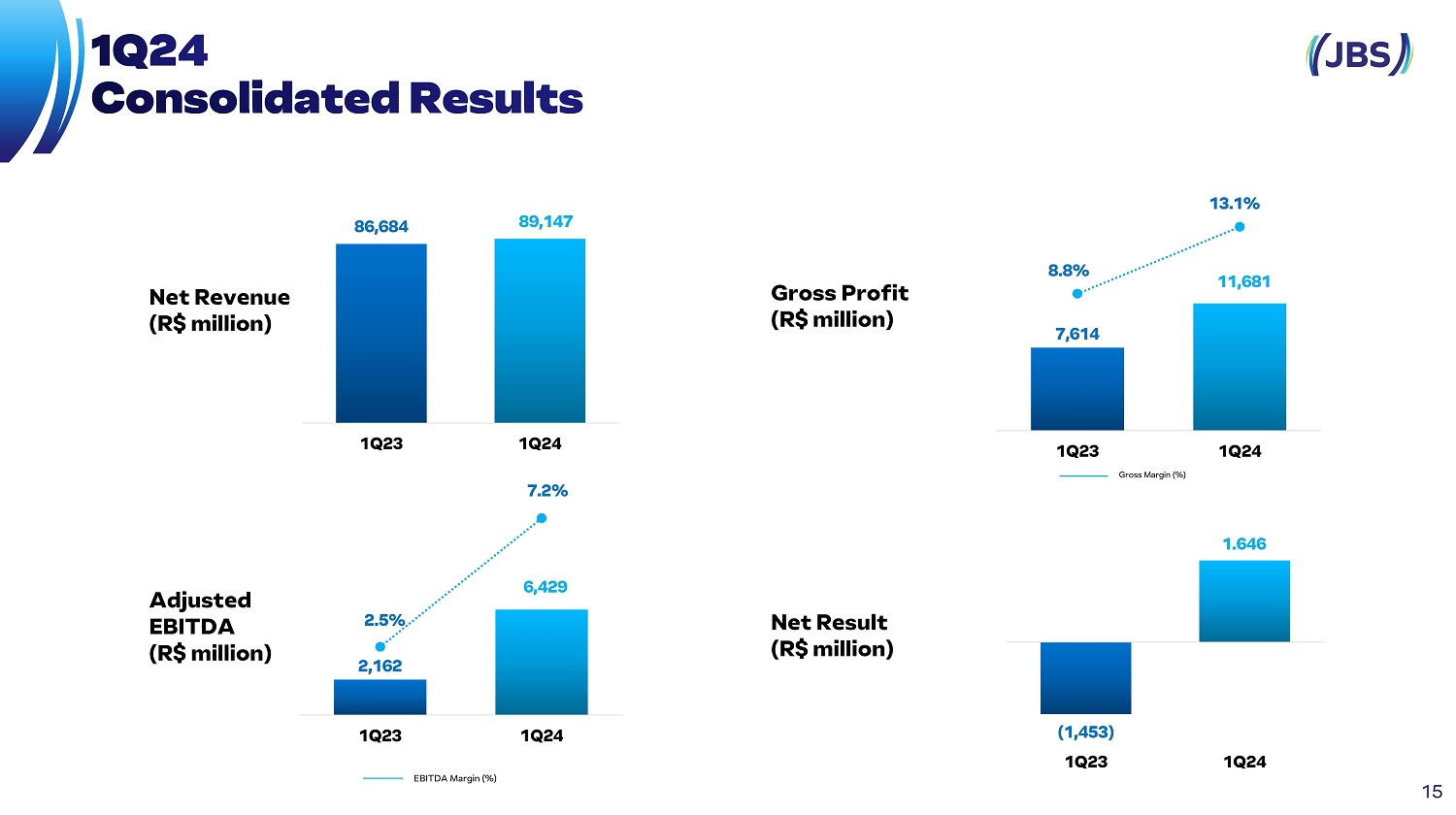
2,162 6,429 2.5% 7.2% 1Q23 1Q24 EBITDA Margin (%) (1,453) 1Q23 1.646 1Q24 86,684 89,147 1Q23 1Q24 7,614 11,681 8.8% 13.1% 1Q23 1Q24 Gross Margin (%) Net Result (R$ million) Adjusted EBITDA (R$ million) Net Revenue (R$ million) Gross Profit (R$ million) 15
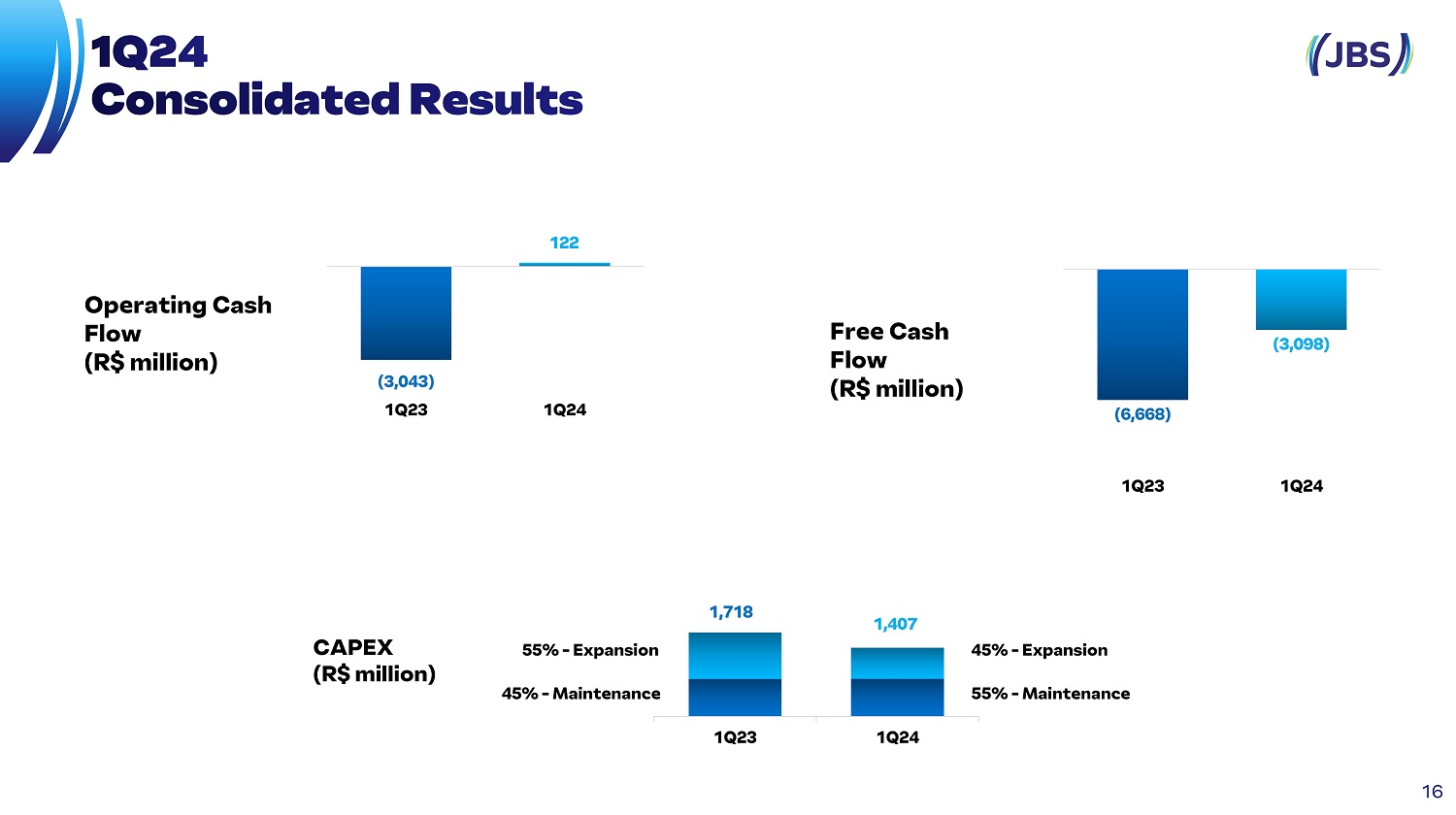
1,718 1,407 1Q23 1Q24 55% - Maintenance 45% - Expansion 45% - Maintenance 55% - Expansion (3,043) 1Q23 122 1Q24 (6,668) (3,098) 1Q23 1Q24 Operating Cash Flow (R$ million) Free Cash Flow (R$ million) CAPEX (R$ million) 16
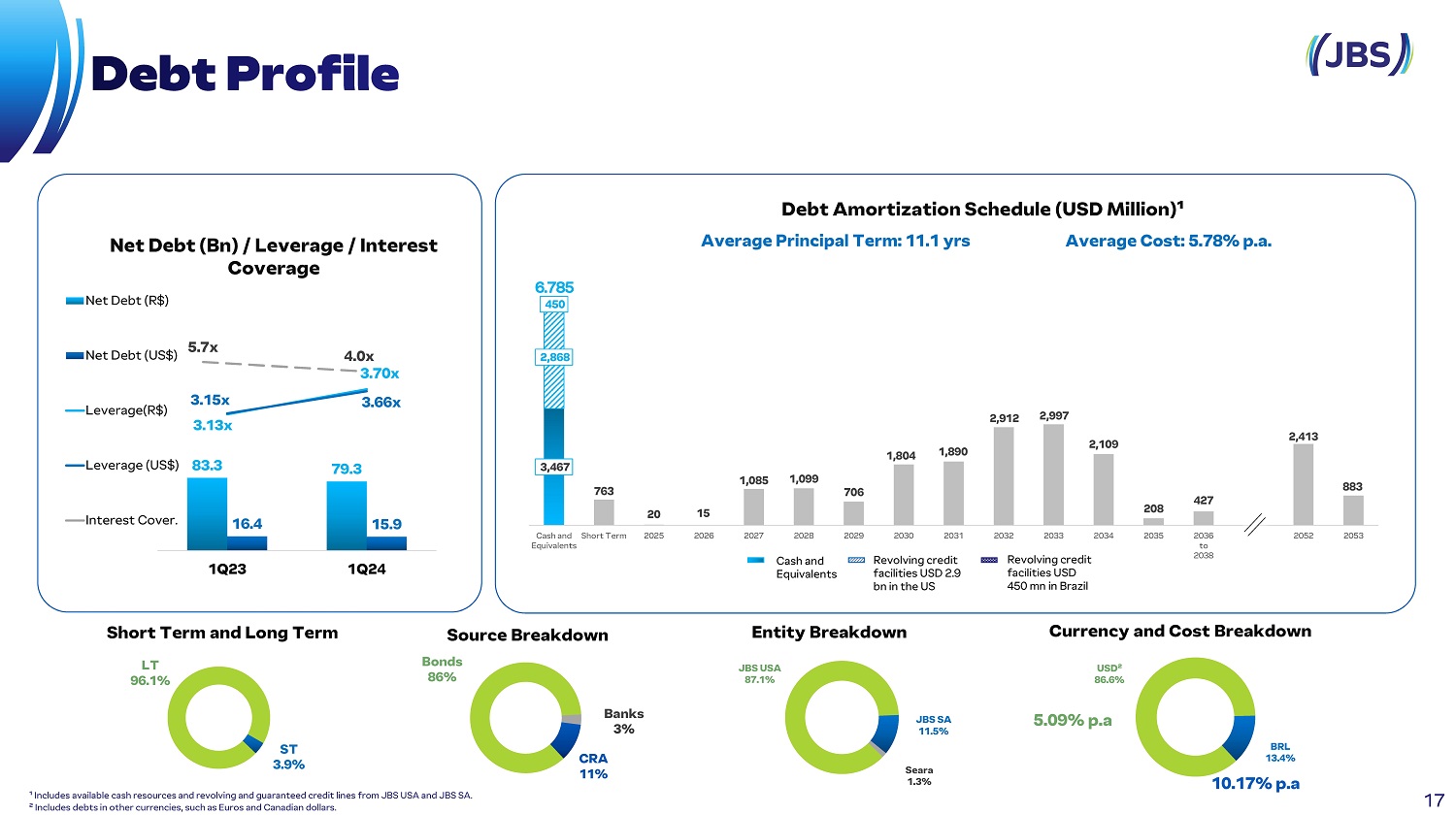
3,467 763 20 15 1,085 1,099 706 1,804 1,890 2,912 2,997 2,109 208 427 2,413 883 2,868 450 Cash and Short Term Equivalents 2025 2026 2027 2028 2029 2034 2035 2036 to 2038 2039 to 2051 2052 2053 5.7x 83.3 79.3 16.4 15.9 3.15x 3.13x 4.0x 3.70x 3.66x 1Q23 1Q24 Net Debt (US$) Leverage(R$) Leverage (US$) Interest Cover. Net Debt (Bn) / Leverage / Interest Coverage Net Debt (R$) ¹ Includes available cash resources and revolving and guaranteed credit lines from JBS USA and JBS SA. ² Includes debts in other currencies, such as Euros and Canadian dollars. Debt Amortization Schedule (USD Million)¹ Average Principal Term: 11.1 yrs Average Cost: 5.78% p.a. Entity Breakdown Currency and Cost Breakdown Short Term and Long Term LT 96.1% ST 3.9% Source Breakdown Bonds 86% Banks 3% CRA 11% JBS USA 87.1% JBS SA 11.5% Seara 1.3% USD² 86.6% BRL 13.4% 5.09% p.a 10.17% p.a Cash and Equivalents 2030 2031 Revolving credit facilities USD 2 . 9 bn in the US 2032 2033 Revolving credit facilities USD 450 mn in Brazil 17
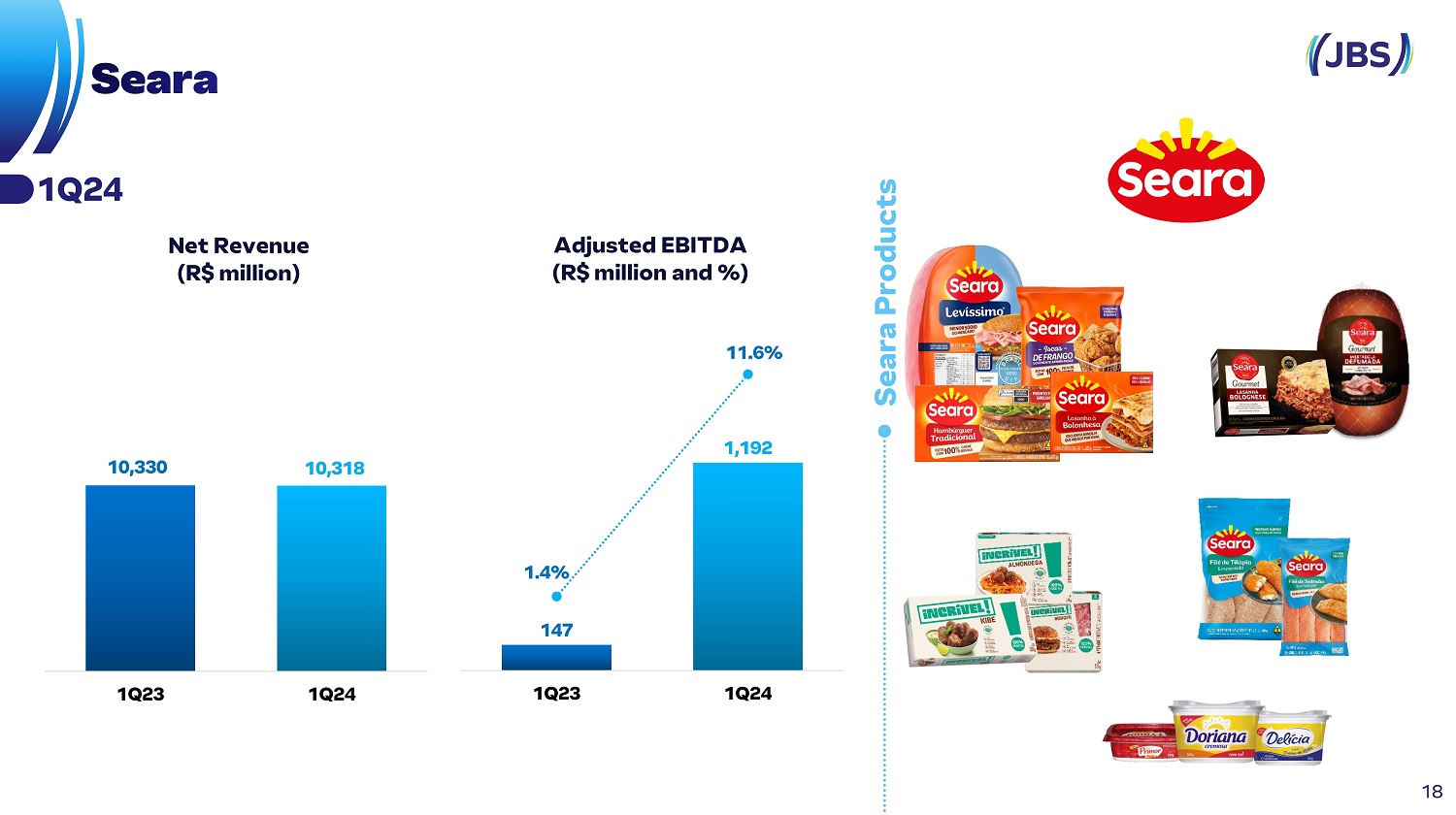
10,330 10,318 1Q23 1Q24 Seara Products 1,192 1.4% 147 11.6% 1Q23 1Q24 1Q24 Net Revenue (R$ million) Adjusted EBITDA (R$ million and %) 18
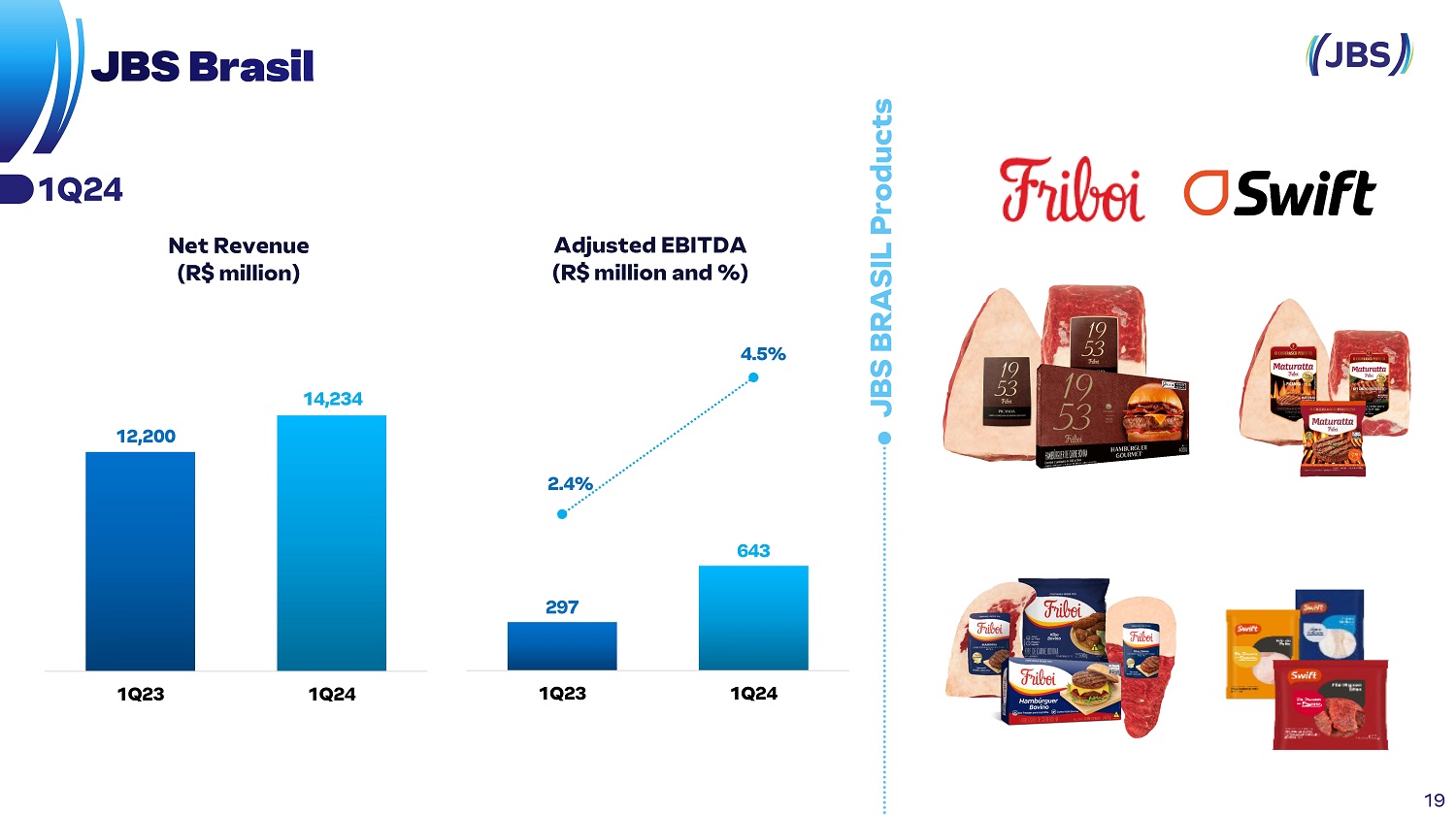
297 643 2.4% 4.5% 1Q23 1Q24 12,200 14,234 1Q23 1Q24 JBS BRASIL Products Net Revenue (R$ million) Adjusted EBITDA (R$ million and %) 1Q24 19
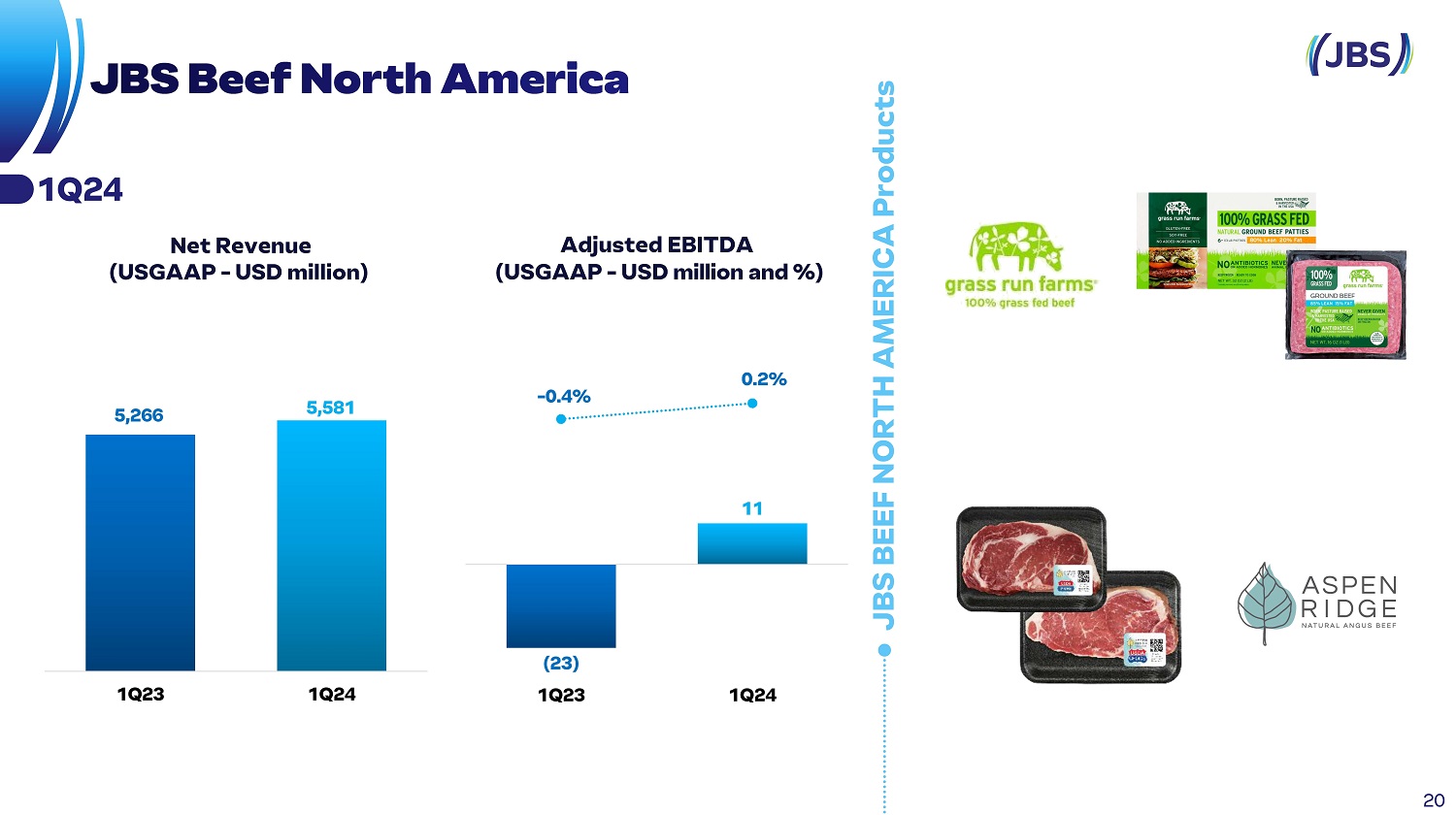
(23) 1Q23 11 - 0.4% 0.2% 1Q24 JBS BEEF NORTH AMERICA Products 5,266 5,581 1Q23 1Q24 Net Revenue (USGAAP - USD million) Adjusted EBITDA (USGAAP - USD million and %) 1Q24 20
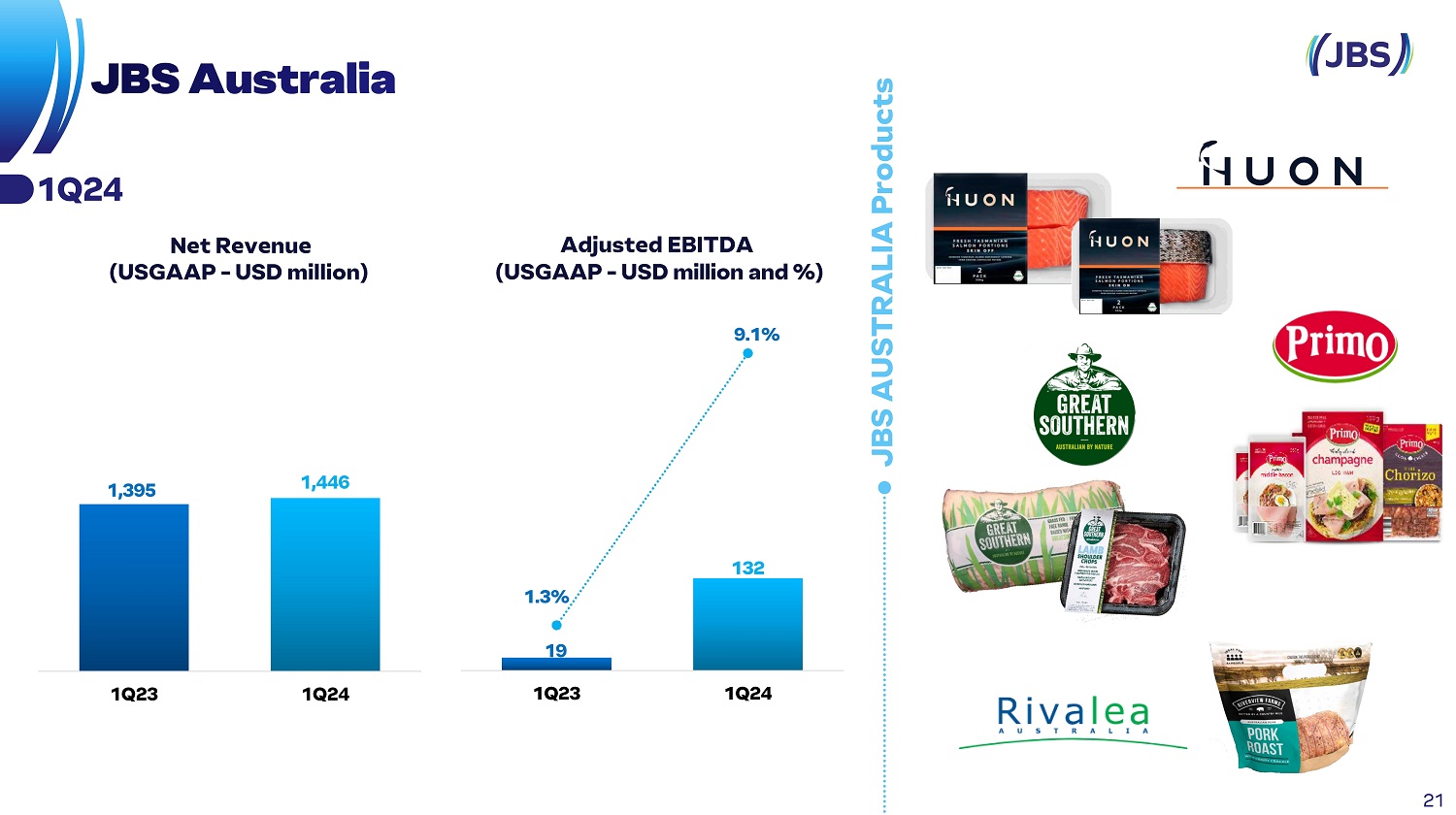
JBS AUSTRALIA Products 19 132 1.3% 9.1% 1Q23 1Q24 1,395 1,446 1Q23 1Q24 Net Revenue (USGAAP - USD million) Adjusted EBITDA (USGAAP - USD million and %) 1Q24 21
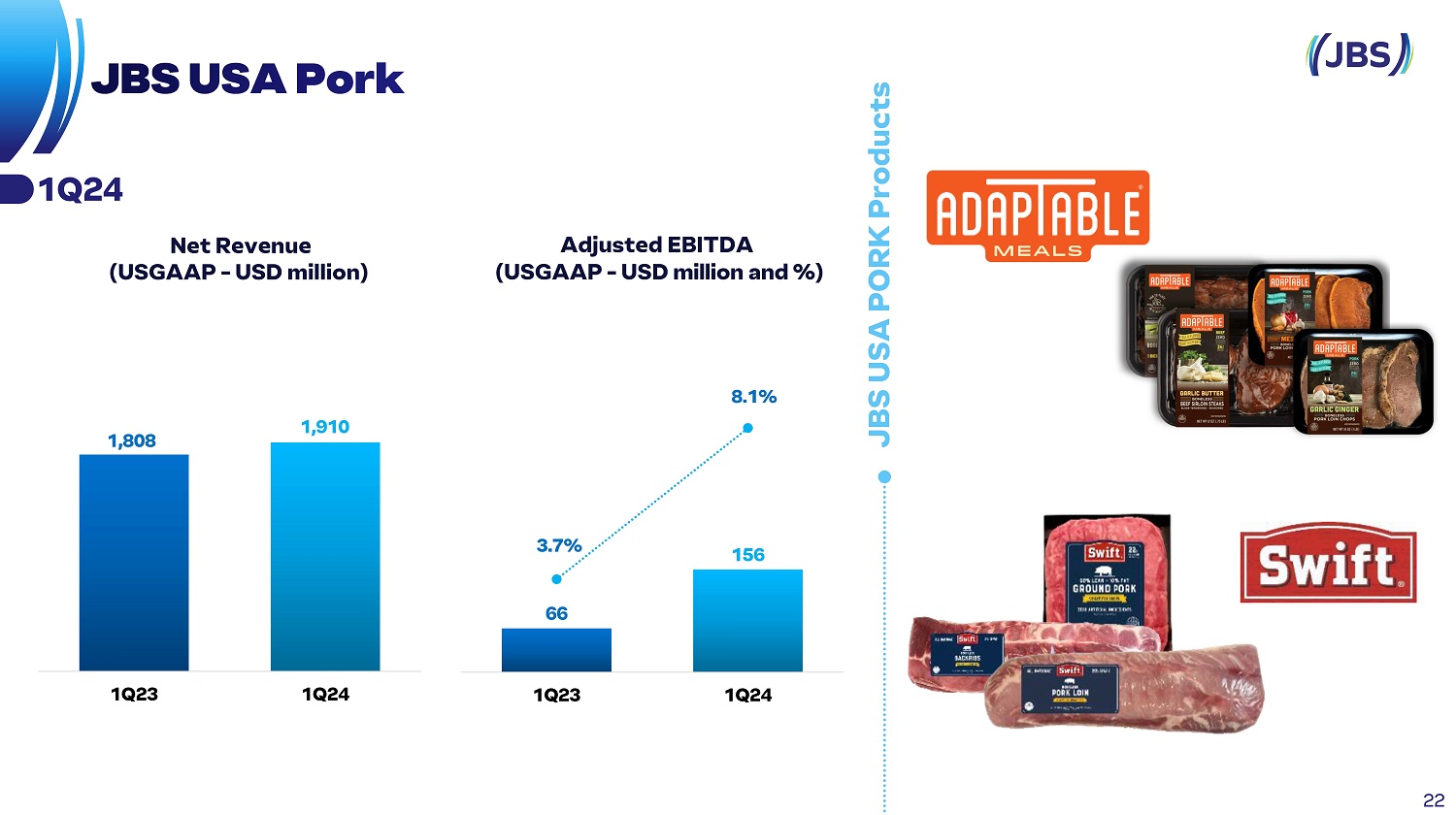
66 156 3.7% 8.1% 1Q23 1Q24 JBS USA PORK Products 1,808 1,910 1Q23 1Q24 Net Revenue (USGAAP - USD million) Adjusted EBITDA (USGAAP - USD million and %) 1Q24 22
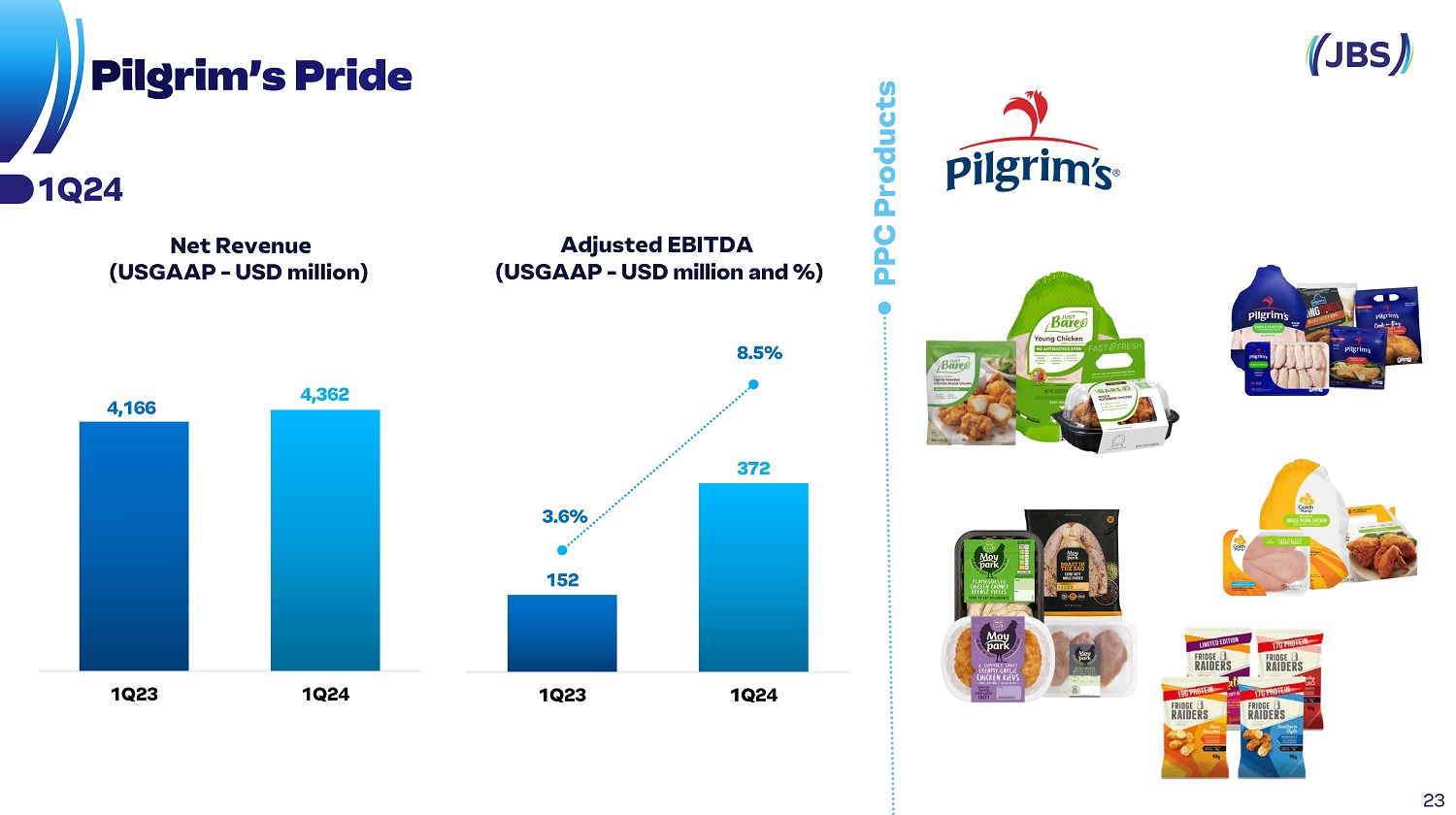
4,166 4,362 1Q23 1Q24 152 372 3.6% 8.5% 1Q23 1Q24 PPC Products Net Revenue (USGAAP - USD million) Adjusted EBITDA (USGAAP - USD million and %) 1Q24 23
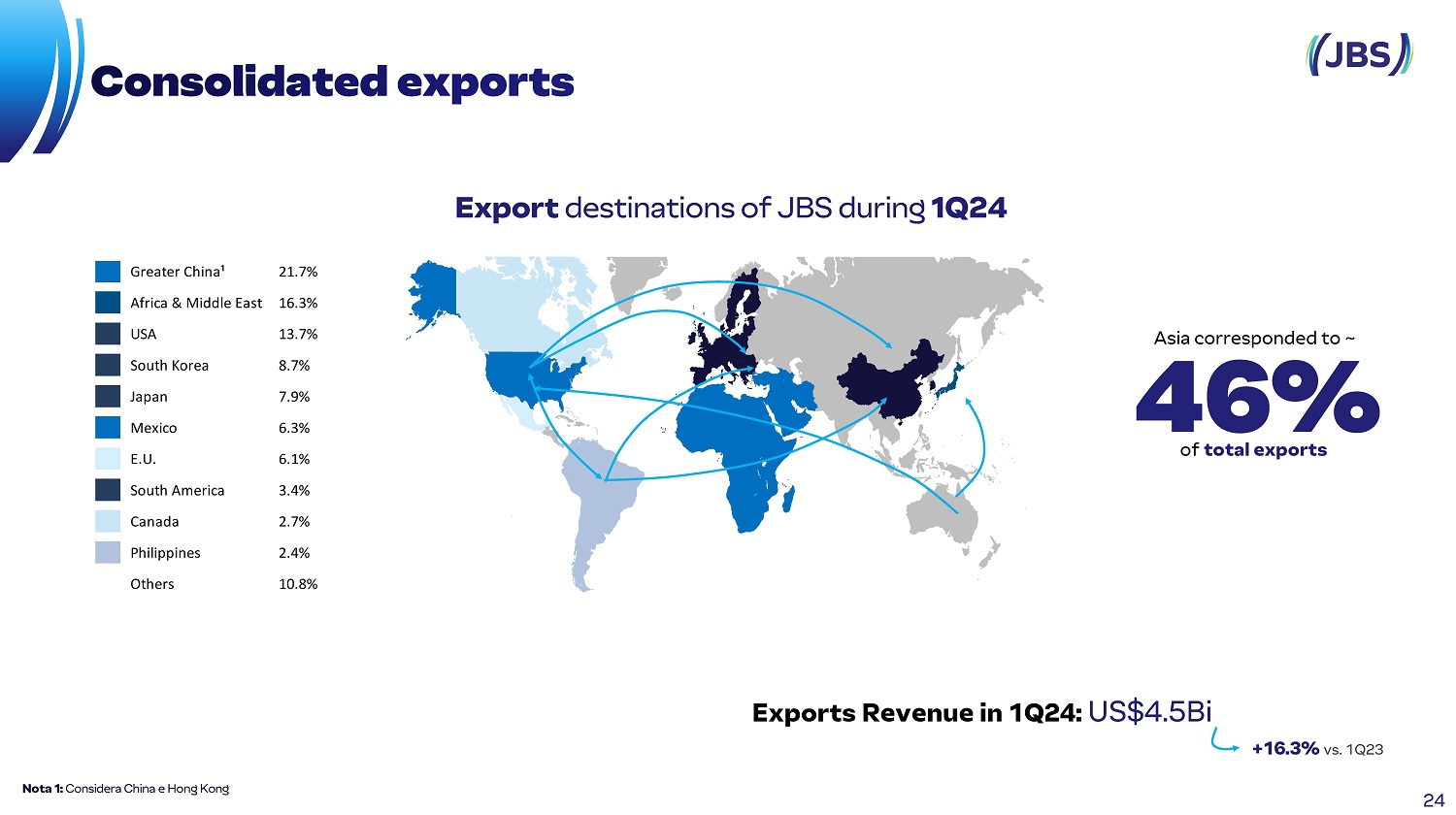
Nota 1: Considera China e Hong Kong Export destinations of JBS during 1Q24 Exports Revenue in 1Q24: US$4.5Bi +16.3% vs. 1Q23 Asia corresponded to ~ 46% of total exports 21.7% Greater China¹ 16.3% Africa & Middle East 13.7% USA 8.7% South Korea 7.9% Japan 6.3% Mexico 6.1% E.U. 3.4% South America 2.7% Canada 2.4% Philippines 10.8% Others 24
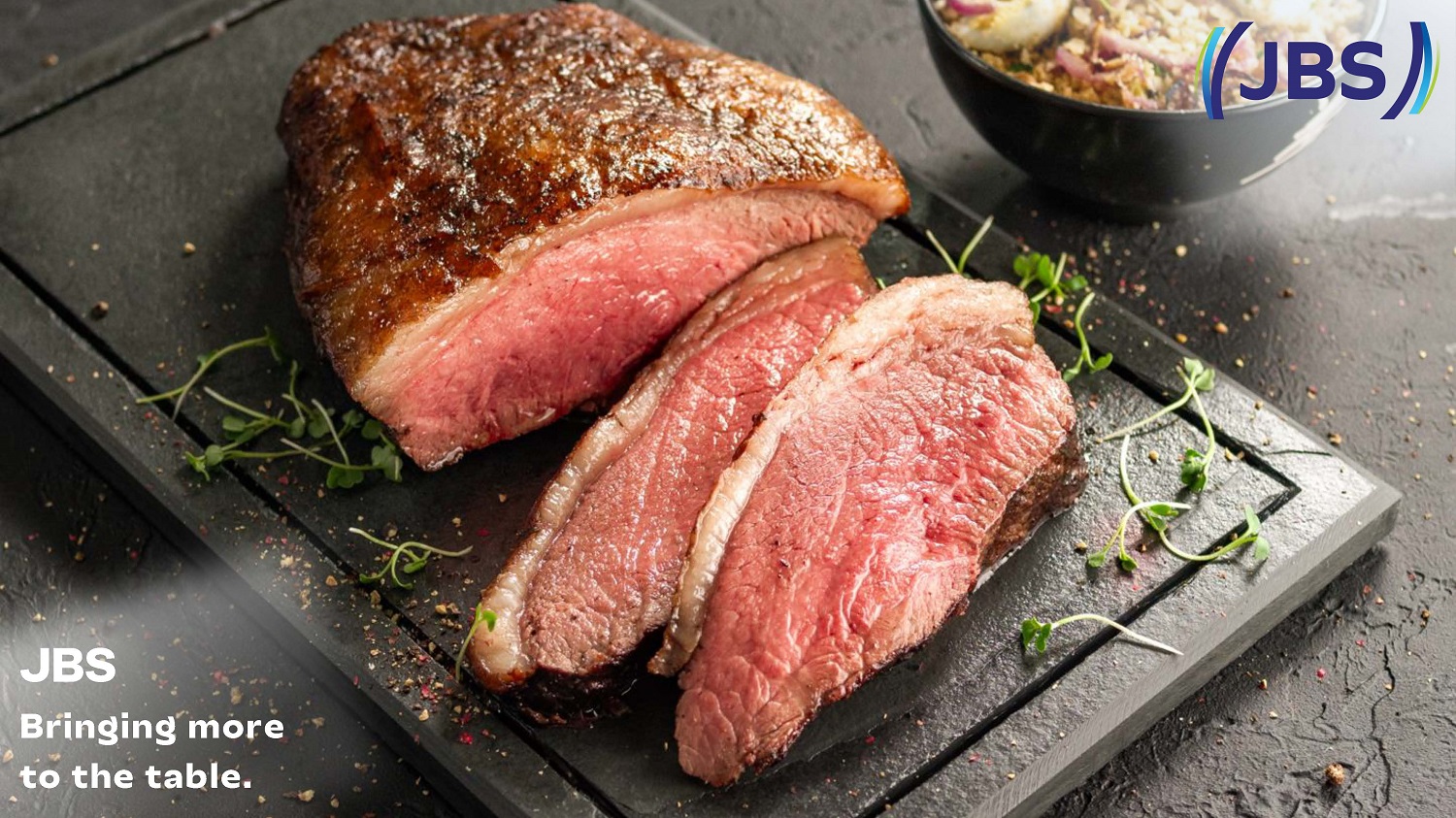
JBS Bringing more to the table.
Exhibit
99.2

Results 1Q24 JBS
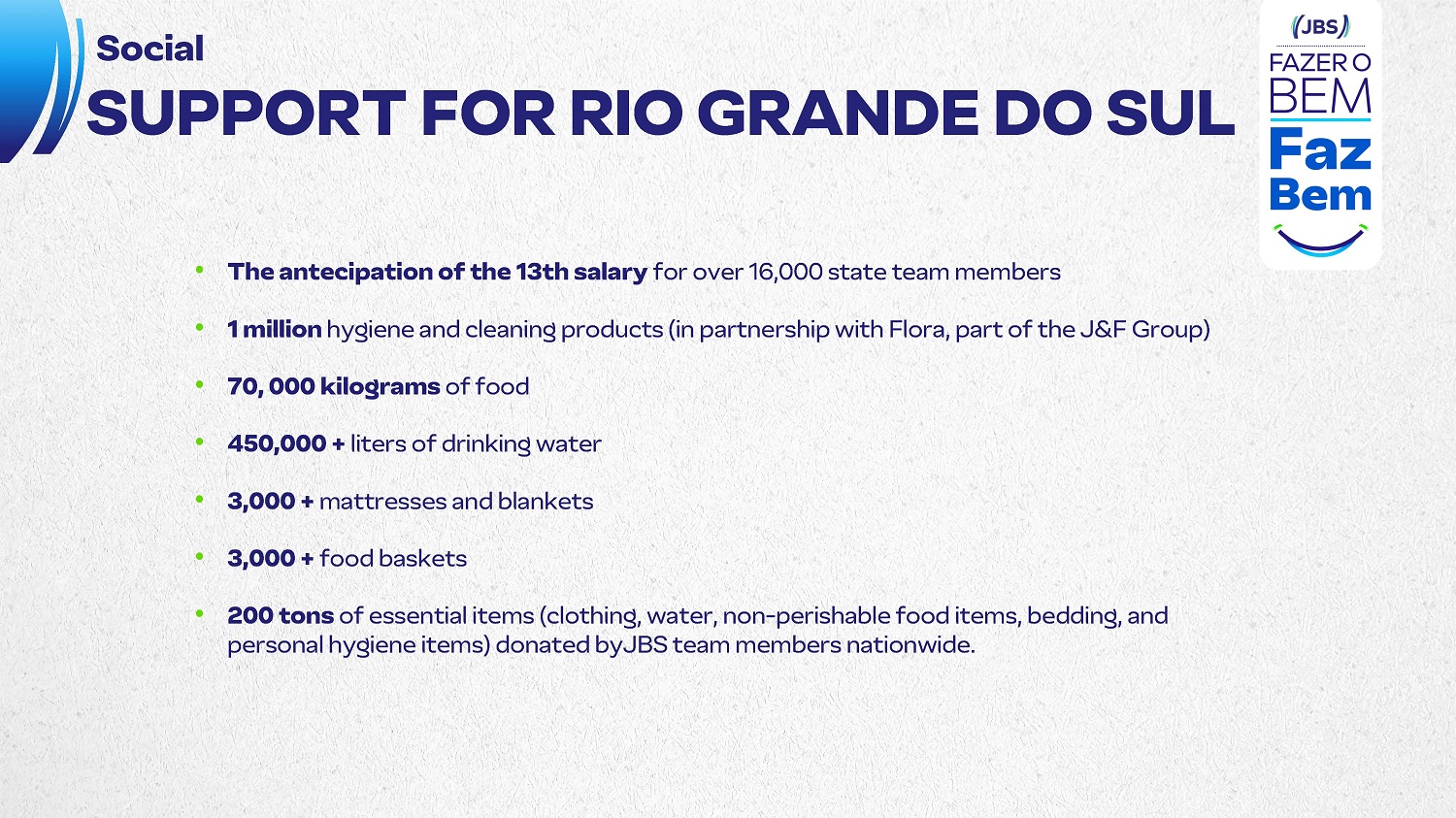
• The antecipation of the 13th salary for over 16,000 state team members • 1 million hygiene and cleaning products (in partnership with Flora, part of the J&F Group) • 70, 000 kilograms of food • 450,000 + liters of drinking water • 3,000 + mattresses and blankets • 3,000 + food baskets • 200 tons of essential items (clothing, water, non - perishable food items, bedding, and personal hygiene items) donated byJBS team members nationwide. Social SUPPORT FOR RIO GRANDE DO SUL
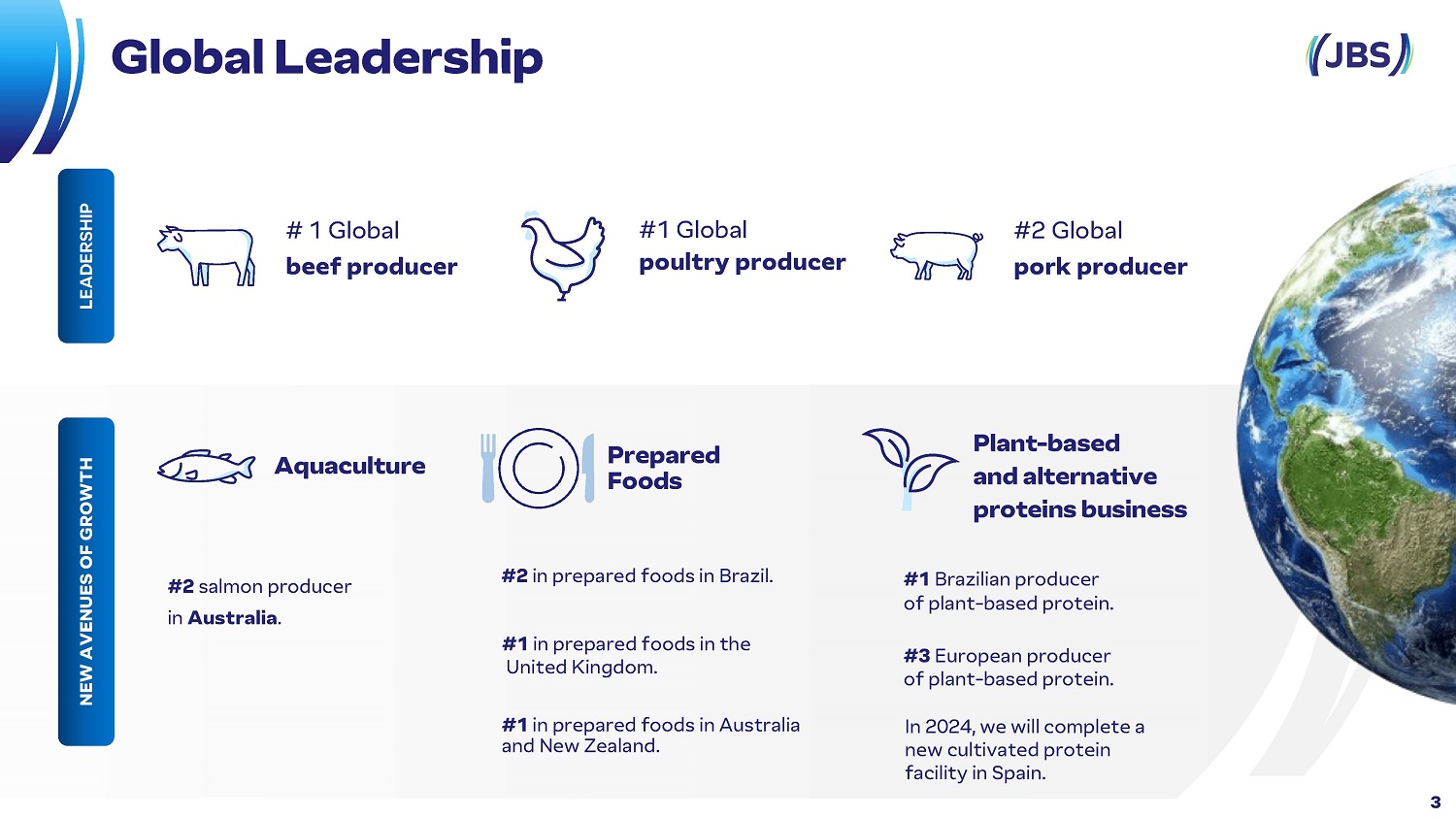
# 1 Global beef producer #1 Global poultry producer #2 Global pork producer Aquaculture Plant - based and alternative proteins business #3 European producer of plant - based protein. #2 salmon producer in Australia . In 2024, we will complete a new cultivated protein facility in Spain. Prepared Foods #1 Brazilian producer of plant - based protein. #2 in prepared foods in Brazil. #1 in prepared foods in the United Kingdom. #1 in prepared foods in Australia and New Zealand. LEADERSHIP NEW AVENUES OF GROWTH Global Leadership 3
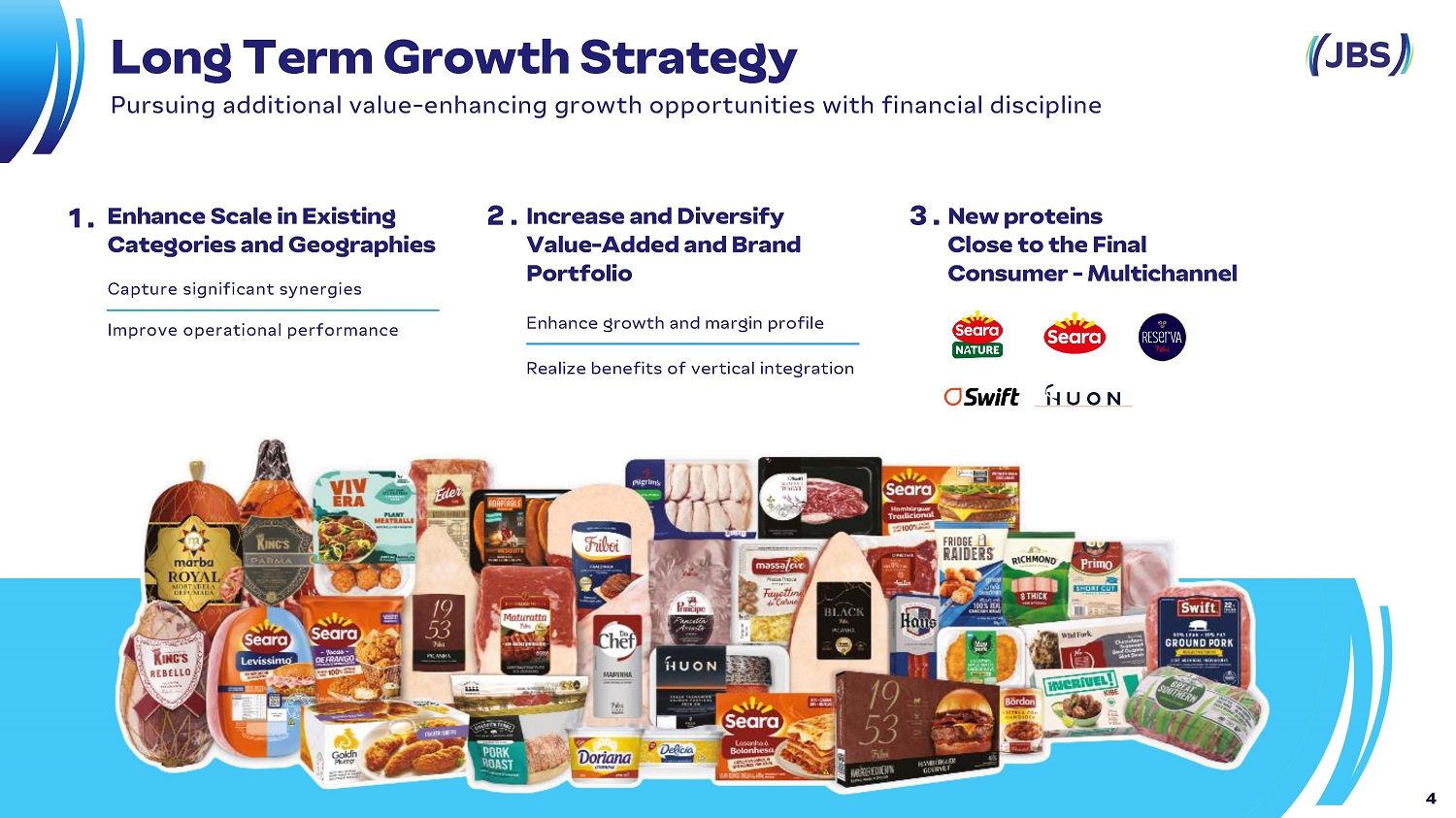
1 . Enhance Scale in Existing Categories and Geographies Capture significant synergies 2 . Increase and Diversify Value - Added and Brand Portfolio Long Term Growth Strategy Pursuing additional value - enhancing growth opportunities with financial discipline Improve operational performance Enhance growth and margin profile Realize benefits of vertical integration 3 . New proteins Close to the Final Consumer - Multichannel 4
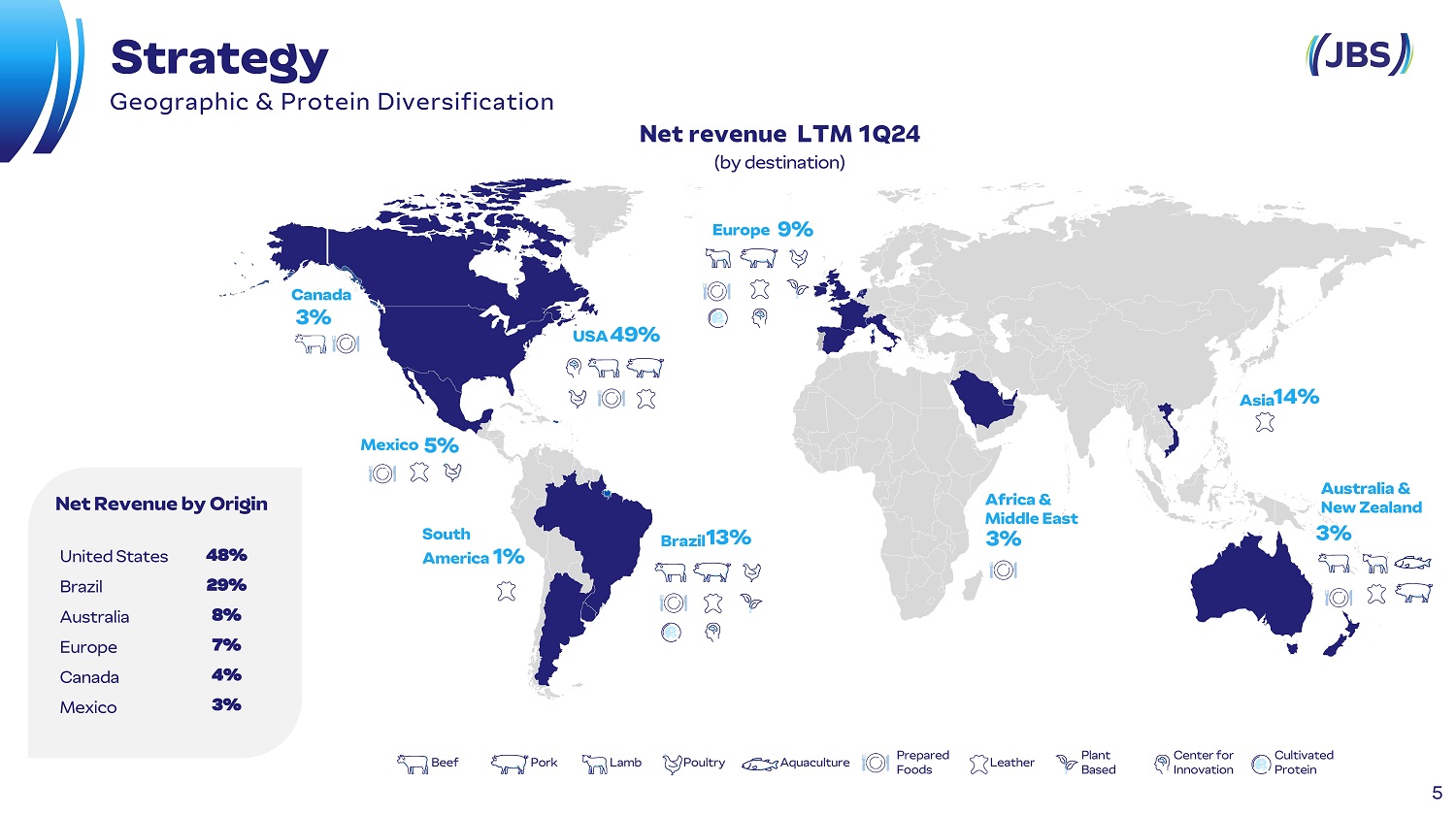
Net Revenue by Origin Canada Mexico 48% United States 29% Brazil 8% Australia 7% Europe 4% 3% Beef Pork Lamb Poultry Aquaculture Leather Plant Based Center for Innovation Cultivated Protein Prepared Foods South America 1% Mexico 5% Brazil 13% Asia 14% Africa & Middle East 3% USA 49% 3% Canada Australia & New Zealand 3% Net revenue LTM 1Q24 (by destination) Europe 9% 5 Strategy Geographic & Protein Diversification
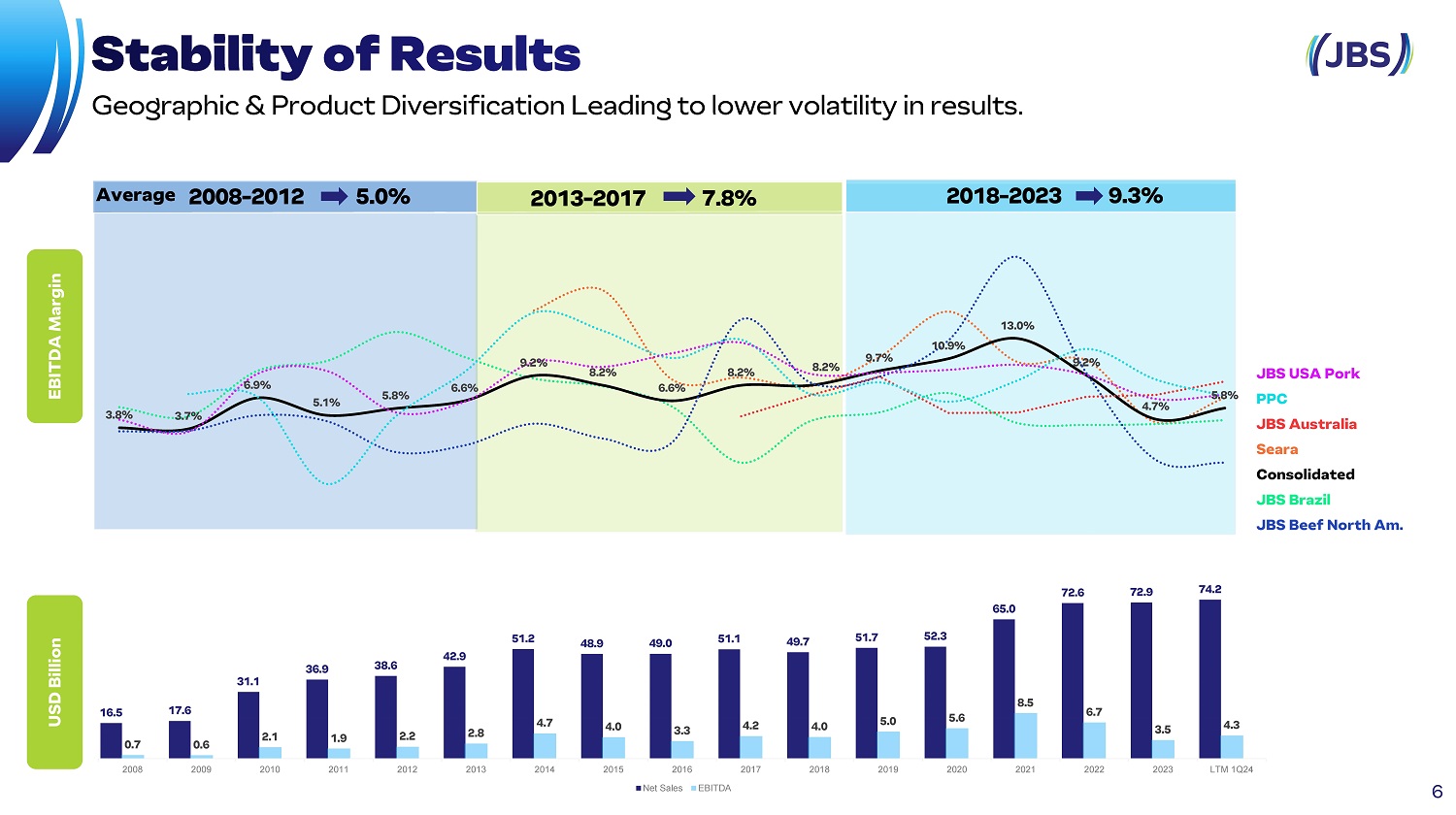
16.5 17.6 31.1 36.9 38.6 42.9 51.2 48.9 49.0 51.1 49.7 51.7 52.3 65.0 72.6 72.9 74.2 0.7 0.6 2.1 1.9 2.2 2.8 4.7 4.0 3.3 4.2 4.0 5.0 5.6 8.5 6.7 3.5 4.3 2008 2009 2010 2011 2012 2013 2014 2015 2016 Net Sales 2017 2018 2019 2020 2021 2022 2023 LTM 1Q24 EBITDA 3.8% 3.7% 6.9% 5.1% 5.8% 6.6% 9.2% 8.2% 6.6% 8.2% 8.2% 9.7% 13.0% 10.9% 9.2% 4.7% 5.8% EBITDA Margin USD Billion Geographic & Product Diversification Leading to lower volatility in results. 6 JBS USA Pork PPC JBS Australia Seara Consolidated JBS Brazil JBS Beef North Am.
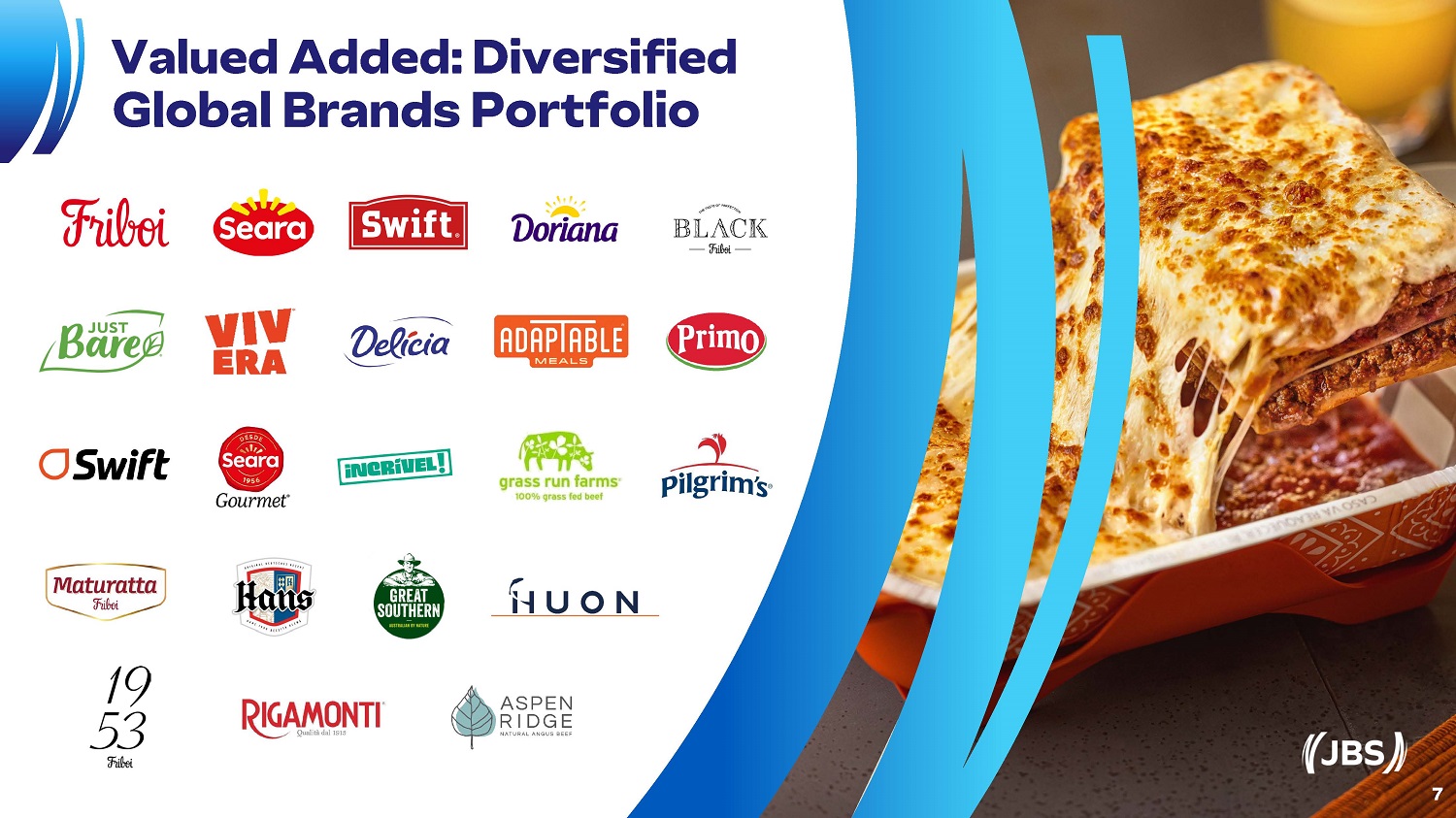
Valued Added: Diversified Global Brands Portfolio 7
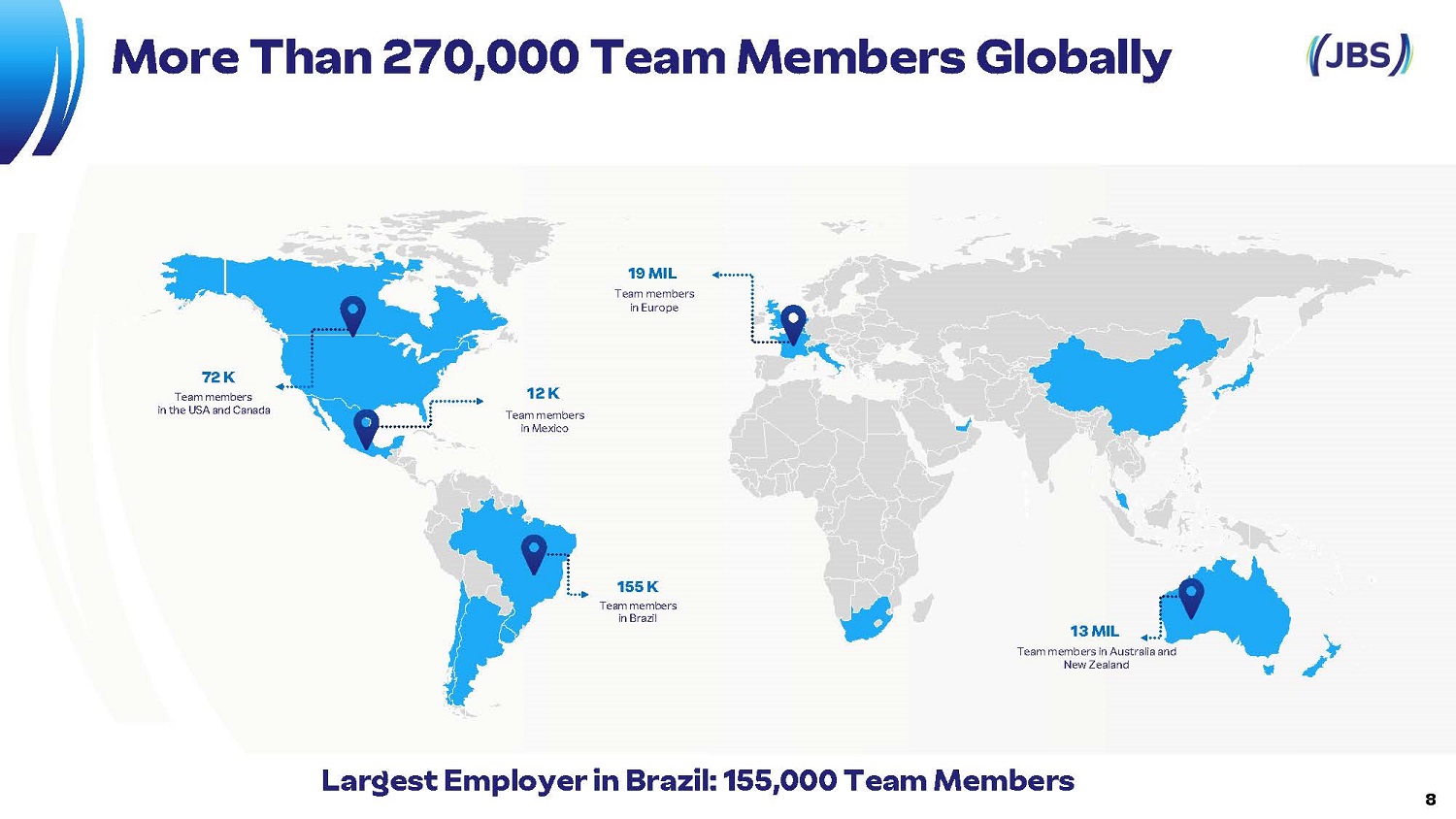
13 MIL Team members in Australia and New Zealand 155 K Team members in Brazil 12 K Team members in Mexico 8 19 MIL Team members in Europe 72 K Team members in the USA and Canada Largest Employer in Brazil: 155,000 Team Members More Than 270,000 Team Members Globally
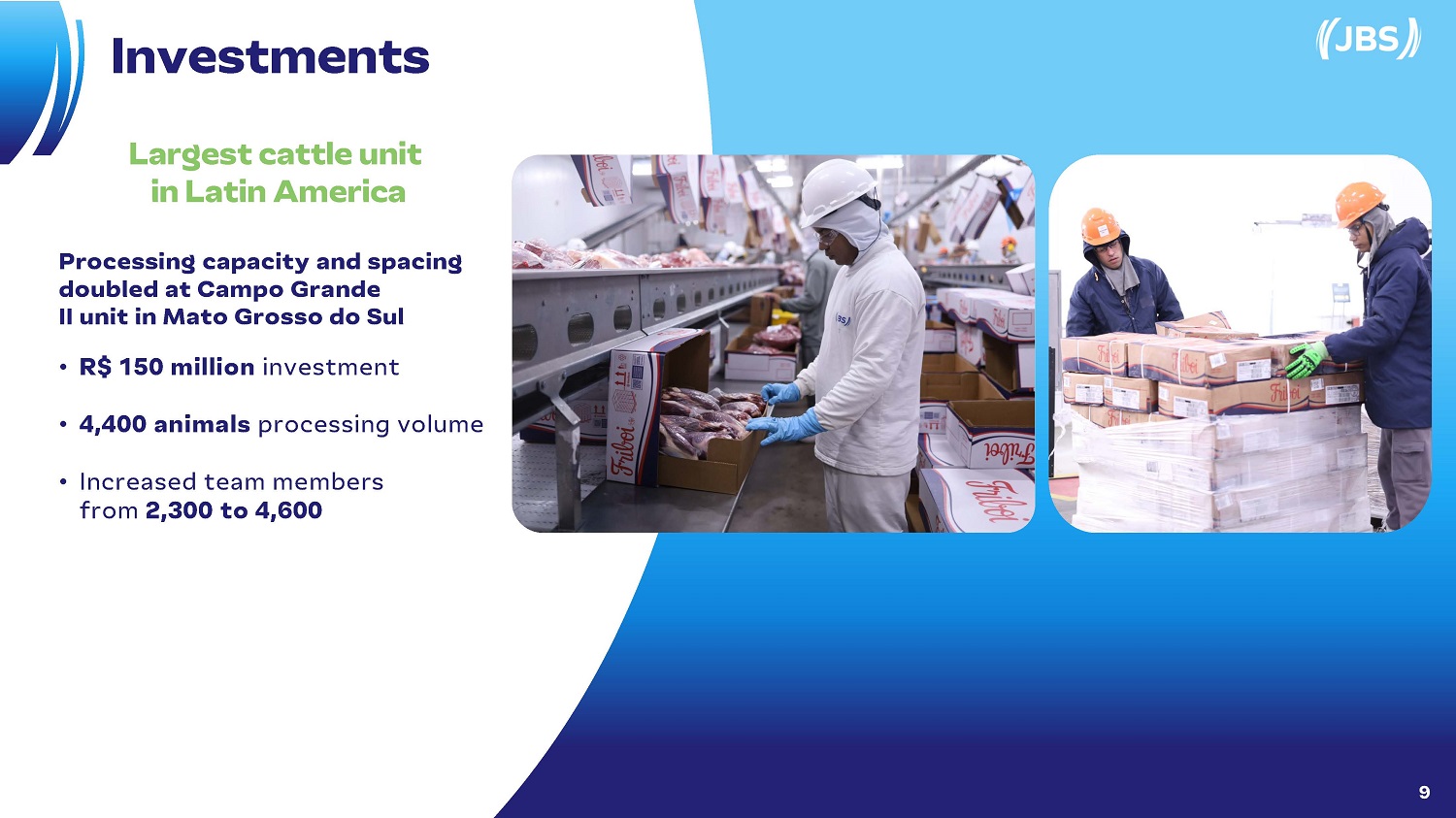
Investments Largest cattle unit in Latin America Processing capacity and spacing doubled at Campo Grande II unit in Mato Grosso do Sul • R$ 150 million investment • 4,400 animals processing volume • Increased team members from 2,300 to 4,600 9
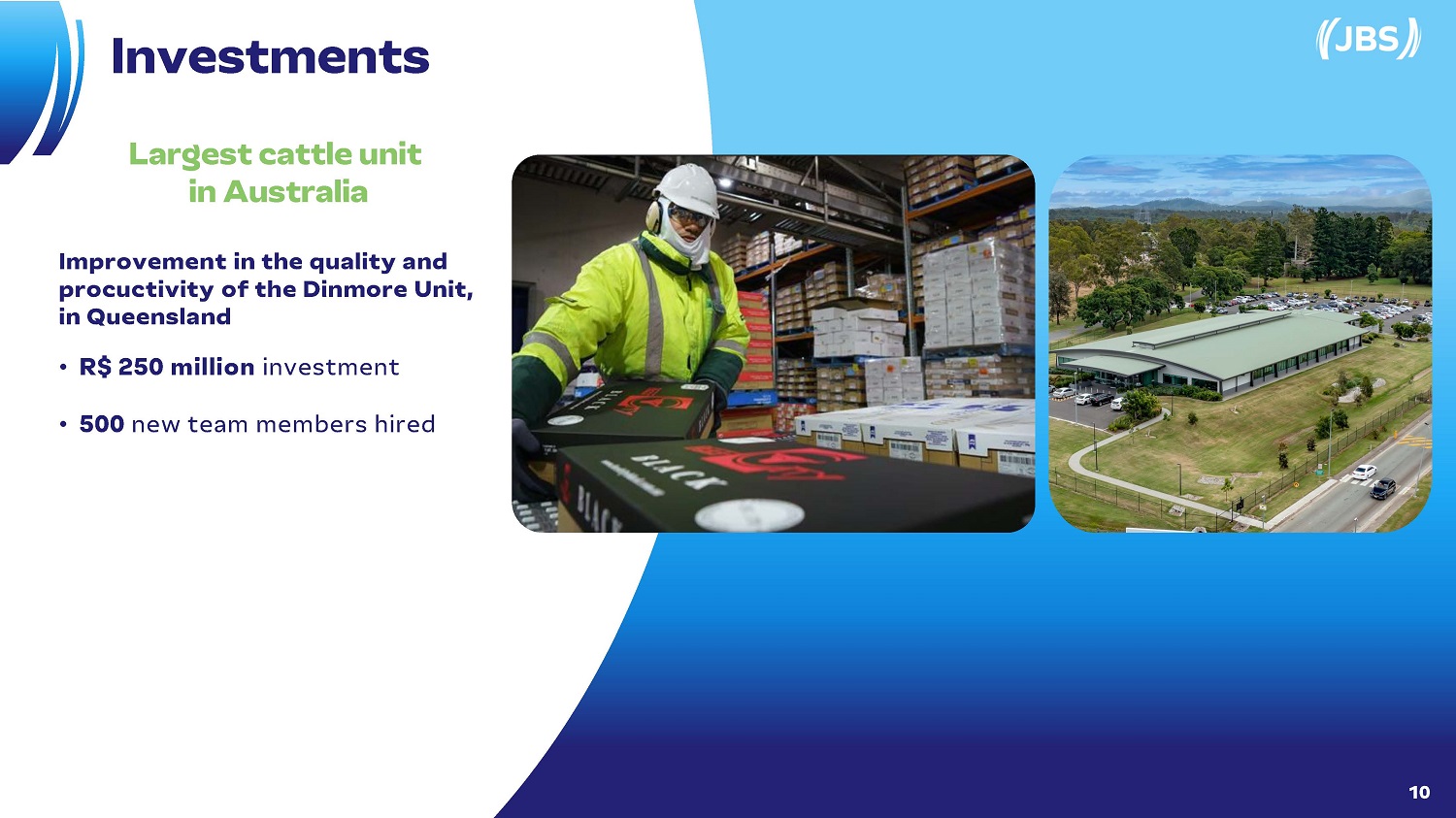
Largest cattle unit in Australia Improvement in the quality and procuctivity of the Dinmore Unit, in Queensland • R$ 250 million investment • 500 new team members hired Investments 10
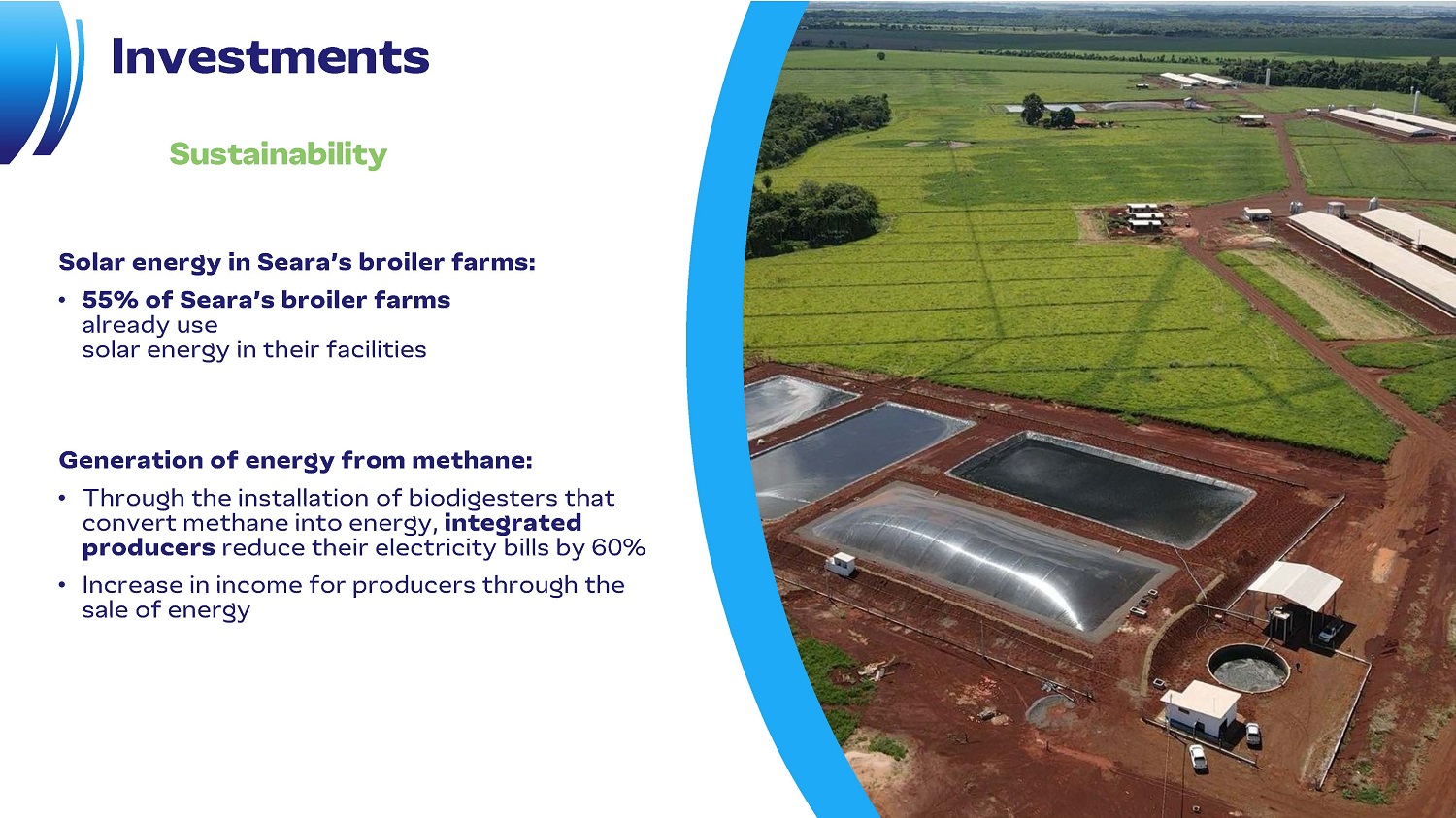
Investments Sustainability Solar energy in Seara’s broiler farms: • 55% of Seara’s broiler farms already use solar energy in their facilities Generation of energy from methane: • Through the installation of biodigesters that convert methane into energy, integrated producers reduce their electricity bills by 60% • Increase in income for producers through the sale of energy

Through the Beyond Borders program, the Company offers its team members the opportunity to internationalize their professional careers by changing roles or extending their knowledge to another country, strengthening JBS's organizational culture worldwide. 12 Instituto J&F Over 900 students enrolled in the education center, preparing young people for business. Better Futures Tuition - free community college tuition for JBS team members and their dependents. More than 6,000 people signed up. Instituto J&F MASTER Continuous training program for team members on the front line of production. Hometown Strong Community investment projects that support the communities where JBS is located through cash donations, infrastructure improvements and affordable housing. Social JBS projects around the world Beyond Borders Nourishing dreams, generating possibilities
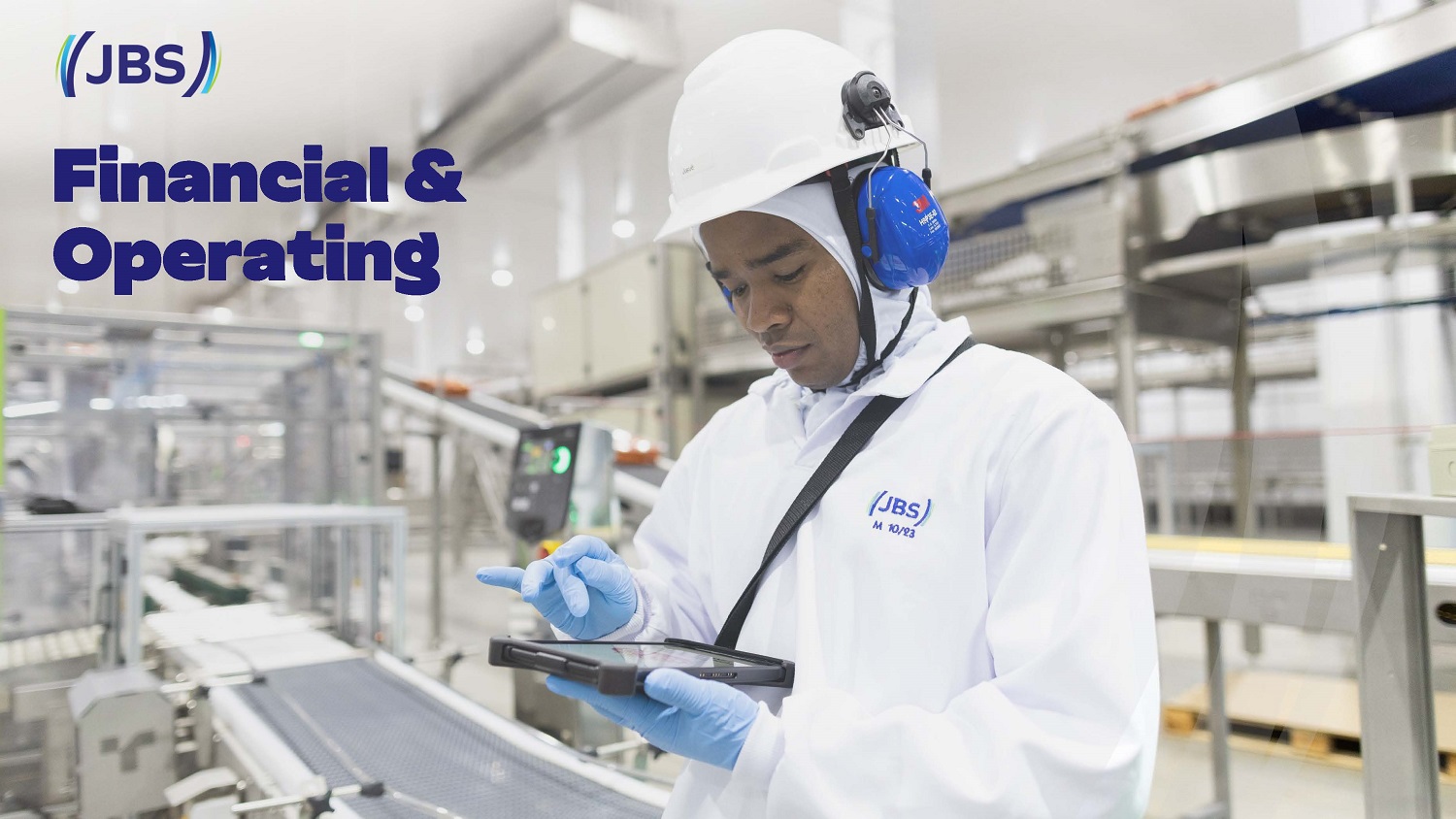
Financial & Operating
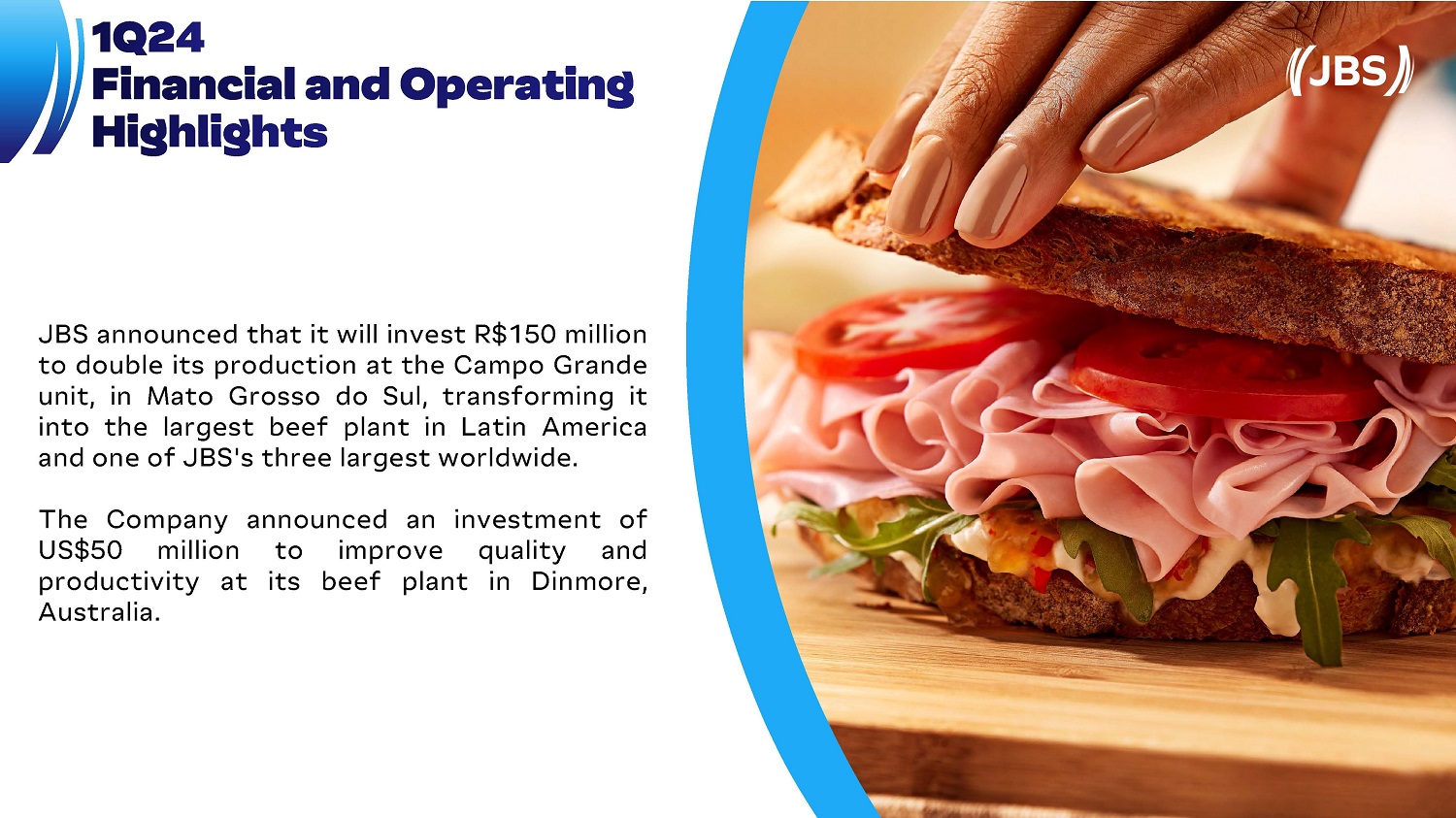
JBS announced that it will invest R $ 150 million to double its production at the Campo Grande unit, in Mato Grosso do Sul, transforming it into the largest beef plant in Latin America and one of JBS's three largest worldwide . The Company announced an investment of to improve quality and its beef plant in Dinmore, US$50 million productivity at Australia.
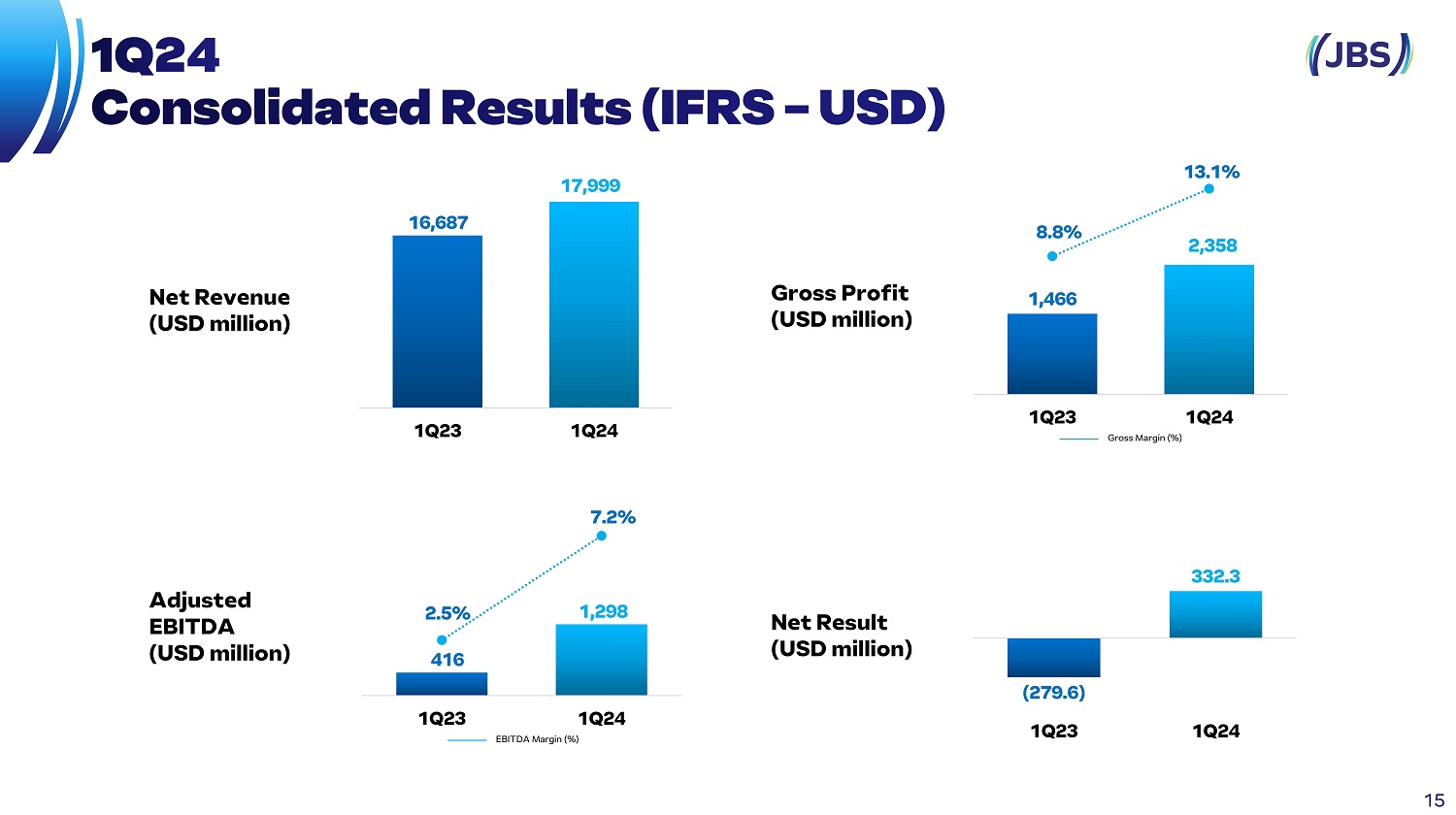
(279.6) 1Q23 332.3 1Q24 16,687 17,999 1Q23 1Q24 1,466 2,358 8.8% 13.1% 1Q23 1Q24 Gross Margin (%) Net Result (USD million) Adjusted EBITDA (USD million) 416 1,298 2.5% 7.2% 1Q23 1Q24 EBITDA Margin (%) Net Revenue (USD million) Gross Profit (USD million) 15
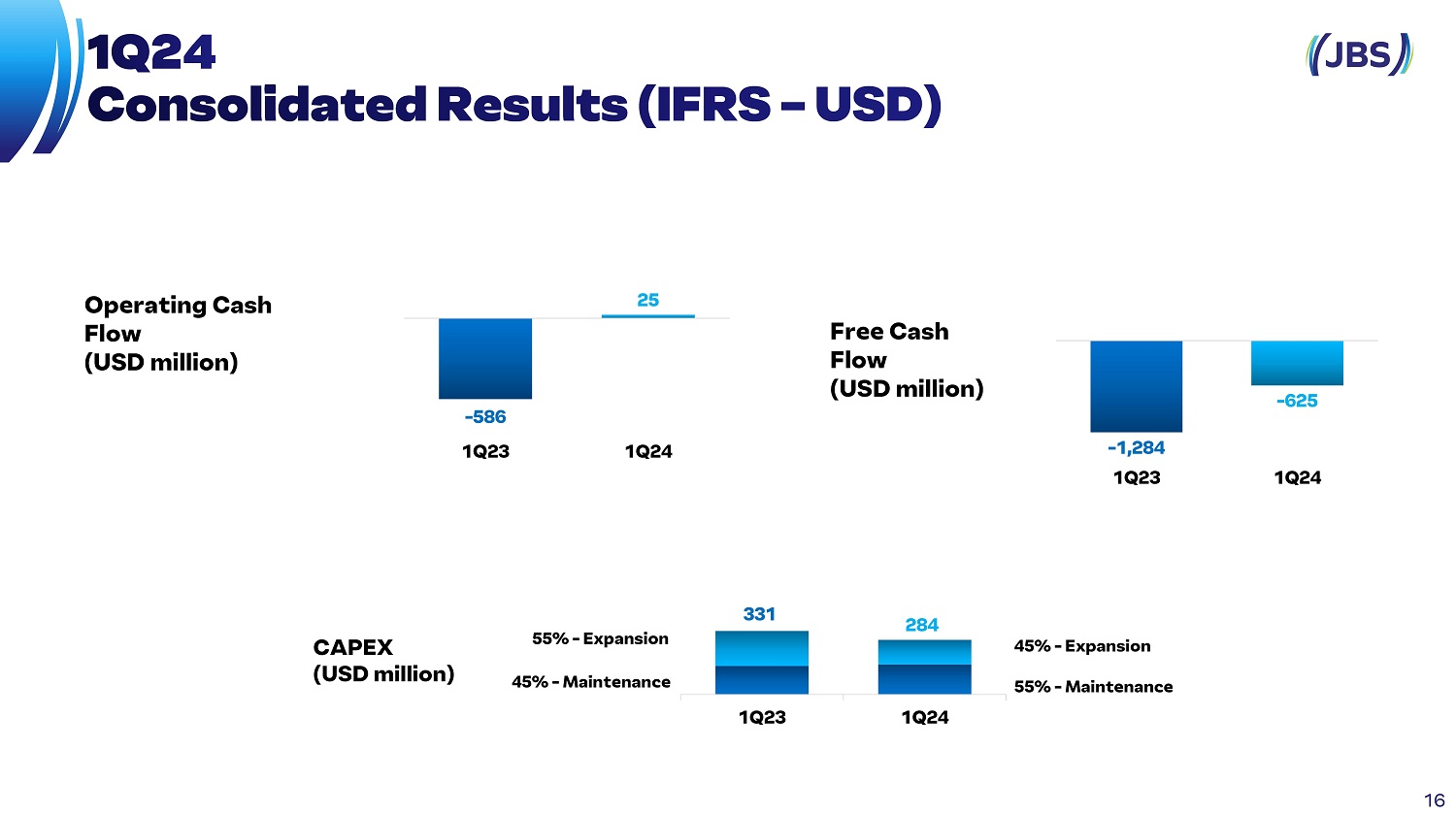
Operating Cash Flow (USD million) Free Cash Flow (USD million) - 586 1Q23 25 1Q24 331 284 1Q23 1Q24 - 625 - 1,284 1Q23 1Q24 55% - Maintenance 45% - Expansion 45% - Maintenance 55% - Expansion CAPEX (USD million) 16
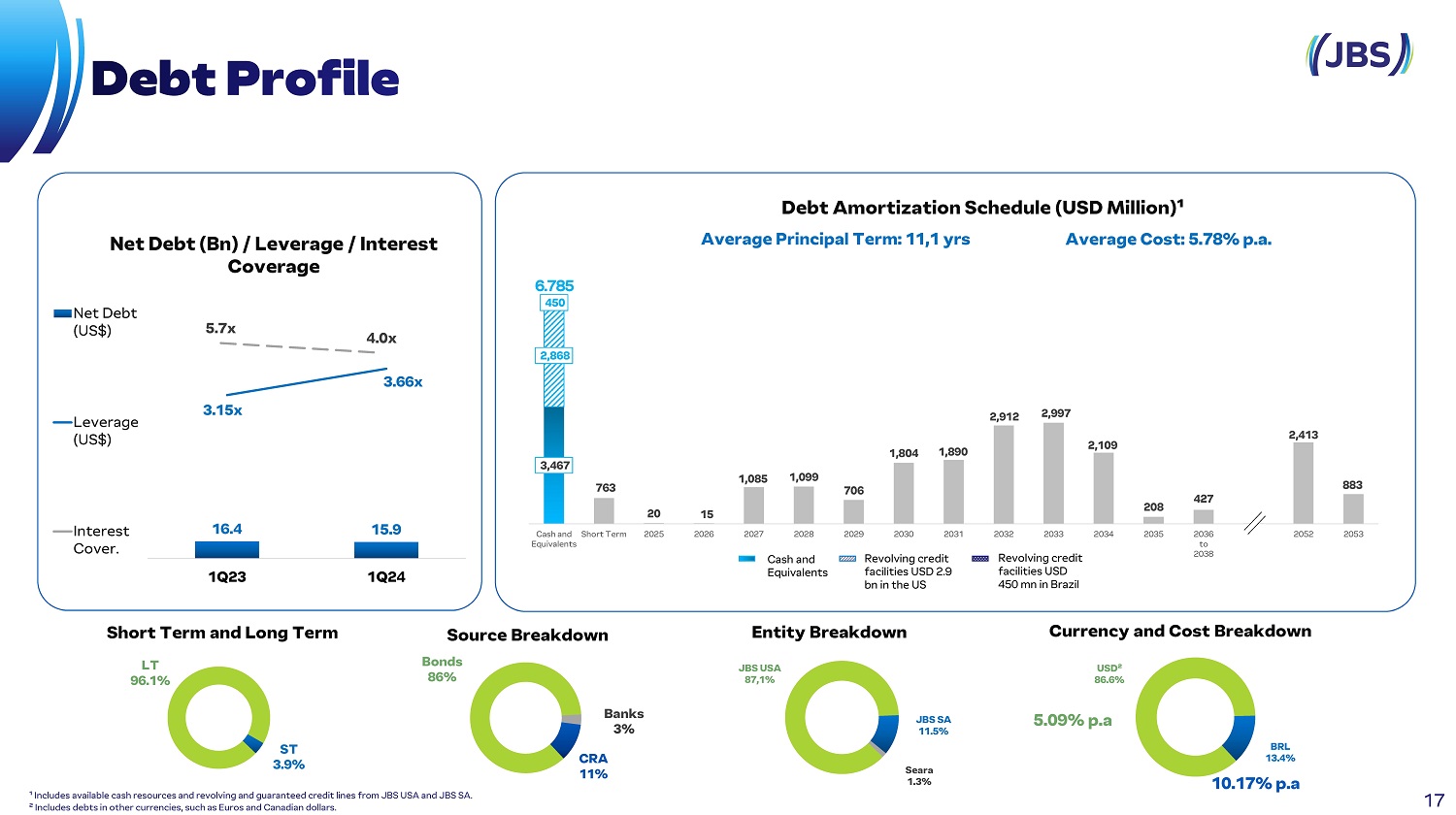
5.7x 4.0x 16.4 15.9 3.15x 3.66x 1Q23 1Q24 Net Debt (US$) Leverage (US$) Interest Cover. 763 20 15 1,085 1,099 706 1,804 1,890 2,912 2,997 2,109 208 427 2,413 883 2,868 3,467 450 Cash and Short Term Equivalents 2025 2026 2027 2028 2029 2034 2035 2036 to 2038 2039 to 2051 2052 2053 ¹ Includes available cash resources and revolving and guaranteed credit lines from JBS USA and JBS SA. ² Includes debts in other currencies, such as Euros and Canadian dollars. Net Debt (Bn) / Leverage / Interest Coverage Debt Amortization Schedule (USD Million)¹ Average Principal Term: 11,1 yrs Average Cost: 5.78% p.a. Entity Breakdown Currency and Cost Breakdown Short Term and Long Term LT 96.1% ST 3.9% Source Breakdown Bonds 86% Banks 3% CRA 11% JBS USA 87,1% JBS SA 11.5% Seara 1.3% USD² 86.6% BRL 13.4% 5.09% p.a 10.17% p.a Cash and Equivalents 2030 2031 Revolving credit facilities USD 2 . 9 bn in the US 2032 2033 Revolving credit facilities USD 450 mn in Brazil 17
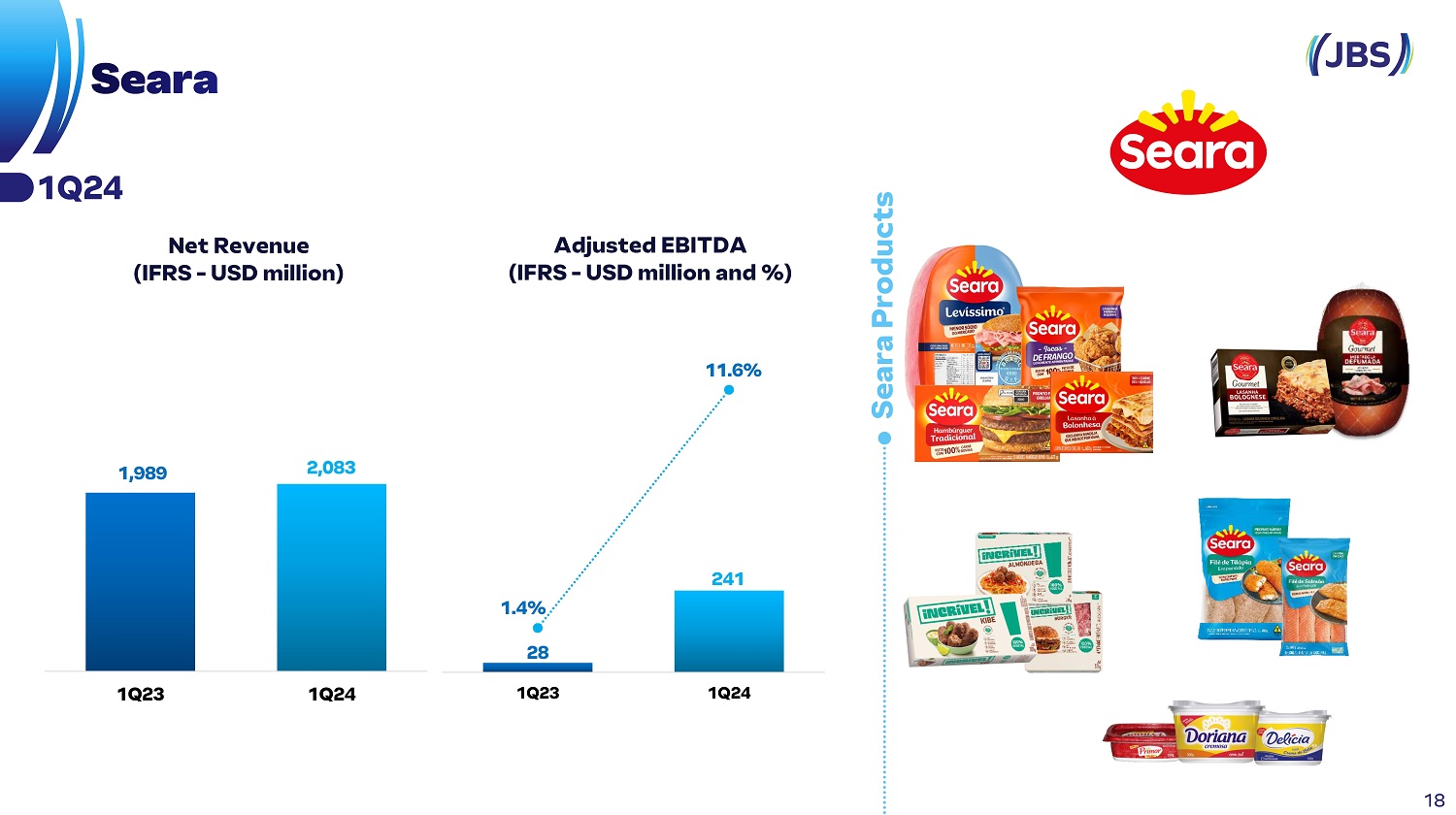
241 1.4% 28 11.6% 1Q23 1Q24 1,989 2,083 1Q23 1Q24 Seara Products Net Revenue (IFRS - USD million) Adjusted EBITDA (IFRS - USD million and %) 1Q24 18
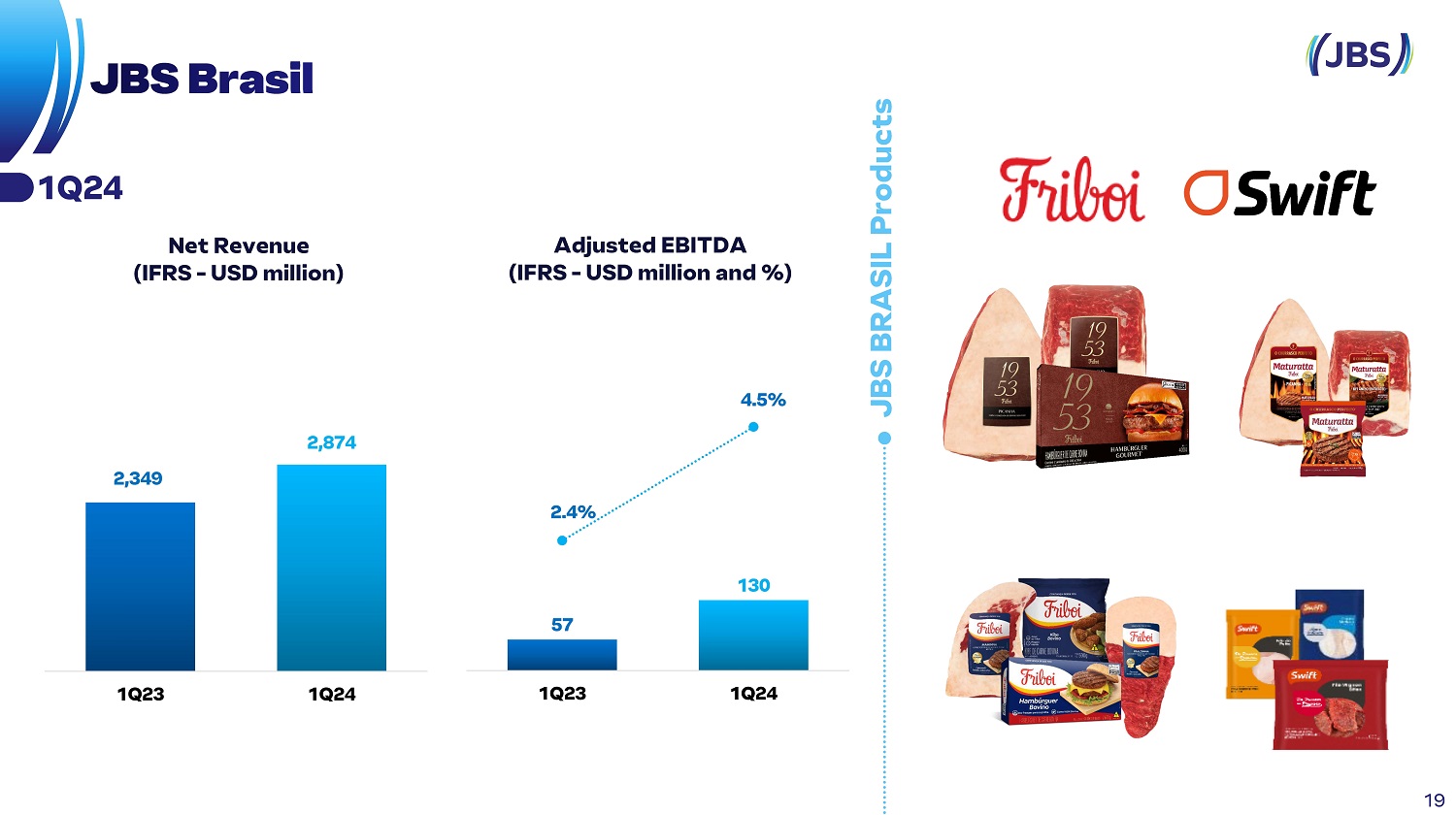
JBS BRASIL Products 57 130 2.4% 4.5% 1Q23 1Q24 2,349 2,874 1Q23 1Q24 Net Revenue (IFRS - USD million) Adjusted EBITDA (IFRS - USD million and %) 1Q24 19
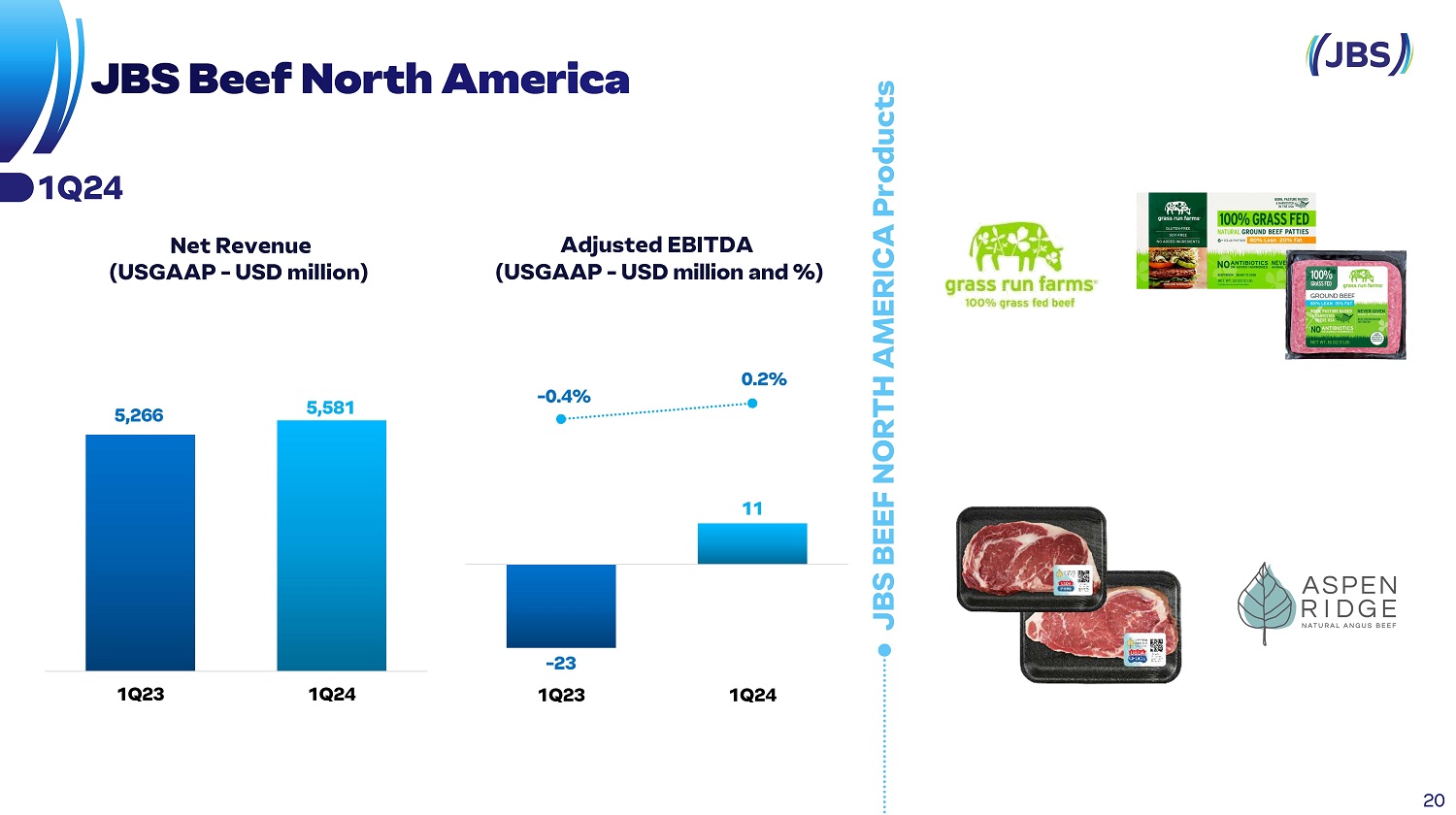
5,266 5,581 1Q23 1Q24 - 23 1Q23 11 - 0.4% 0.2% 1Q24 JBS BEEF NORTH AMERICA Products Net Revenue (USGAAP - USD million) Adjusted EBITDA (USGAAP - USD million and %) 1Q24 20
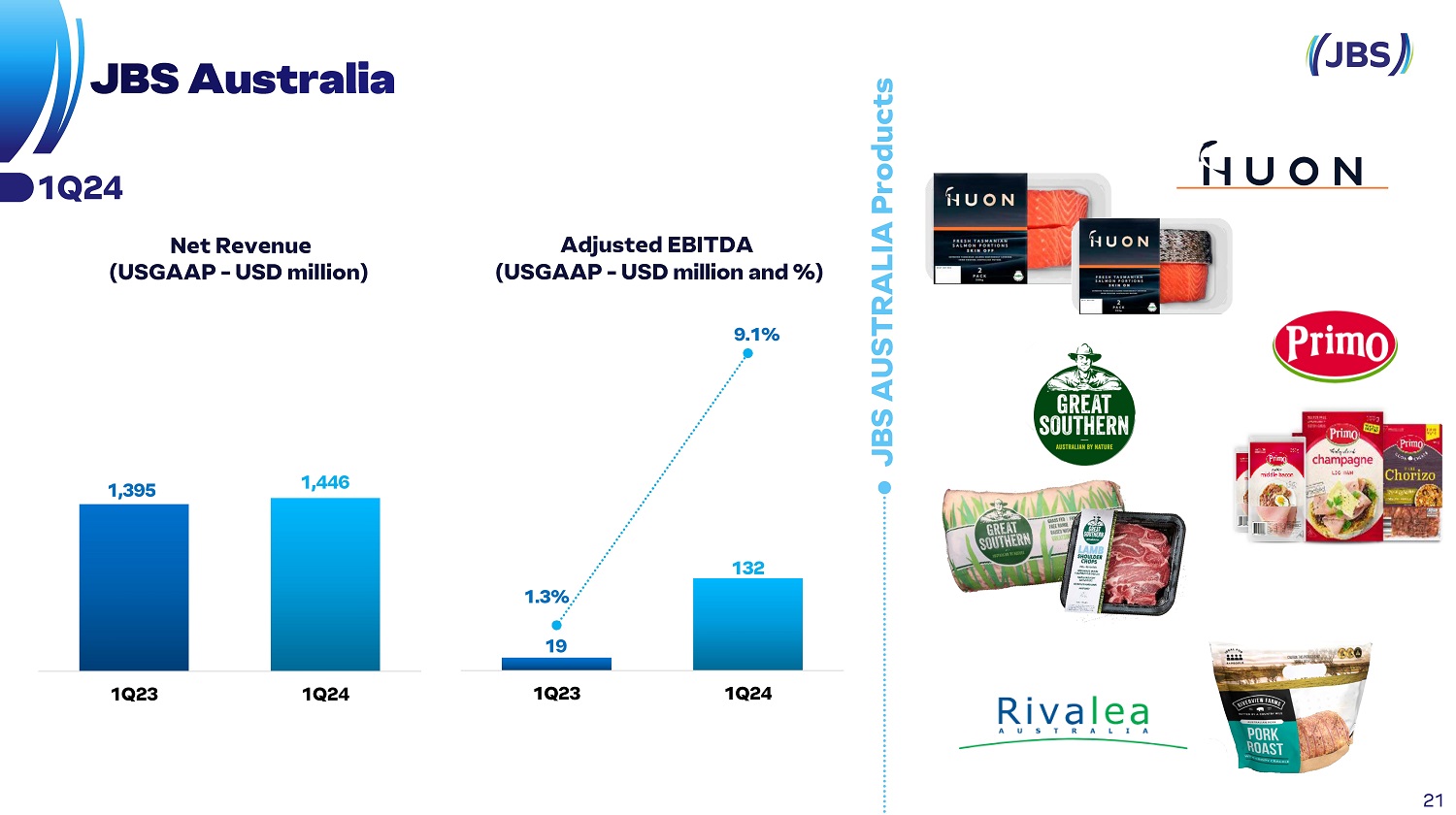
JBS AUSTRALIA Products 19 132 1.3% 9.1% 1Q23 1Q24 1,395 1,446 1Q23 1Q24 Net Revenue (USGAAP - USD million) Adjusted EBITDA (USGAAP - USD million and %) 1Q24 21
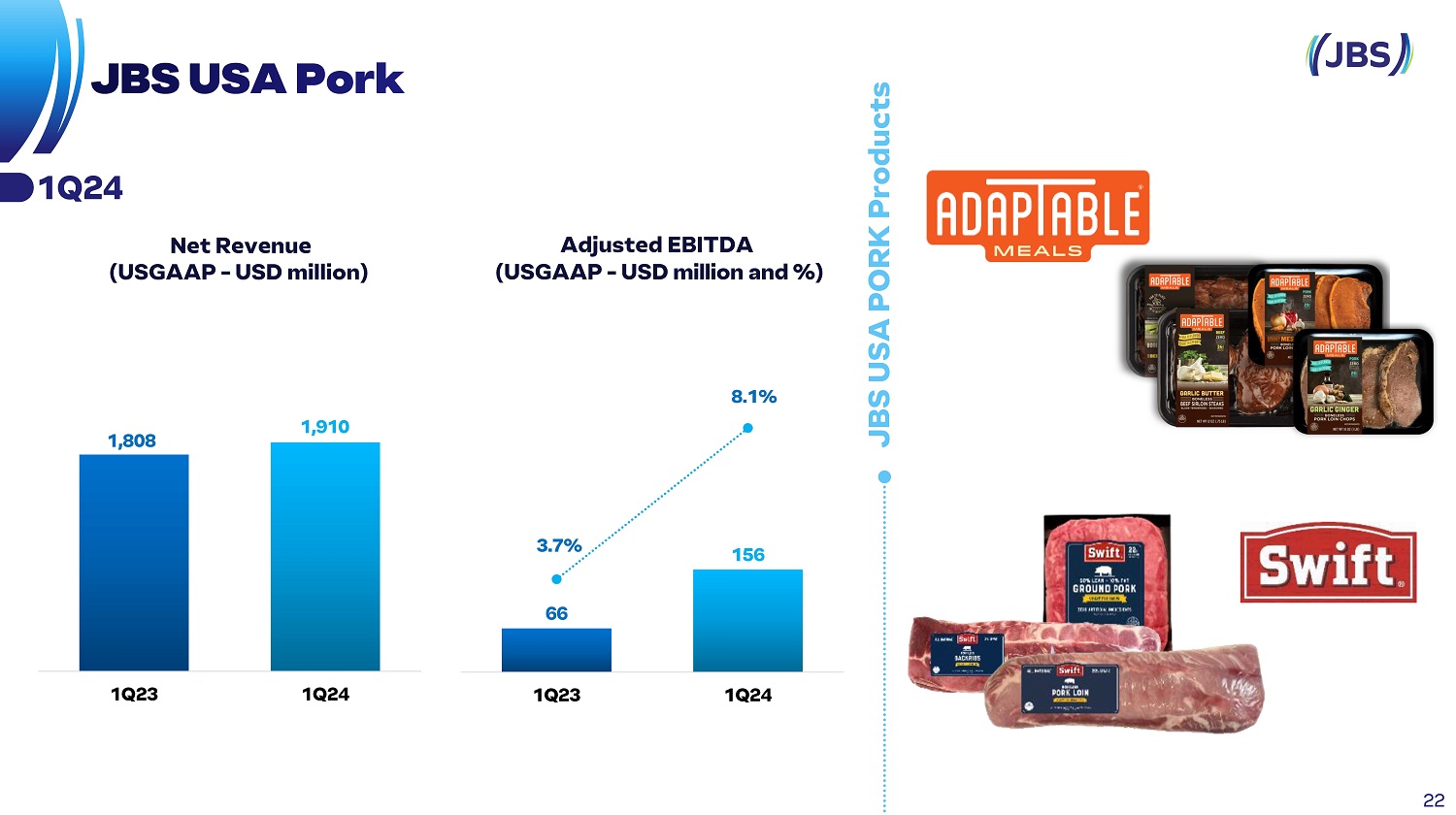
66 156 3.7% 8.1% 1Q23 1Q24 JBS USA PORK Products 1,808 1,910 1Q23 1Q24 Net Revenue (USGAAP - USD million) Adjusted EBITDA (USGAAP - USD million and %) 1Q24 22
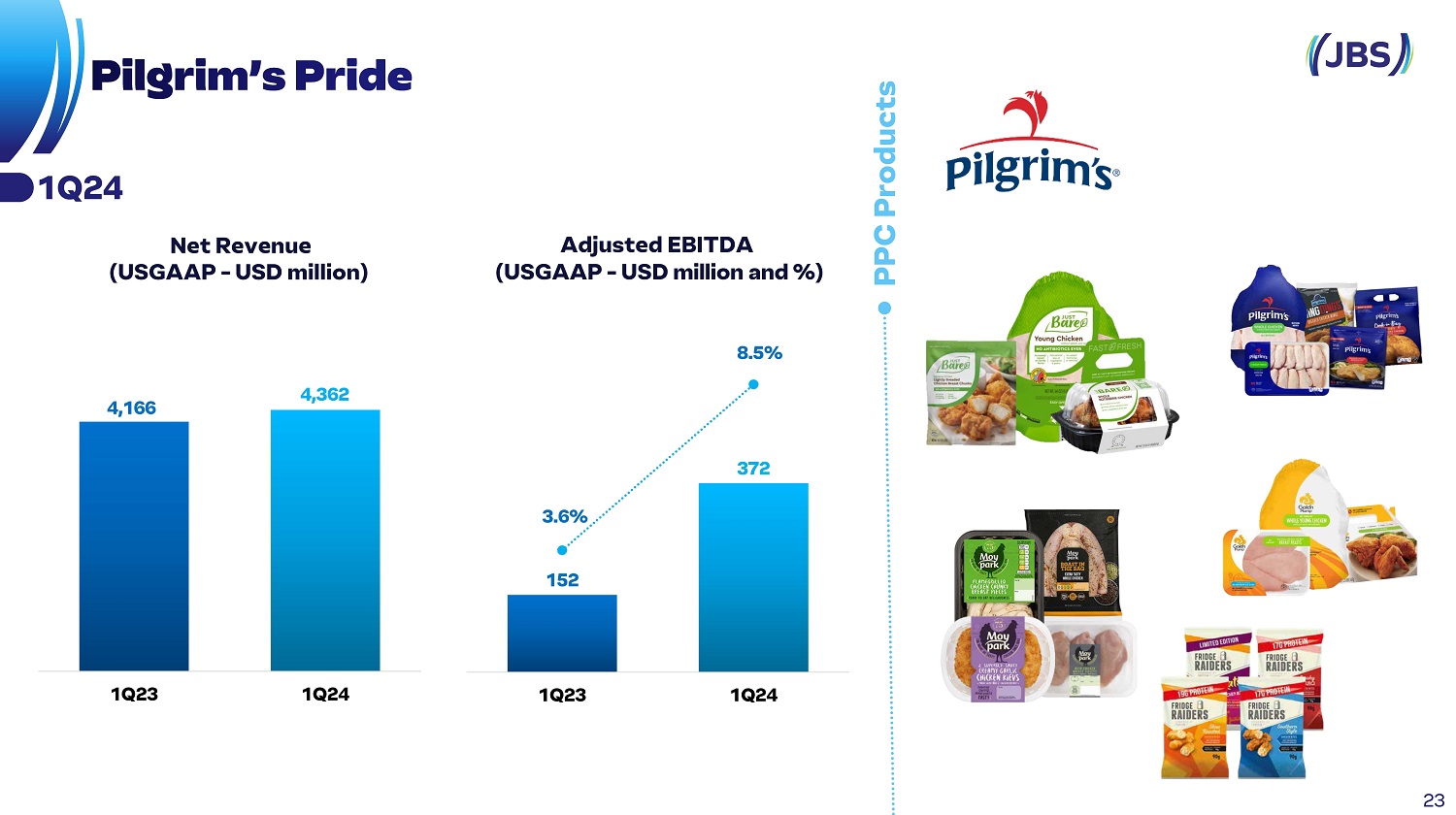
4,166 4,362 1Q23 1Q24 152 372 3.6% 8.5% 1Q23 1Q24 PPC Products Net Revenue (USGAAP - USD million) Adjusted EBITDA (USGAAP - USD million and %) 1Q24 23
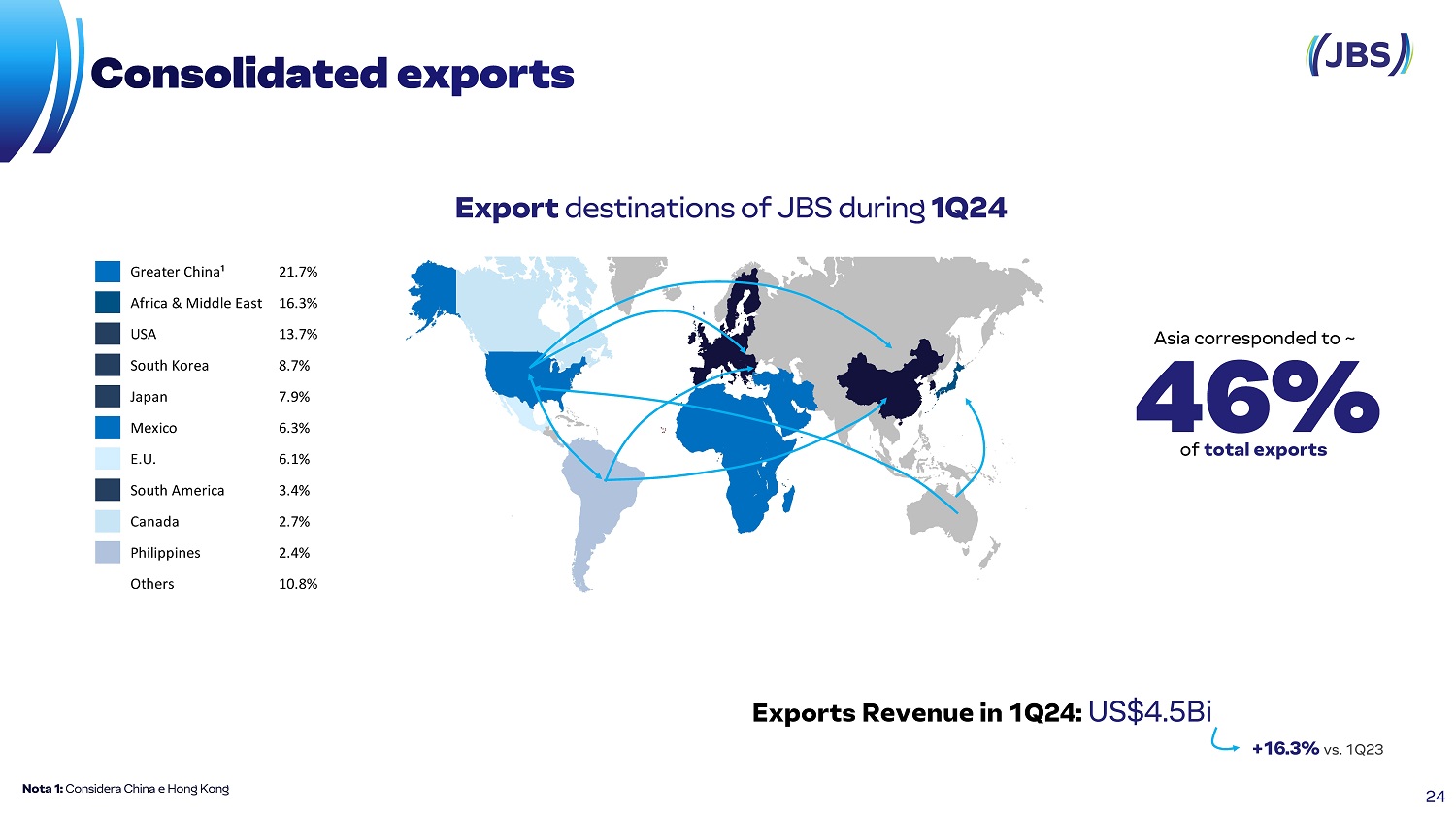
24 Nota 1: Considera China e Hong Kong Export destinations of JBS during 1Q24 Exports Revenue in 1Q24: US$4.5Bi +16.3% vs. 1Q23 Asia corresponded to ~ 46% of total exports 21.7% Greater China¹ 16.3% Africa & Middle East 13.7% USA 8.7% South Korea 7.9% Japan 6.3% Mexico 6.1% E.U. 3.4% South America 2.7% Canada 2.4% Philippines 10.8% Others
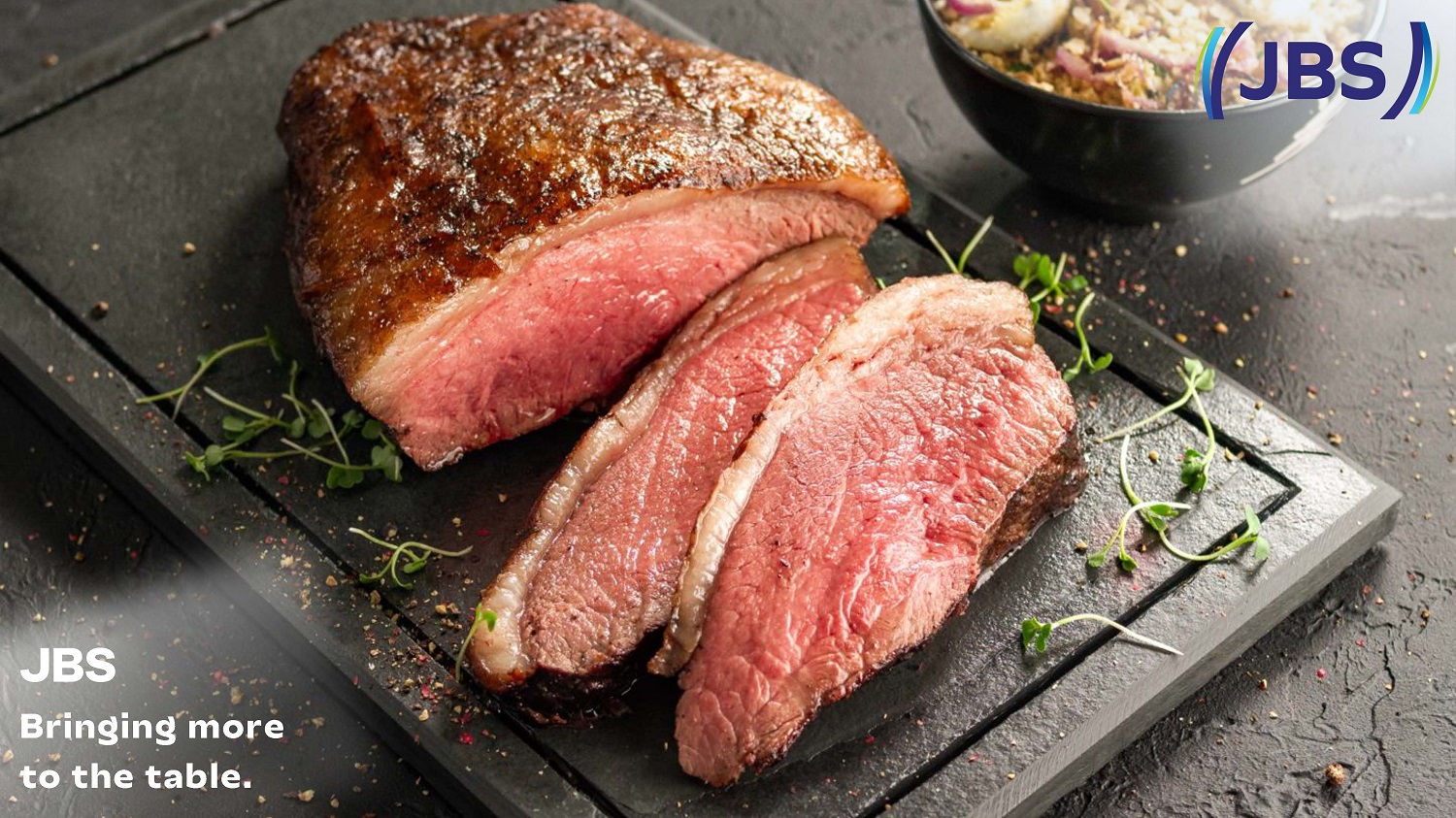
JBS Bringing more to the table.
Exhibit 99.3

International Conference Call
JBS S/A (JBSS3)
1Q24 Earnings Results Transcription
May 15th, 2024
Operator: Good morning. Welcome to the
conference call of JBS S/A and JBS USA to announce their results of the first quarter of 2024. At this time, all participants are in listen-only
mode. Later, we will conduct a questions and answer session and instructions will be given at that time.
As a reminder, this conference is being recorded.
Any statements made during this conference call relative to the company’s business outlook, projections, operational and financial targets
and goals, and growth potential are merely forecasts based on the company’s management expectations in relation to the future of JBS.
Such expectations are highly dependent on market
conditions, on Brazil’s overall economic performance, on the industry and international markets and therefore are subject to change.
Today here with us we have Mr. Gilberto Tomazoni,
Global CEO of JBS, Guilherme Cavalcanti, Global CFO of JBS, Wesley Batista Filho, CEO of JBS USA, and Christiane Assis, Investor Relations
Officer.
Now I would like to turn the conference over to
Mr. Gilberto Tomazoni, who’s going to start the presentation. Mr. Tomazoni, please, you may start.
Gilberto Tomazoni: Good morning, everyone.
Thank you so much for attending our result conference call.
Before delving into the results, I would like
to take the opportunity to express my sympathy towards the victims of the catastrophe caused by the rains in Rio Grande do Sul, especially
to our more than 16,000 team members in the state. The world has been following the situation with sadness and dedication of our entire
team has been essential in helping our team members, partners, along with their families and impacted communities to recover.
Once again, I would like to express my deepest
admiration and gratitude to the extraordinary work that everyone has been doing to offer support during this tragic event. As a company,
we are mobilized to provide donations of essential items for assistance to people in the region, such as food, hygiene, cleaning products,
water, clothing, and blankets.
Now, back to our financials, JBS had a solid first
quarter in the first quarter of 2024. These numbers reinforce that we are on a path of recovery, as we have been indicating to you in
recent quarters. We have added almost 2 percentage points to our consolidated EBITDA margin as compared to the fourth quarter of 2023.
As to the first quarter of 2023, we have reached a margin of 7.2 in a period increasing by 470 basis points.

I would like to highlight the result of Seara,
which delivered double-digit margins in the first quarter already. Its focus on operational excellence is reflected in a significant evolution
of the business margins, which went up from 6.4 in Q423 to 11.6 in Q12024. So, closing the gap of part of the operational gaps and the
cost of grains going back to normal and the growth in volumes, especially in domestic market, reinforce the promising prospects for Seara
this year.
We keep our focus on the pursuit for the preference
of consumers and to capture operational opportunities. Our focus on key customers, brand growth and consolidation of our business in Europe,
and a pursuit for operational excellence are reflected in the strong result of Pilgrims. The business margins had a significant increase
going up from 6.5 in Q1 2023 to 11.5 in Q1 2024.
USA Pork margins grew from 2.5 to 16.4 in the
same period. Our poultry and pork businesses have benefited from the reduction in grain prices, as well as a rebalance in supply and demand.
I would like to highlight that our results are very robust, and once again, this reinforces the importance of our diversification of geographies
and proteins.
In a quarter that is traditionally weaker for
the global protein industry, cattle businesses in Brazil and Australia captured the results of the high cycle in these two countries,
whereas JBS Beef North America goes on with weaker margins as a result of the cattle raising cycle and seasonal conditions, as we had
indicated before.
Once again, I would like to stress our financial
solidity. In the first quarter of 2024, we reached a net income of R$1.6 billion with a net revenue of R$89.1 billion and adjusted EBITDA
of R$6.4 billion. Our priority is still to deleverage a process that has consolidated.
This rate had a reduction of 4.42 times in US
dollars in Q1 2023 and now it’s down to 3.66 times in Q1 2024. If we use the numbers of this quarter as a reference, which is one
of the weakest quarters in the industry, and if we abstract mathematically, we use this information, we will close the year with 2,5 times
our leverage.
And I would like to reinforce this is not a guidance,
this is just a mathematical abstraction that we use as a reference the margins that we had in the first quarter of this year.
The numbers of this quarter reinforce our trust
in the JBS long-term strategy focusing on the expansion of our global multi-protein platform and on the consolidation of our strong brand
portfolio and high-value-added products. In that sense, along recent quarters, we have made several investments that will start to provide
good fruit.
In the Brazilian state of Mato Grosso do Sul,
this year we are going to open Dourados, and industrial or manufacturing complex, a new processing plant for swine in natura, and another
for prepared foods. We also announced that in April we are going to double our capacity in our bovine plant in the Campo Grande in the
same state, one of the units had just been licensed to export to China.

In Jeddah, in Saudi Arabia, we are finalizing
our third plant for halal products. In San Sebastian, in Spain, we are going to start the operations of our cultivated protein plant and
Biotech Foods. We’ll focus on what we can control to become increasingly more competitive in the different markets where we operate. For
this reason, we have absolute focus in cost management, increasing productivity, optimizing our mix, focusing on opportunities in market
and price asymmetries regardless of the geography and economic variations.
We are confident that the strength of our platform
added to our financial soundness and our commitment to excellence innovation will enable JBS to move towards its trajectory of growth,
adding value to all our stakeholders and the communities where we operate.
Once again, I thank you very much for being in
our conference call. And now I give the floor to Guilherme, who’s going to give you details about our numbers. Guilherme, please.
Guilherme Cavalcanti: Thank you, Tomazoni.
Now let’s go to operational financial highlights starting on slide 15. The net revenue was R$89 billion or US$18 billion. The adjusted
EBITDA, R$6.4 billion or US$1.3 billion. This represents a margin of 7.2% of the quarter. Net profit was R$1.6 billion, or US$332.
And now moving to the next slide, the operating
cash flow in the quarter was R$122 million, or US$25 million. This cash flow in the quarter was negative at US$622 million, or 3.1 billion.
As we anticipated in our last earnings conference call, we estimated the cash consumption would be half of the amount reported in the
same period in the year, which happened.
Despite this cash consumption, which is common
for the first quarter due to the seasonality of the period, this is explained by the increase in results in practically all our business
units. CAPEX in the quarter was R$1.4 billion or US$284 million, 55% maintenance CAPEX. This amount is 18% lower than Q123, which is in
line our estimates of US$1.3 billion.
Now moving to slide 17, the net debt ended at
US$15.9 billion, reflecting an increase of US$569 million as compared to the previous quarter, variations explained by the cash burn,
considering the typical seasonality of this time of this year. The leverage in dollars went down from 4.42 to 3.66 times in BRL and 4.32
to 3.70 in US dollars in a quarterly comparison, thereby confirming that they leverage. In the second quarter this year, we are expecting
another significant drop in this indicator to about 3 times.
Now, conducting a leverage exercise and not considering
the guidance for us to reach a leverage of 2.5 times at the end of the year, our consolidated margin in 2024 should be close to 7.5%,
considering that the first quarter is seasonally weaker, and the margin was already 7.2%, it’s reasonable to think at this level of leverage
for the end of the year, thereby staying within our policy of being between 2 and 3 times our net debt along the year.

We reduced our net debt by US$666 million in the
first quarter, especially due to the payment of short and long-term bank debts. We are going to reduce our gross debt in the second quarter.
In this manner, now I’m going to go over each
one of our business units. Starting with Seara on slide 18, the net revenue in the quarter was stable as compared to the same period in
the year before, US$10.3 billion or US$2.1 billion. However, as we had said, the profitability has already gone back to normal two-digit
levels. This improvement is a result of intense focus on operational excellence, management team, cost reduction, specialty grain, better
offer and demand balance, and maturation of new plants. And EBITDA margin grew more than 10 percentage points year on year, reaching 11.6%
in Q124.
Now on slide 19, JBS had a net revenue 17% higher
than Q123 driven by higher volume sold. The favorable capital cycle had a positive impact in sales volumes both in Brazil and internationally
due to the high availability of animals for slaughter. This cycle has also contributed for the reduction of cattle prices bought and as
a consequence had a positive impact on profitability.
On slide 20 – and now dollars USGAAP –
net revenue in US JBS Beef North America grew 6% year and year. Profitability is still pressured, considering a more challenging cattle
cycle because the price of living animals went up more than wholesale.
JBS Australia, we have higher volume sold, both
in the domestic and international markets. The growth and profitability year on year reflected especially the higher availability of cattle
in the market, considering a more favorable cattle cycle and efficiency gains in many business areas in Australia.
Now, JBS USA Pork, the net revenue was 6% compared
to Q123 because of the average prices on the period. In addition to better commercial dynamics, the profitability was positively impacted
by lower grain costs, a drop in average price of swine in Q124 and continual efforts aiming to expand the value-added portfolio in addition
to better commercial execution, operation and logistics too.
So, Pilgrim’s Pride had an increase in net revenue
of 5%. The first quarter showed the results of this strategy, making it possible for the company to grow compared to the market. The product
portfolio with this brand contributed to diversification and still expanding.
As you can see, the results of the first quarter
are very exciting, as we had indicated in our more recent conference calls, and we are optimistic in our deleveraging trajectory and cash
generation for the year.
Now we are going to open for questions and answers.

Question and Answer Session
Operator: Ladies and gentlemen, we are
going to start now our Q&A session. To ask a question, please use the raise hand option. To withdraw it from the list, click lower
hand.
Our first question comes from Isabella Simonato,
Bank of America.
Isabella Simonato: Hello, good morning
Tomazoni and Guilherme. Congrats on the results. I have two questions. The first one is about Seara. We can see, of course, the market
reality, as you’ve pointed out, it is really favorable for the future ahead. And I’d like to know your vision about the external market
for poultry.
We’ve seen some markets performing at price levels
above the average, and now you’re going to have a new plant in Saudi. I would like to hear from you about the external market for poultry
considering Seara’s reality.
The second question concerns the US cycle. The
landscape is still quite challenging, but please tell us a little bit about the beginning of the cycle of the quarter and how you’ve been
analyzing the seasonality for the second and third quarter of the year. Thank you.
Wesley Batista: Good morning, Isabella.
I’m going to start talking about our beef business in US. We expect normal seasonality this year, but weaker than it had been last year.
There is less availability of beef, of cattle. We’ve seen that in the first quarter, about 3% drop of our slaughter, even more than that,
13% in the decrease of cow slaughter, very relevant as you can see.
The demand is more restrict because of inflation.
The price of cattle is higher, the second quarter will have the natural seasonality, with now spring and summertime in the US we may expect
better margins, but it is going to be more challenging than it had been last year.
Gilberto Tomazoni: Isabella, thank you
very much for the question. Concerning poultry in the international market, as you pointed out, our perspective for this business is very
positive for two main reasons: First, we can see more interest for poultry protein in all different markets. US, for example, the USA,
we can see that, and also other international markets. Globally speaking, there is an increased demand for poultry. In addition, the protein
offer is very well balanced, and it has been a challenge, of course, to manage our new genetic lineage that have been developed.
For all different markets and producers, they
are managing that increased productivity based on genetic handling. And you can see, for example, that in the USA, the FDA they are showing
a smaller growth of poultry production. And they have been still having an increased demand.
So, it’s a positive demand all over. That’s the
fact.

Isabella Simonato: Thank you, Tomazoni.
If I can have a follow-up on my question, thinking about regionally and your exposure to the Middle East, what is your outlook there?
Maybe you could increase your market share in the region. And thinking about the new plan, are you thinking about changing your external
market mix?
Gilberto Tomazoni: Well, in Saudi Arabia,
we have very great perspectives. We have two plants, we’ve started developing now our third processed food plants, where we are developing
the brand Seara, especially in retail. The market in the region has been very promising, with high demands. It’s a market also benefit
by the Turkey’s decision to restrict part of the exports it used to do. Turkey used to be a very important player there.
Therefore, we have the focus of developing our
brand all over the region, we focused on Saudi Arabia using our branded added-value product, but we also provide services through food
service also at higher volumes.
Middle East and Asia are extremely relevant markets
to Brazil and Seara is just surfing the same wave. Great.
Isabella Simonato: Thank you very much.
Operator: The next question comes from
Ricardo Alves, Morgan Stanley.
Ricardo Alves: Good morning, everyone.
Thank you very much for the opportunity. I have two brief questions to ask you, building up on what has already been asked, considering
North America Beef, this improvement of the first quarter compared to the fourth quarter 23, was great to see. But when we think about
the second quarter and what Wesley has just said that it’s going to be probably a harder second quarter than previously because of the
whole cycle, livestock cycle.
But thinking about the cutout side, how do you
see that delay in reacting of cutout? We’ve been seeing that the fat cattle price had been impacting the market, it seems that there is
something really bringing down the prices. But do you have any information about higher inventory levels or something like that?
And do you also expect to have a recovery on prices
in a seasonality perspective? We believe so, but we would just like to know if there is anything else that you know, that you’ve been
observing in the market that would impact demand and the price of cutout going from less of cattle and more into beef offer.
For Seara, I would just like to understand whether
we can quantify the sequential improvement of margin, mostly it has come from grain, but does it also have operational adjustments? Have
you been streamlining some of your plants? Just to understand how much of that margin benefit has derived from commercial pricing adjustments
or operational improvement.
And finally, the last question for US pork, is
there still room for your top line to be increased? It’s been great to see that historical range, we like to see stability, but do you
think there is a potential of increasing the top line? China has adjusted its production of pork, so maybe even for exports, the perspective
of US pork can be even better. So that’s it. Thank you very much.

Wesley Batista: Good morning, Ricardo.
Starting about our beef cattle in US, comparing to the same period last year, we’ve observed a delayed demand, but it’s coming into the
market. We can see it now Memorial Day coming, which is a very important holiday in the US for the second quarter. So we’ve been seeing
more activity than in the first part of the second quarter.
We strongly believe that it’s going to be a seasonal
movement but lagging behind somewhat compared to last year. But the current cutout, it’s not bad. Historically, the cutout as we have
today, somewhat below US$3 per pound, it’s not low. But of course, the impression that we have in terms of cost of cattle is very relevant
and compared to last year, it really applies pressure on the spread. But we are going to see that happening.
Something else about beef, the first quarter of
24 was much more challenging than the same period last year. If you analyze USDA data of spread, we can say that the spread was just half
of what it was last year. So the market margin was subject to much compression. And we’ve delivered better results than last year because
of internal improvements.
We’ve been talking about our own internal improvements
in our business, both commercially and industrially speaking. And I would estimate, and it’s important to say, that 2 percentage points
have already been captured, and we are looking for more. We know it’s going to be a very challenging year for beef cattle, but we believe
there are 2 more percentage points of margin to be captured regardless of market, regardless of cutout, price of cattle. We believe there
are still 2 more percentage points in addition to the 2% that we estimate that we have already captured. And I mean that regardless of
the market’s performance.
Now speaking about pork USA, yes, we believe there
is the potential there of increasing our top line. Please bear in mind that within pork business, it’s not only pork beef, but there are
also prepared food businesses, and we’ve made relevant investments of expanding our capacity, bringing new lines. There is a new plant
recently opened in Missouri for salami, prosciutto, Italian specialty of cuts. This is something that has a huge potential to grow.
It’s not going to be huge, of course, in terms
of added revenue, but in terms of adding value, our swine products can really get better. There is a line which is at maturity level,
our cooked bacon line, very much focused on food service. There is also an important performance in retail. So within our businesses of
prepared foods, we see a great potential of increasing top line.
Therefore, the cutout of pork also impact the
top line up or down, depending on the commodity in the market. I’m talking about adding value, because we can see a great possibility
of adding value and with that increasing top line.

Gilberto Tomazoni: Ricardo, this is Tomazoni
speaking. About Seara, you’ve asked us where it comes from in terms of margin improvement quarter over quarter. Margin improvement, as
I pointed out in my opening remarks, it has resulted from grain prices, we’ve been building up on that since the last quarter, in
this last quarter, we can say that mostly the benefit of grain prices have been fully captured. But there was another part resulting from
our operating improvements and that balance between supply and demand.
So it’s a combination of actions. What we are
going to see from now on won’t have a contribution from grain prices anymore because everything has already been absorbed within our cost
structure, but we are going to see that the potential of Seara is to keep on increasing margins, because only part of the operational
improvements that have been identified have already been captured.
Seara has a very long chain, and it takes some
time for improvements to reach the P&L. It takes time. We’re going to keep on seeing Seara with a potential to grow margins.
Ricardo Alves: Great, thank you very much
all of you. Thank you for the level of details. Have a nice day.
Operator: Our next question comes from
Leonardo Alencar, from XP. Leonardo, you may ask your question.
Leonardo Alencar: Good morning, everyone.
Thank you so much all the information about US beef, but I would like to follow up on that topic. Number one, what is your capacity utilization?
Because we are seeing an interesting dynamics. There’s a better demand in the quarter. It’s kind of late, but we see indication. It seems
that retail is carrying a lot of margin. In terms of slaughter, very high. And then we’re wondering if slaughter was lower, maybe the
margins would be better.
Could you tell us about this dynamics and then
talk about your strategies? But what catches the eye is that there is an increase in margins should be expanding faster, and you have
this tool in hand to adjust.
And thinking about JBS Brazil, there was a positive
surprise in terms of slaughter in Q1. Was there any room for higher slaughter and better cost management?
And the other question is related to your leverage
references and guidance. But in the 4Q quarter, there was an expectation of 3 times leverage for the end of this year and shortly afterwards.
You were talking about 2,5 times for the end of this year. So which are the other assumptions that may have changed from last quarter?
So thinking of 3 times for the second quarter, what should we expect in terms of EBITDA?
Wesley Batista: Leonardo, answering first,
the bovine business in US. Capacity utilization, well, yes, this is an estimate. We don’t know the market results, but we can see that
slaughter at the current level of 620, 600-something thousand heads per week, well, it’s well-balanced.

The US, it’s not a very, very high slaughter level.
It’s quite stable in terms of slaughter. It doesn’t surprise us. We can talk about the level of slaughter in the market because we might
be getting into our strategy, but we are seeing this in a very well-balanced way. It’s neither too much nor too little. Below that, the
capacity would be underused, and above that it’s more overworked during the week.
So it’s very well balanced, I don’t think
it’s either end of the scale, neither too much nor too little. So what has gotten better are the operational results.
Guilherme Cavalcanti: So in the first quarter,
we have an EBITDA of US$400 million in 2023, and now we have US$1,300 billion after one month and a half in Q2, so we are confident to
say that once again, our EBITDA is going to be higher. And moreover, after the second half of the year, we are going to have positive
free cash flow.
So the combination between having a higher EBITDA
and cash generation will drive leverage to get to 3 times in the second half, thereby advancing an EBITDA improvement, and continuing
on this trend, we are going to get to the end of the year with 2,5 times already considering the dividends that we have announced in case
our listing is approved.
So, as I said, if you do the math to get to 2.5
times the average of the year, it needs to be 7.5%. We have 7.2 in Q1. So I think that 2.5 times is an estimate that is quite conservative
for this. Of course, everything can change. This is just an expectation, but I think that today this is the most likely scenario of having
this trend of deleveraging and getting to the end of the year within our policy, which is a policy, this is based on keeping our investment
grade, which is our priority.
Leonardo Alencar: Just one follow-up going
back to what Wesley said. So, this issue of dairy cattle and exports to China, are you worried in any way? Maybe your plants in China,
could there be any problems?
Wesley Batista: Well, USDA has been doing
a very, very good work in the US, both domestically and internationally. So we’re not worried about neither demand nor offer. The situation
is well under control, very well monitored, and this is not an issue that we are worried about. It looks to us that it’s well under control
by the USDA.
Leonardo Alencar: So avian flu, considering
it, is it a problem?
Wesley Batista: No, no, no. Nothing new
on that front.
Leonardo Alencar: Thank you so much. Thank
you.
Wesley Batista: And as a reminder, in the
US, things are slightly different than in other countries because all plants in the US are licensed. So there is a difference. China is
slightly different than the US. All our plants are licensed.
Leonardo Alencar: Thank you.

Operator: Our next question comes from
Thiago Duarte, from BTG. Mr. Duarte, please, you may ask your question.
Thiago Duarte: Hello, good morning, everyone.
Thank you so much for the opportunity. I would like to run the risk of being repetitive. I would like to insist on Seara and US Beef.
As to Seara, it is clear, and Tomazoni has mentioned many points to qualify the top line dynamics. But Tomazoni, I would like to ask you
to quantify the top line dynamics. I would imagine that by now, with all the capacity that has been added in terms of processed foods,
breaded foods, that we would be seeing a more significant growth in volume. Could you explain or try to qualify or describe to us how
much of the ramp-up of volume capacities we are already seeing in these numbers?
And a little bit of the success and challenges
that you are having to increase the share of this category of processed foods that may have been one of the most significant in terms
of capacity increase in the latest Seara’s investment cycle.
And question number two for US Beef, if it’s more
of a follow-up, also trying to have more details about the margin improvement quarter on quarter. Wesley, I had understood from the discussion
of the effect of derivatives of the results in the fourth quarter that we would still be seeing part of it this quarter. Have I understood
it wrong? Could you confirm that? And how much could have had an impact in the results that we are seeing in the first quarter? Thank
you.
Gilberto Tomazoni: Thiago, good morning.
Thank you very much for your question. Yes, you’re right to say that Seara should have higher volumes than it does. So we should start
seeing this in the next quarters. When we said that we are adjusting processes, part of adjusting processes is to recalibrate the volumes
that we had in order to be able to accelerate output of processes later on. So Seara does have additional capacity in excess of what it
delivered in Q1.
So, part of it is related to the ramp-up that
we are doing. So, the ramp-up is going very well, answering part of your first question, so the ramp-up is going very well, we are being
able to gain market share, and even in some subcategories, because we have subcategories, this is being very positive, so we are going
back to normal with our operations trying to accelerate the output of our plants.
So from next quarter onwards, we should see an
increase in output in a top line at Seara, as you said.
And now about the beef derivatives, about half
of the difference of the impact that we had in Q4, we recovered. This is going to be much more stable in the future.
Thiago Duarte: Great. Thank you.
Operator: Our next question comes from
Guilherme Palhares, from Santander. Mr. Palhares, please.

Guilherme Palhares: Good morning, everyone.
Thank you for taking my questions. Before anything, I would like to thank everyone for the help to Rio Grande do Sul and all the efforts
and everything that you have done recently. That said, going to the questions, I would like to talk about US Park. So, we saw the prices
of animals, and this led to a difference between IFRS and USGAAP, so this price doubled in the short term, and cutout is still reacting
to adjust to this reality.
So, could you give us a little bit more details,
especially on the commodity scenario? Wesley has talked about processed foods, but I would like to hear more on the short-term dynamics
of all the adjustments that we are seeing.
And number two, could you give us more details
about the dynamics of feedlots in the US? So there are new placements in feedlot in the US, sometimes more or less, maybe as a feed is
cheaper you are having more animals in feedlot. What about female animals? We are going through a moment of reduction, so they are staying
longer until they gain weight until the end. So how do you see that? Thank you.
Wesley Batista: Guilherme, good morning.
As to pork, this IFRS, USGAAP difference, this is beyond our control. There are two accounting methods on a day-to-day. We manage everything
according to USGAAP, this is a number that we have in our day-to-day management. It’s not something that we can control. And obviously,
this quarter, there was a major difference, both the price of hog has gone up as well as grain. But I don’t think that this is something
that is worth focusing on. What really matters is the bottom line according to USGAAP.
Now as to prices of living animals, this has been
going up, and this is a correction. In the beginning, especially in the beginning of the first quarter, the living pork or hogs here in
the US it was kind of in balance, now it’s back to normal, and this really makes the margin narrower, leads to narrower margins, especially
in terms of processing plants. But in the second quarter, we’re not seeing an increase in the prices having a negative effect in terms
of our pork margins.
So we see our pork businesses very, very optimistically
both in terms of cost and supply, and demand is very strong, so the channel is likely to increase, to adjust for higher hog prices in
and the cattle market has better prices than lower values, this helps a lot in the internal demand of pork, and the US is exporting 88%
more of pork. It has gained share in international markets.
So pork business, despite the increase in prices,
both because of our purchasing strategy and as the potential of higher prices for pork, both domestically and internationally, and we
are optimistic about the future.
As to beef cattle, we see that feedlots, they
stay longer, and this is good because it increases our potential, so we have higher quality of the beef. This increases our potential
of transferring higher costs of beef because we have more choice, more prime and this helps the processing plant and naturally the cost
grain is cheaper to feed their cattle and feedlots is higher, and then animals will be longer in the feedlot.

We’ve not seen this in retention. No absurd or
hugely significant indicator in terms of retention, but we see a few things that make us optimistic. I have been saying a few things over
conference calls. Humidity this year is better, well, it’s not yet perfect everywhere where we raise cattle, but it’s better than last
year, so it’s good. And now when we look at slaughter numbers, we see a few things that I think are starting to show a movement in retention.
We see 13% less slaughter of cows and when we look at 3.3 reduction of slaughter of cattle, there is a drop of 3% of male cattle and 3.8%
of calves.
And so this is still a high percentage of slaughter
of female animals, but we are seeing indications that we can see some retention. It’s not really significant, not very dynamic, but they
are initial indications.
Guilherme Palhares: Great. Thank you very
much for your clarification.
Operator: The next question comes from
Renata Cabral, from Citi.
Renata Cabral: Good morning. Thank you
for taking my question. I have two questions. One, it’s a follow-up on US beef. Even though you’ve already talked about that and in details,
but I would like to ask you, Wesley, about the perspective for the progression of the cycle. The cycle is somewhat atypical, we have to
say, compared to previous livestock cycles it was somewhat delayed. There is the expectation, and as you’ve just said, there might be
some signs of retention, it might get stronger in mid-year, in my opinion, and therefore, there might be an increase in cattle prices.
But now inventory levels are low in the US compared
to the historical average. And probably the recovery compared to previous cycles might be slower because of biological renovation, so
to speak, of the chain. We would like to hear from you how would we expect a cycle of improvement? What would be the peak prices?
And secondly, capital allocation. The company
is deleveraging. It had been faster than what we had expected at first, and it might get to the end of the year at a very comfortable
deleveraging level. So what are your perspectives for M&A? In the past, you’ve talked about the possibilities of acquisitions in the
US for processed food plants. What are your ideas on M&As?
Guilherme Cavalcanti: I’m going to start
talking about leverage and then I’ll hand it over to Tomazoni to talk about M&A. Our process of deleveraging has been faster than
expected, indeed. And yes, it does open opportunities because if we get to a margin of 7.5% to the year, which means improvement for upcoming
quarters 2.5 times by the end of the year, it mean it opens space for capital allocation, either for M&A or for dividend sharing.
But we’ll keep on deleveraging. Our goal is to
be between 2.5 and 3 times. If it’s below 2.5 times, then our capital structure is no longer efficient. But, till there, we can have opportunities
for dividend sharing or M&A depending on the process of deleveraging.
Let me hand it over to Tomazoni.

Gilberto Tomazoni: M&A is a natural
process in our company, Renata. If you look back to our history, it has been built through acquisitions. So we constantly analyze opportunities
that have a strategic fit and add value. We’ve already said that we want to build in aquaculture what we’ve done for poultry and pork.
We focus on added value and branded products, and we keep on investing in poultry with Pilgrims.
Nothing new yet. It does not depend on leverage.
Our acquisitions and the analysis of opportunity of acquisitions, the mapping of M&A opportunities that are strategically fit are
a routine, are part of our company everyday business.
Wesley Batista: Concerning the livestock
cycle recovery and prices, you are absolutely right. As we retain female animals, it reduces inventory levels and that’s expected. Whenever
we regrow a cycle before it increases offer, there is inevitably a reduction, a shrinkage. This is expected. And we expect it to happen
as quickly as possible. This reduction of alpha considering the reconstruction of the herds.
In the short term, it brings some additional difficulty,
but it’s difficult to anticipate how long it would take. It depends on climate; it depends on conditions of all the cattle breeders’ conditions.
We constantly focus on, and as we’ve said before, the 2% that we’ve captured in terms of benefits and the 2% more to be captured. This
is what we constantly focus on because we cannot control the livestock cycle or other things.
If I may build up on it, which I think is worth
mentioning, Renata, our business in the US is very relevant and being at this time of the cycle, it deserves further analysis, and we
have to pay constant attention to the market variations. But as we are deleveraging our company and the soundness of our operations, it
really shows that our diversification is very relevant.
If we look back in 2021 and said that the beef
challenge would be as challenging as it is, and we still had good results as we had, very few people in 2021 would believe it to be true.
But our current status shows the strength of JBS, which is our diversification of protein sales in the US and internationally. This quarter
and this year will serve as a very good example of this strategy.
Renata Cabral: Great. Thank you very much.
Operator: The next question comes from
Lucas Ferreira, JP Morgan. Lucas, please. Good morning.
Lucas Ferreira: Good morning. Thank you
for the questions. The first question is about Pilgrim. To understand the level of optimism you have for the year, how do you anticipate
the drivers of supply and demand? Is it going to be well balanced in the US market? Do you think that the second quarter is showing improvement
in seasonality? And what can we expect in terms of profitability for this business?

And I’d like to ask you to tell us a bit more
about Australia. Do you expect to increase slaughter rates in Australia and the margins for cattle? And what about processed foods profitability
rates there, which can be, and what are your expectations for end of year?
Gilberto Tomazoni: Thank you for the question,
Lucas. You’ve asked one question about Pilgrim and about Australia. Well, in the US, broilers, and you’ve been observing it, of course,
it has been presenting an increase in prices, which is related with the demand and very well-controlled supply. I’ve talked about some
of the challenges that we have in the US market, and that’s very clear there. There is new genetics in place, and as such, it requires
learning to increase fertility and production.
According to USDA recent publication, there is
an increase in supply, but not huge. In terms of demand, we see a migration of consumer costs. Consumers therefore prefer to buy more
affordable protein, so pork and poultry. We have controlled supply, we have increase in demand, in other words, results of Pilgrims are
up, and we are very optimistic for the whole process of adjustment of genetics and management. These are all things that lead to improvement
and can be obtained little by little.
The perspective, as Fabio pointed out, Pilgrim’s
CEO, is very positive, especially in the US, and it’s also positive as we are consolidating our 3 business units in Europe. We purchased
them there, it was separated for a while to learn more about the process, and now we are consolidating them. We can see gains of synergy
for G&A and also footprint of having large-scale plants and all that.
This is all very positive. And Mexico, despite
its natural volatility, it’s still a very attracting market to us.
Now, speaking of Australia, in the beginning of
the year, there was a challenge, heavy rain in some regions and that has prevented animal transportation. The slaughters in Australia,
the slaughter rates have been lower than we thought. Now with better climate conditions, things are going back to normal rates.
We see Australia as a very positive region. We
have a favorable cycle there, favorable cycle in Brazil. And our pork business, we’ve made an acquisition, it’s doing great, it’s even
surprising us. We’ve managed to progress very significantly in our productive process, gaining in agriculture productivity.
Now, processed foods in the US, or rather in Australia,
is something very stable. Australia is not an exporting market. We’ve started now to export some processed foods from Australia to Asia.
The focus is on local market, which is very stable. The population in Australia, it’s not a population that’s been growing. It grows just
as a result of immigration.
We are leaders in Australia and New Zealand. We
work focused on brand. It’s a very stable business, we’re betting on it, and we believe we are going to use Australia as our platform
to export further to Asia.

Lucas Ferreira: Thank you very much.
Operator: Our next question comes from
Igor Guedes, from Genial.
Mr. Igor Guedes, you may ask your question.
Our next question comes from Thiago Bortoluci,
from Goldman Sachs. Mr. Bortoluci, please, you may ask your question.
Thiago Bortoluci: Hello, can you hear me?
Wesley Batista: Yes, we can. Good morning,
Thiago.
Thiago Bortoluci: Good morning, Wesley.
Well, thank you very much for taking our questions and congratulations on your performance. I would like to ask two questions about US
beef and Seara. Number one, you answered a question about capacity in US beef and the capacity at a reasonable level. What do you think
in terms of capacity that you need for the adjustment cycle?
Last cycle, we saw some closings, and it’s okay
that the last cycle had some unique features, which doesn’t seem to be the case now. So in this potential adjustment process that is going
on in the industry, where is the industry in terms of capacity and closing of capacity?
And Seara, to Tomazoni, last year, in the middle
of last year and ever since, we surprisingly saw the industry with a well-balanced supply. And this is at a time when you were adding
capacity, and your leading competitor was focusing on getting smaller and focusing on profitability. Probably these two cycles are complete.
So in the estimates in April, we see a high increase. So how do you see supply and demand looking into the future as a rational, and how
do you see it?
Wesley Batista: So, good morning, Thiago.
So we can talk about closing of plants, of course. So the plants that we have, we have nine plants in the US, one in Canada. There are
no studies about closing or capacity reduction. This is not in our plans.
Gilberto Tomazoni: Thiago, about supply
and demand in the market, we are seeing that international markets are under high demand for poultry. So in Brazil, we have more feedlot,
as you can see. So you can see that we have more animals in feedlot, chicken, but the demand in the international market is really driving
this. So we are supposed to have.
We can never make long-term forecasts. We have
shorter cycles. So, so far, as we see it, this increase in demand will offset this increase in supply. We’re going to have a rebalance
now. If supply continues to grow, this naturally has consequences in many different markets. This is something that we can’t control.
What we can control in our case is that we, to
exceed our top efficiency, we are operating at top capacity and what we do in the US touches on different markets and different product
mixes. This makes it possible to be able for us to navigate even in excess supply in a zone of good profitability.

Thiago Bortoluci: Excellent. Thank you
very much.
Operator: Our next question comes from
Igor Guedes, from Genial. Igor, you have the floor.
Igor Guedes: Good morning. Can you all
hear me?
Gilberto Tomazoni: Yes, yes, we can hear
you.
Igor Guedes: Thank you for taking my question.
I think I’m sorry I could not speak the first time you called me. I want to understand the average cost of your debt. It went up to 5.78.
It was 5.73 last quarter, and the average term is stable. The penetration of bonds went up to 86 in dollars. The average cost of dollar
per bond is lower than your debts in real, in Brazilian BRL, so it should have helped you to bring down the average cost rather than bringing
it up.
So I’d like to understand, from your perspective,
what has caused this slow or the minor increase in cost of your debt?
Guilherme Cavalcanti: When we pay anticipated
debts, we pay premium to reduce this debt, therefore it goes into our financial expenses. It doesn’t mean the liability management is
negative, but it does have an impact on our financial expenses and present increased costs.
Secondly, I’ve paid some trade finance lines,
the 666 million spent this quarter. It also depends on the time you made the payment. And some other leverage of balance would go into
our financial expenses. They are not debts.
For the next quarter, we are going to keep on
paying gross debt, but there are other variables. If we rebuy bonds, even though there is additional issuance, we have to pay premium
on the anticipated amortization. It impacts our financial costs, but not when we look ahead. Is it clear?
Igor Guedes: Yes, absolutely. Thank you
very much.
Operator: Well, if there are no further
questions, I would like to hand it over to Gilberto Tomazoni for his closing remarks.
Gilberto Tomazoni: I would like to thank
all of you for having participated with us in this earnings release call. Our team of 270,000 employees have really provided the conditions
to deliver these results. Thank you all very much.
Operator: The call is now closed. Thank
you all very much for your participation. Have a great day. Thank you.
16
Exhibit 99.4

International Conference Call
JBS S/A (JBSS3)
1Q24 Earnings Results Transcription
May 15th, 2024
Operator: Good morning and welcome to the
JBS S/A and JBS USA first quarter of 2024 results conference call. At this time, all participants are in listen-only mode. Later, we will
conduct a questions and answer session and instructions will be given at that time.
As a reminder, this conference is being recorded.
Any statements eventually made during this conference call in connection with the company’s business outlook, projections, operating and
financial targets, or potential growth should be understood as merely forecasts based on the company’s management expectation in relation
to the future of JBS. Such expectations are highly dependent on market conditions, on Brazil’s overall economic performance, and on industry
and international market behavior, and therefore are subject to change.
Are present with us today, Gilberto Tomazoni,
Global CEO of JBS, Guilherme Cavalcanti, Global CFO of JBS, Wesley Batista Filho, CEO of JBS USA, and Christiane Assis, Investor Relations
Officer.
Now, I will turn the conference over to Gilberto
Tomazoni, Global CEO of JBS.
Mr. Tomazoni, you may begin your presentation.
Excuse me, Mr. Tomazoni, you may unmute your microphone,
please.
Gilberto Tomazoni: Good morning, everyone.
Thank you very much for your participation in our results teleconference.
Before delving to the results, I want to take
this opportunity to express my solidarity with the victims on the catastrophe caused by the rain in Rio Grande do Sul, especially our
more than 16,000 team members in the state. The world has been following the situation with sadness, and the dedication of our entire
team has been essential to help our team members, our partners, along with their families, and the impact community recovery.
Once again, I want to express my deep admiration
and gratitude for this extraordinary work that everyone has been doing to offer support during this tragic event.
As a company, we have mobilized them to provide
donations of essential items for assistance to people in the region, such as food, hygiene and cleaning products, water, clothing and
blankets.

Shifting to our results that were release today,
JBS’s solid first quarter reinforced that we are in the path to recover as indicated in the previous periods. We added nearly 2%
points to our consolidated EBITDA margins compared to the fourth quarter of 2023, and almost 5 points compared to the first quarter of
2023, achieving a margin of 70.2 for the period.
I would like to highlight Seara’s results
with a double-digit margin already achieved in the first quarter. The closing of some operation gaps, the normalization of grain costs,
and the growth in volume in domestic market reinforce a promise prospect for Seara this year. We maintain our focus of identifying consumer
preference and capturing operational opportunities.
The focus on key customers, brand growth and consolidation
of the business in Europe along with the pursuit of operational excellence are reflected in the Pilgrim’s strong performance. Business
margins saw a significant increase, jumping from 6.5% in the first quarter in 2023 to 11% in the first quarter of 2024.
US Pork margins similarly increased from 2.5%
to 16.4% over the same period. Both the poultry and pork business are benefited from reduction of grain price, as well as the rebalance
of supply and demand.
I want to highlight that the strength of our results
once again reinforces the importance of geographical and protein diversification. In a traditional weaker quarter of the global protein
industry, the beef business in Brazil and Australia captured cattle cycle high in both countries, while JBS beef North America continues
to experience weak margins due to where we are in the region’s cattle cycle in season conditions, as previously noted.
We achieved net profit of US$332.3 million for
the period with net revenue of US$18 billion and adjusted EBITDA of US$1.3 million. Our priority remains the leverage. The leverage rate
decreased from 40.42 times in dollar in the fourth quarter of 2022 to 3.66 in dollars in the first quarter of 2024. The results from the
quarter emphasize our confidence in JBS long-term strategy, focus on expanding our global multi-protein platform and consolidation our
portfolio of strong brands and value-added products.
In this regard, we have made numerous investments
over the past few years that will begin the yield results. Brazil, we will open a new in natura pork plant and prepared food plant this
year in Dourados, an industrial complex in Mato Grosso do Sul. We also announced in April that we will double the capacity of our Campo
Grande beef facility in the same state, one of the recently approved China export facilities.
In Jeddah, Saudi Arabia, we are finalizing our
third Halal value-added products facility. And in San Sebastian, Spain, we will begin operation at the Biotech Food cultivated protein
plant.

We remain focused on what we control to become
increasingly competitive in each market where we operate. For this reason, we have an absolute focus on our operation, cost management,
productivity increase, portfolio optimization, and prices, regardless of geographically or economic situation. We are confident that the
strength of our platform combined with our financial performance and our commitment to excellence and innovation will allow JBS to continue
its growth trajectory, generate value for our stakeholders and the communities in which we operate.
Thank you again for your participation in this
result call and now I will pass the floor to Guilherme, who will detail our numbers. Guilherme, please.
Guilherme Cavalcanti: Thank you, Tomazoni.
Let’s now move to the operational and financial highlights of the first quarter of 2024.
Starting on slide 15, please, net revenue in the
first quarter of 2024 was US$18 billion. Adjusted EBITDA totaled US$1.3 billion and represents a margin of 7.2% for the quarter. Net profit
was US$332 million in the first quarter.
Moving on to the next slide, operating cash flow
in the quarter was US$25 million. Free cash flow for the quarter was negative at US$625 million. As we anticipated in the last earnings
conference call, we estimated that the cash consumption would be half of the amount reported in the same period last year, which happened.
Despite this cash consumption, which is common
to the first quarter due to the seasonality of the period, the improvement is mainly explained by the increase in results from practically
all of our business units. Also on this slide, capital expenditures in the quarter was approximately US$284 million, 55% of each was maintenance
CAPEX. This amount is 26% lower than the first quarter 2023 and is in line with our estimate of the year of US$1.3 billion.
Now moving to slide 17, net debt ended up the
first quarter at US$15.9 billion, reflecting an increase in US$569 million compared to the previous quarter. A change that is in line
with the cash consumption of the quarter and expected considering the seasonality of this time of the year. Leverage in dollars reduced
from 4.32 to 3.7, and in Reais from 4.32 to 3.7 in the quarterly comparison, confirming that deleveraging path that we had indicated in
previous calls.
For the second quarter, we expect another significant
decrease in this indicator to around 3 times. A simple leverage exercise – without considering guidance –, to achieve a leverage
at the end of the year of 2.5 times, our consolidated margin for 2024 should be close to 7.5%. Considering that the first quarter is seasonally
weaker, and the margin was already 7.2%, it is reasonable to think about this level of leverage for the end of the year. Thus, aligned
with our policy of maintaining leverage rate between 2 and 3 times in the long term.

It’s worth mentioning that we reduced gross debt
in US$666 million in the first quarter, mainly due to the payment of short and long-term bank debts. We will continue to reduce gross
debt in the second quarter.
So I will now briefly go through the business
units. Starting with Seara on slide 18, net revenue for the quarter remained stable in relation to the same period of the previous years
at US$2.1 billion. However, as we had indicated, profitability has already returned to normalized double-digit levels.
This improvement is the result of the intense
focus on operational excellence, on the management team, on reducing costs, especially grains, and on better balance of global supply
and demand, on commercial execution, and on the maturation process of Seara’s new plants. Thus, the EBITDA the margin grew by more
than 10 percentage points in the annual comparison, reaching 11.6% in the first quarter.
Moving now to slide 19, JBS Brazil recorded net
revenue 22% higher than the first quarter last year, driven by higher volumes sold. The favorable cattle cycle had a positive impact on
sales volume, both in domestic and international markets, due to the greater availability of animals for slaughter. This cycle has also
contributed to reduce the prices of live cattle. As a consequence, has boosted profitability in a positive way.
Moving to the slide 20 and now we’re speaking
in dollars and in USGAAP. JBS Beef North America net revenue grew 6% year over year in the quarter as a result of the increase in average
prices and volumes. However profitability was still under pressure considering the more challenging cattle cycle given that the price
of live cattle increased more than wholesale price.
In slide 21, JBS Australia in the quarter, the
growth in revenue in the annual comparison is the result of higher volume sold in both domestic and international markets. The growth
in profitability in the annual comparison mainly reflected the greater availability of cattle in the market given the more favorable cattle
cycle and efficiency gains in several areas of our business in Australia.
Turning now to you, JBS USA Pork, net revenue
for the quarter was 6% higher compared to the first quarter last year due to the increase in average prices in the period. In addition
to the improvement in commercial dynamics, profitability in the quarter was positively impacted by lower average grain costs, reduction
in the average pork price, and continuous efforts aimed at expanding value-added portfolio in addition to improving commercial operational
and logistic execution.
Pilgrim’s Pride, highlighted on the slide
23, recorded an increase in net revenues of 5% in the first quarter of 2024 compared to the last year. The first quarter brought the fruits
of the strategy already implemented, allowing the company to grow ahead of the markets together with the key customers.

The portfolio of branded products continue to
expand and contribute to the diversification. These efforts combined with an intense focus on operational excellence resulted in an increased
profitability in the period.
As you can see, the results for the first quarter
were very encouraging, as we had indicated in the last earnings conference calls. Therefore, we are optimistic about our deleveraging
and free cash flow generation trajectory for the year.
At this time, I would like to open for our question-and-answer
session.
Question and Answer Session
Operator: Ladies and gentlemen, we will
now begin the question-and-answer session. If you have a question, click the “raise hand” button. If at any point your question
is answered, you can remove yourself from the queue by clicking “lower hand”.
And our first question comes from Priya Ohri-Gupta,
with Barclays. Please Priya, you may proceed.
Priya Ohri-Gupta: Great, thank you so much
for taking the questions. Guilherme, congratulations on the deleveraging so far. It sounds like you expect to continue to pay down debt
in the second quarter. Given where your cash balance is and typically second quarter starting when you seasonally generate free cash flow
or positive free cash flow, how should we think about, first, the amount of debt that you would look to bring down in second quarter to
get to that 3 times level that you had mentioned on the call?
And then secondly, as you think about repaying
this debt, what type of an approach do you take? Do you look to sort of maximize your deleveraging by thinking about the price of the
bonds and going for lower, or do you think about NPV benefits that taking out certain bonds could bring? Thank you.
Guilherme Cavalcanti: Thank you, Priya,
for your question. First, the payment of the debt that we intend to do in the second quarter has not impacted on the 3 times that I mentioned,
because I mentioned 3 times net debt. So that less cash. So the amount, how much I will pay in the second quarter won’t affect this estimate
for 3 times in the second quarter.
Now, in terms of paying down that, you’re right.
I finished the first quarter with US$3.5 billion in cash on hand, plus US$3.2 billion in revolving facilities. This cash on hands I have
access, I don’t need all that cash to operate, even in a more volatile scenario. But of course, we are always more conservative.
We paid US$660 million in debt in the first quarter.
In the second quarter, we intend to pay at least US$500 million in gross debt. So currently, I’m working with the payment of US$500 million
in gross debt.

If you look at our debt breakdown, we have 13%
local debentures in Brazil. In fact, 11% of our debt is local debentures in Brazil, which I just announced a repurchase of R$1.8 billion,
and an issuance of R$1.5 to 1.8 billion. So just I’m getting better rates and better tenors in making this exchange in the local debentures.
The US$500 million that I intend to pay in the
second quarter, given that our commercial banks now it’s only 3% of all debt and this is rural credit, which has a very low cost of that
and in fact a positive carry, you’re right that I have to think about repurchasing bonds.
And the strategy we are still analyzing, which
what will be, NPV or gross debt or average cost of that, I would say that having a lower average cost of that improves our free cash flow
for the period. So I would say that this would be a parameter to decrease the average cost of that because then I decrease my financial
expenses and increase my free cash flow for the years, giving me even more flexibility going forward.
But of course, this will all depend on the studies
and the level of the bonds in the secondary market by the time that we decide to do this.
Priya Ohri-Gupta: Okay, wonderful. That’s
helpful. And I believe on the call earlier this morning, you mentioned that the objective is to maintain that leverage sort of in the
2,5 to 3 times area because anything sort of in the lower part of that 2 to 3 times corridors is not as efficient.
First, can you just walk us through that piece?
And then as you think about sort of this faster pace of deleveraging, it sounds like you could start to think about things like M&A
or dividends. Can you, secondly, just walk us through how you would prioritize those and the timing of sort of that happening relative
to when some of the deleveraging will come through in the back half? Thank you.
Guilherme Cavalcanti: Okay, Priya. So good
question. So first our long-term prize is not 2,5 to 3; it is 2 to 3 times. So our long-term goal is to be between 2- and 3-times net
debt to EBITDA, okay? So an average of 2,5. If we start to get too much below 2 times net debt to EBITDA, as what has happened in 2021,
for example, we were more aggressive in returning capital to the shareholders and also, we did M&A.
In the last five years, we generated more than
US$10 million in cash, which should applied in US$4 billion in expansion CAPEX, US$3.2 billion in acquisitions, US$3 billion in dividends
and US$3 billion in share repurchase because leverage was going down and if you start to be with a lower debt, you decrease your returns
to the equity holders, and it’s not so that efficient.
So, in case our deleveraging is faster and going
to the lower range or even below 2 times, we will for sure open opportunities for M&A and dividends. But M&A, it’s an opportunistic,
we will not do M&A, allocate…. first comes the target and the opportunity, and if it makes sense, if it creates value, if it’s
accretive, and then we think about the leverage, not the other way around.

So if M&A has an opportunity, regardless of
the leverage, if it’s an opportunity to create value for all stakeholders, that is the priority. But generally, those M&A situations
they take more time. And if we deleverage faster than we have a good opportunity of M&A, dividends increase could be an alternative.
Priya Ohri-Gupta: So, could we potentially
see the dividend increase this year outside of possibly what may be paid with regards to the listing?
And then just my last follow-up is if you could
give us any update on where you are with the listing process. Thank you.
Guilherme Cavalcanti: Yeah, we already
promised US$450 million in basically R$1 per share in case the listing is approved, and of course, we didn’t start the discussions of
other levels of dividends, but again, it will all depend on the deleveraging path. We don’t need to make this decision now. Let’s see
how the year goes and how fast the deleveraging happens for then we think about if we increase or not the level of dividends.
In terms of the listing, we saw that we make the
filings on March 27, and we’re still in the process and waiting for answers from SEC but is in the normal course of the process.
Priya Ohri-Gupta: Thank you so much.
Operator: Our next question comes from
Ben Theurer, with Barclays. Please go ahead.
Ben Theurer: Yeah, good morning and thanks
for taking my question. Tomazoni, maybe just following along the lines from Priya, what we’ve just talked about, and coming back to M&A
and what’s opportunistic and what’s creating value for shareholders. So clearly, we’ve all seen a certain news article about Oscar Mayer
in the US potentially being up for that.
So as it relates to that, what is opportunistic
for you and creates value given the potential for synergies here of integrating that, would that something or somewhere else, would that
be something that you would consider as a good target, as it would allow you to also further vertically integrate and create value? Just
like if you have some general comments on that, that would be much appreciated.
Gilberto Tomazoni: Hi, Ben, thank you for
the question. We have, along these years, to say that our strategy in terms of growth will be in aquaculture. We want to transform aquaculture
the same we have done with chicken and pork to become a relevant actor in this arena. We started a small operation in Australia, but our
focus is to grow in this segment. And then we have mentioned that value added, and brand is one of our priorities, and this is to be in
Brazil, or be in the US, or be all over the world, we want that this part of value-added brand grow in our portfolio. And the other business,
like chicken and pork, remain our priority for growth.

And I cannot mention specific the target that
you have mentioned, because it’s part of the strategy of the company evaluate all of the times the opportunity we have. But what I can
say to you, that value-added and brand is part of our strategy, but should be things that is aligned with the strategy but make sense
in terms of value creation. And this is the binomial that we are looking for: Align with the strategy and make sense of economic.
Ben Theurer: Okay, perfect. Tomazoni, that’s
very helpful. And then maybe another question with Wesley on the call as well. Just wanted to dig a little bit into the dynamics right
now in US Beef and what you’re seeing. So, two-fold questions. So one, I think you mentioned on the call earlier this morning about being
weaker than about a year ago, and I think this is obviously US Beef specific. But just if you could clarify that and where it’s ultimately
coming from, that softness versus a year ago.
And then second, the most recent data we’ve been
looking at, it hasn’t been that complete, but it doesn’t feel like there is yet much confirmation as to heifer retention. So, just wanted
to get your comments on what you’re seeing on the ground in terms of what type of cattle comes into the slaughter, and if you’re sensing
a little bit of a switch and potential for heifer retention to be happening right now.
Wesley Batista: Ben, good morning. On US
Beef, for sure, you know, compared to last year, and it’s simple to see, just look at the spreads of what the US publishes, and it’s going
to be a more challenging year this year compared to previous year. And it’s simple, it’s a lower availability of cattle, and on the demand
side, obviously, the consumer with overall inflation in many other categories, obviously, makes it more difficult for the consumer to
have a higher demand for beef.
And on the export markets, it’s not very dramatic,
but we obviously have our Australian business doing very well and our Brazilian business doing very well in volumes and exporting, obviously
that creates competition for the US Beef.
So for sure it’s a tougher challenge, a tougher
market than last year for beef. And just to be very clear, that’s beef. When we talk about second quarter for pork, we expect second quarter
for pork to be, even though we see a tighter packer margin, we have our own live production, so should balance it out. And we think that
Q2 has the potential to be better than Q1 for pork – and I wanted to make that very clear –, across the board, we’re pretty
optimistic about our other businesses.

So the US Beef business being tougher this year,
when I talk about the second quarter being tougher, it’s beef specific, for sure. Even in the US with chicken, with pork, we expect it
to be actually better in the second quarter than the first quarter. And same thing goes for Australian business and everything. So this
is beef specific.
When it comes to heifer retention, Ben, you’re
right that we haven’t seen a very, very clear and definite data that indicates that heifer retention has significantly started. But we
see signs, initial signs that we see, we look at it with optimism. One of them is, like I’ve been saying in the earnings calls for a while,
relatively speaking, it’s a better year from a precipitation, from a water perspective compared to previous year. It’s not perfect everywhere.
You have the Northern grains being a little bit more…still pretty dry, but overall it’s better than last year. So I see that with
optimism.
And the other thing is the reduction we’re seeing
in cattle processed year over year. When you qualify that data a little bit, we’re seeing a 13% drop in cow kill, you know, it’s still
not as low as it should be to have a clear understanding of heifer retention, but it’s a 13% decrease, so it’s not irrelevant.
And even within the fed cattle being processed,
we’re down 3.3%, quarter over quarter, Q1 over Q1 previous year, and if you open that in steer and heifer, it’s a 3% decline in steer
and a 3.8% in heifer.
Again, I’m not saying that those are definite
signs that we’re well underway in heifer retention. I’m not saying that, but we look at those signs with optimism.
Ben Theurer: Thanks for that Wesley. And
then one last question on Seara. Clearly very strong first quarter, double digit margins. How is the second quarter coming together? Is
that just a level you think you can kind of run through? Or were there certain specifics in 1Q that potentially not repeat into 2Q as
it relates to the profitability?
Gilberto Tomazoni: Ben, in reality, I mentioned
in my speech in the beginning that Seara was able to catch part of the gaps that were identified. We made opportunities to keep improving
our personal excellence and capture these gaps. This is one thing. We are not at the end of the process; we are in the process. It’s a
part.
Of course, the main part of the grain benefit,
or practically all of the grain benefit, is already in our results. But the potential of Seara because of the, as I mentioned before,
the capture of the gaps, Seara is not still in the full potential capacity. We expect that Seara keep growing its margin.
Ben Theurer: Thanks, Tomazoni.
Operator: Our next question comes from
Carlos Laboy, with HSBC. Please go ahead.

Carlos Laboy: Yes, good morning, Guilherme.
Can you please give us an update on where you stand in terms of the SEC filings? The next steps as you look forward toward the New York
Stock Exchange the listing.
Guilherme Cavalcanti: Okay. So again, as
I mentioned before, we did the filings on March 27th, and we are waiting for SEC response. So it depends on the level of questions that
might come or not from the process because it’s a back-and-forth process. And at some point, SEC will have no more questions and then
we can ask for a registration. And then, once we have a go-ahead of SEC for the registration, then we can call a General Assembly and
then put it to vote and so on.
Carlos Laboy: Thank you.
Operator: Our next question comes from
Carla Casilla, with JP Morgan. Please go ahead.
Carla Casilla: A couple of questions that
are follow-up and then one new one. I think one of the prior callers had asked about Oscar Meyer, which may be for sale from Kraft. Did
you say how something like that might fit into your portfolio or anything that could be of interest to you, would you even look at it?
Gilberto Tomazoni: Carla, I just mentioned
before to Ben that our strategy is to grow in value-added and brand, grow in aquaculture grow in chicken and we are investing in Brazil
in this direction for growing value-added and brand, we are evaluating all of the opportunities in this arena. And I cannot comment on
one specific target that you mentioned, but I’d say it’s part of our structure to grow in value-added and brand.
And of course, it’s one of the important things,
fit with our structure. The second should make sense in terms of value creation to the company.
Carla Casilla: Okay, great. I’m sorry I
missed that. And then Pork was so strong. I’m just wondering if you saw any outperformance in markets like California or Massachusetts
where some of your competitors may not have enough of the [unintelligible] kind of hog supply. Is there any of that driving some of your
strength there?
Wesley Batista: Carla, good morning. We
obviously got prepared with this very early on, but I wouldn’t say that a big part of our strong performance comes from that specifically.
It’s obviously, you know, being prepared and being able to service our customers in those markets, especially in California, which is
a huge market, is important for sure, especially to keep, you know, our strategy of key customers and being able to continue that strategy.
It’s very important. I’m not downplaying that, but I wouldn’t say that the strong performance of pork comes fundamentally from something
like that, it’s a buy-make-sell, it’s performing well on the three points.

Carla Casilla: Okay, great. And then a
follow-up on, you mentioned when talking about the debt structure that you refinanced some of the Real debt. Did you say what rate? I
didn’t see any change in the rates in your debt schedule. I’m just wondering when you refinanced it and maybe how much you were able to
improve the rate.
Guilherme Cavalcanti: Okay. So, Carla,
basically, I announced it repurchase of R$1.8 billion of local debentures that has debts in different maturities but more or less in 2030.
And I’m issuing other tranches in the same amount maturing in longer terms, with 20 years, 15 years. So basically, we will extend the
maturities, but those local debentures the rates are inflation, so IPCA is the Brazilian inflation, plus a spread.
This spread we only know in the book building
that will be done in May 24, because how it works? We put a ceiling rate, but then as the demand is higher, we compress the rate. So I
cannot say now how much will be the difference in rates from the ones that I’m repurchasing and the ones that I’m issuing, but for sure
I’m extending the tenors.
But it also depends on how much people choose
this from 10, 15 or 20 years.
Carla Casilla: Okay, great. That’s super
helpful. And then just one last one. You did another bond exchange this quarter. Are all of your 100% of your bonds now all registered
and exchanged?
Guilherme Cavalcanti: No, the last ones
that we did in September of 2023, the 10s and 30s that is maturing in 34 and 53, they are not registered yet. When we filed the listing
in March 27, we filed together the ask for the registering of those bonds. That so far is still 144A. And then SEC probably will answer
everything together, all the filings together.
Carla Casilla: Okay, great. Thank you so
much.
Operator: Our next question comes from
Guilherme Palhares, with Santander. Please go ahead.
Guilherme Palhares: Good morning, everyone.
Just a follow-up from the conference call in Portuguese. Wesley, you mentioned there are other 2 percentage points of margins to be captured
in the US Beef market. If you could just go into detail where those gains are. Are those on the industrial side or on the commercial side?
If you could give more details on that, that would be appreciated.
And sorry if I missed the initial speeches, but,
Guilherme, if you could go through that equation that you usually share in terms of the breakeven in terms of cash flow for the year,
that would be also appreciated. Thank you.

Wesley Batista: Guilherme, good morning.
I would say out of the 2%, 1,5% is operations in the plants and half a percentage point is in sales. But I would also mention to you that,
you know, you probably noticed already that, when we first did this call, I spoke about this a year ago, we were talking about 2% sort
of thing, and we’ve got that, and we found some more opportunities. So if we’re able to close this other 2%, I wouldn’t be surprised if
we found another 1 or 2% opportunities because, you know, I don’t think that 2%, this extra 2% I’m talking about brings us to perfection.
I think that just brings where we see our operations
should be performing. And that’s what we have met so far. But I’ll say 1,5 to operations and half a percentage more on the commercial
side.
Guilherme Cavalcanti: Hi, Guilherme. So
our breakeven EBITDA analysis continues to be the same. So capital expenditures of US$1.3 billion for the year, and if you look on page
6 of the press release, the capital expenditures of the first quarter is in line with this forecast. Also, interest expenses, US$1.1 billion.
Also, first quarter was in line with that. Leasing of US$500 million, first quarter was also in line with this amount. And biological
assets, we put in this analysis US$650 million of working capital consumptions for biological assets in case the grain prices stays the
same.
So if you look on the first quarter, the biological
asset consumption was much lower because of the falling in the grain prices. So these biological assets consumption depends a lot on the
grain prices. So that’s one that is not fixed basically as the others. But the analysis continues to be the same because grain prices
we don’t know, if it can fall more or go up. So, continues to be this US$3.5 billion EIBTDA. And remember that any EBITDA above that,
then we have to subtract 25% of our effective tax rate.
Guilherme Palhares: Thank you, Guilherme,
thank you, Wesley. Just a follow-up, Wesley. You said 75% of the 2-percentage margin benefit on the industrial side. If you could just
mention, where do you think the gaps are on the industry? So, is it about pricing? Is it about automation? Where do you see the gaps and
where do you envision the operations being best practices going forward?
Wesley Batista: That would be coming from
automation or anything that would require the CAPEX for us to achieve it. It is performing well from an efficiency perspective. Efficiency
here meaning labor efficiency and mix of the plant level, getting the right products in the right buckets. It’s more things that are 100%
under our control without the extra CAPEX.
Guilherme Palhares: That makes perfect
sense. Thank you.
Operator: This is the end of the conference
call held by JBS. Thank you very much for your participation and have a nice day.
12
Exhibit 99.5
JBS S.A.
Corporate Taxpayer’s ID (CNPJ/ME):
02.916.265/0001-60
Company Registry (NIRE): 35.300.330.587
Minutes Book
MINUTES OF THE FISCAL COUNCIL’S
MEETING
HELD ON MAY 13, 2024
Date, Time and Place: meeting
of the Fiscal Council of JBS S.A., held in person on May 13, 2024, at 2 p.m., at the headquarters of JBS S.A. (“Company”),
located at Avenida Marginal Direita do Tietê, 500, Bloco I, 3º Andar, Vila Jaguara, CEP 05118-100, in the city and state of
São Paulo.
Call Notice: The call notice
was emailed to the Fiscal Council members, pursuant to Article 12 of the Fiscal Council Charter.
Attendance: All Fiscal Council
members were present, namely Adrian Lima da Hora, José Paulo da Silva Filho, Demetrius Nichele Macei, Orlando
Octávio de Freitas Junior, and Patricia da Silva Barros, thereby reaching the necessary quorum for the meeting.
Guilherme Perboyre Cavalcanti,
Chief Financial and Investor Relations Officer; Eliseo Santiago Perez Fernandez, Chief Management
and Control Officer; Agnaldo dos Santos Moreira Jr., Chief Accounting and Administrative Officer; Louise da Silva Maximo,
Accounting Manager; and Beatriz Lopes Alexandre, Corporate Governance Lawyer, also attended the meeting. Fabian
Junqueira, Lead Audit and Global Partner of the JBS account; Rafael Santos, Managing Partner; and Denis Zanchin,
Senior Audit Manager, all representatives of KPMG Auditores Independentes Ltda. (“KPMG”), also attended the
meeting.
Presiding Board: Adrian Lima da
Hora, Chair; and Milena Hitomi Yanagisawa, Secretary.
Agenda: (i) election of the
Chair of the Fiscal Council for the upcoming term of office; (ii) presentation of an overview of the current market scenario and
the operations of the Company and its subsidiaries, including a market overview of the period ended March 31, 2024; (iii) analysis
of the Company’s Interim Financial Information accompanied by the Independent Auditor’s Report referring to the period ended
March 31, 2024 (“Interim Financial Information”); (iv) discussion about the Independent Auditors’ Report
on the Interim Financial Information (“Independent Auditor’s Report”) with the representatives of KPMG Auditores
Independentes Ltda. (“KPMG”); and (v) discussion and resolution on the Fiscal Council’s opinion on the
Interim Financial Information.
Discussions and Resolutions:
(i) at the
start of the meeting, the Fiscal Council members unanimously resolved, with abstention of Adrian Lima da Hora, to elect as Chair
of the Fiscal Council, Adrian Lima da Hora, Brazilian citizen, married, business administrator, holder of identification document
(RG) number 3789, issued by CRA/PE, and inscribed in the register of individual taxpayers (CPF/ME) under number 372.365.394-49, resident
and domiciled in the city and state of São Paulo, with business office at Avenida Marginal Direita do Tietê, nº 500,
Bloco I, Térreo, Vila Jaguara, CEP 05118-100, for a term of office ending at the Annual Shareholders’ Meeting that will resolve
on the Financial Statements for the fiscal year to end on December 31, 2024;
(ii) then,
Guilherme Perboyre Cavalcanti presented an overview of the operations of the Company, its subsidiaries, and the market for the
period ended March 31, 2024.
The Fiscal Council members asked questions,
which were duly answered by Guilherme Perboyre Cavalcanti.
(iii) subsequently,
the Fiscal Council members discussed with the accounting area their remarks after reading the Interim Financial Statements, whose copies
were made available on the Diligent portal prior to the meeting. During the analysis of the Interim Financial Information, Eliseo Santiago
Perez Fernandez, Agnaldo dos Santos Moreira Jr. and Louise da Silva Maximo presented to the Board members their remarks
on key items of the Interim Financial Statements and on the remarks made by the Board members themselves.
The Fiscal Council members asked questions
about the Interim Financial Statements, which were clarified by Eliseo Santiago Perez Fernandez, Aguinaldo dos Santos Moreira
Jr. and Louise da Silva Maximo;
(iv) then,
Rafael Santos presented the work performed by KPMG concerning the Interim Financial
Statements, underscoring the independence, communications required by auditors, the fact they did not diverge with the Company’s
management, and that, based on the audit work carried out, no evidence was identified regarding fraud or errors, conflicts of interest,
significant deficiencies or materials weaknesses in internal controls, and that the contingency processes were reviewed by the independent
auditors based on applicable review rules. Additionally, Rafael Santos stated that
they did not identify any overall matter that could impact KPMG’s professional independence, that KPMG had access to all requested
information, and that they did not identify material adjustments to be made upon completion of the audit work. All questions asked by
the Fiscal Council members were duly answered by Rafael Santos and Fabian Junqueira.
(v) After
the aforementioned facts, the Fiscal Council members declared that, when performing their legal and statutory duties, they examined the
Company’s Earnings Release and Interim Financial Statements for the period ended March 31, 2024, to be approved by the Company’s
Board of Directors. Based on this review and the information and clarifications received during the period, as well as the draft version
of KPMG’s review report on the Interim Financial Statements, to be issued without reservations on May 14, 2024, the Fiscal Council
stated it had not gained awareness of any additional fact or evidence of fraud or errors that would lead it to believe the aforementioned
interim financial statements do not reflect, in all material respects, the information contained therein, therefore deeming they are fit
to be disclosed by the Company after approval by the Board of Directors.
Lastly, the Fiscal Council members
approved the content of the Fiscal Council’s Report on the Interim Financial Statements for the period ended March 31, 2024 and
will issue the report after the approval of the disclosure of the Interim Financial Statements by the Company’s Board of Directors
and the issue of the Auditor’s Report.
Minutes in Summary Form: The
Fiscal Council authorized the drawing up of these minutes in the summary format and their publication, with the omission of the signatures
of the attendees, pursuant to Article 130, Paragraphs 1 and 2 of Brazilian Corporate Law.
Closure: There being no further
business to address, the Chair offered the floor to anyone who wished to speak and, as no one did, the meeting was adjourned for the drawing
up of these minutes, which were then read, approved, and signed by all attendees.
| |
São Paulo, May 13, 2024. |
|
| |
|
|
| Adrian Lima da Hora | |
Milena Hitomi Yanagisawa |
| Chair |
|
Secretary |
| |
|
|
| Attending Board Members: |
|
|
| |
|
|
| Adrian Lima da Hora | |
José Paulo da Silva Filho |
| Demetrius Nichele Macei | |
Orlando Octávio de Freitas Junior |
| Patricia da Silva Barros |
|
|
2
Exhibit 99.6
JBS S.A.
Corporate Taxpayer’s
ID (CNPJ/ME): 02.916.265/0001-60
Company Registry
(NIRE): 35.300.330.587
Publicly-Held
Company
MINUTES OF THE EXTRAORDINARY MEETING OF THE
BOARD OF DIRECTORS
HELD ON APRIL 25, 2024
1.
Date, Time and Place: meeting of the Board of Directors of JBS S.A. (“Company” or “JBS”),
located at Avenida Marginal Direita do Tietê, nº 500, 3º andar, bloco I, Bairro Vila Jaguará, CEP 05118-100, in
the city and state of São Paulo, held on October 25, 2024, at 12 p.m., via video conferencing.
2.
Call Notice: the call notice was waived as all members of JBS’s Board of Directors attended the meeting.
3.
Attendance: the necessary quorum for the Extraordinary Meeting of JBS’s Board of Directors was verified, given the presence
of all Board members, according to articles 15 and 18 of its Bylaws, namely: Jeremiah O’Callaghan (Chair), José Batista Sobrinho,
Francisco Sergio Turra, Carlos Hamilton Vasconcelos Araújo, Alba Virginia Pettengill Vacca, Cledorvino Belini, Gelson Luiz Merisio,
Katia Regina de Abreu Gomes, and Paulo Bernardo Silva.
4.
Presiding Board: Jeremiah O’Callaghan, Chair; and Milena Hitomi Yanagisawa, Secretary.
5. Agenda: to
resolve on the following matters: (i) approval of the terms and conditions of the 11th issue of simple, unsecured debentures,
not convertible into shares, in up to 4 (four) series, for private placement, of the Company (“Debentures” and
“Issue”, respectively), initially totaling R$1,875,000,000.00 (one billion, eight hundred and seventy-five
million reais), being initially equivalent to 1,875,000 (one million, eight hundred and seventy-five thousand) debentures, at the
face value of R$1,000.00 (one thousand reais); (ii) the signing, by the Company, of any and all instruments necessary to the
issue of the Debentures and the agribusiness receivables certificates of 1st (first) series (“1st Series ARCs”),
2nd (second) series (“2nd Series ARCs”), 3rd (third) series (“3rd Series ARCs”) and 4th
(fourth) series (“4th Series ARCs” and, together with the 1st, the 2nd, and the 3rd Series ARCs,
“ARCs”) of the 204th (two hundred and fourth) issue of Virgo Companhia de Securitização, a
publicly-held company registered as a category “S2” securitization company before the Brazilian Securities and Exchange
Commission (“CVM”) under number 728, located at Rua Tabapuã, nº 1.123, 21º andar, conjunto 215,
CEP 04533-004, in the city and state of São Paulo, inscribed in the Register of Corporate Taxpayers of the Ministry of
Finance (“CNPJ/MF”) under number 08.769.451/0001-08, with its articles of incorporation duly filed with the
São Paulo State Registry of Commerce (“JUCESP”) under Company Registry (NIRE) number 3530034094-9
(“Securitization Company” or “Debenture Holder”), which will be backed by agribusiness credit
rights arising from the Debentures (“Agribusiness Credit Rights”), and subject to a public distribution offering,
pursuant to CVM Resolution 160, of July 13, 2022, as amended (“CVM Resolution 160”), of CVM Resolution 60, of
December 23, 2021, as amended (“CVM Resolution 60”), of National Monetary Council Resolution 5,118, of February
1st, 2024, as amended, and other applicable laws and regulations (“Public Offering”), including, but not limited
to, the following contracts: (a) “Indenture of the 11th Issue of Simple, Unsecured Debentures, Not Convertible into
Shares, in up to 4 (four) Series, for Private Placement, of JBS S.A.” (“Indenture”), to be entered into
between the Company and the Securitization Company, as holder of the Debentures, and an Amendment to the Indenture (as defined
below), to reflect the result of the Book Building Process (as defined below); and (b) the “Coordination, Placement and
Public Distribution Agreement”, under Best Placement Efforts, of 1st, 2nd, 3rd and 4th Series Agribusiness Receivables
Certificates of the 204th Issue of Virgo Companhia de Securitização” (“Distribution
Agreement”), to be entered into among the Securitization Company, the Company, the intermediary institutions of the Public
Offering (“Joint Bookrunners”) and J. Safra Assessoria Financeira Sociedade Unipessoal Ltda., with any amendments
to said documents that may be necessary; (iii) the authorization and ratification for the Company’s Executive Board
and/or its proxies to take any and all measures and sign any and all documents necessary for the implementation and execution of the
Issue, the Public Offering and its amendments, including but not limited to the contracting of the necessary service providers, as
well as the formalization of the matters addressed in items (i) and (ii) above; (iv) the
ratification of all previous measures performed by the Company’s Executive Board and/or its proxies within the scope of the
Issue and the Public Offering.
6.
Resolutions: after analysis and discussions, the attending Board members, unanimously and with no restrictions, according to
Article 19, item XIV, subitem (ii) of the Bylaws, and Paragraph 1 of Article 59 of Brazilian Corporation Law, resolved to:
(i) authorize the Issue, with the following
main characteristics and conditions, which will be detailed and regulated within the scope of the Indenture:
| (a) | Total Issue Amount: initially R$1,875,000,000.00 (one billion eight hundred and seventy-five million
reais), on the Issue Date (as defined below), which may be reduced, observing the Minimum Amount (as defined below), pursuant to item
(e) below and the Indenture (“Total Issue Amount”). |
| (b) | Book Building Process: The Issue will aim at the formation of the Agribusiness Credit Rights that
will back the issue of the ARCs. Within the scope of the Public Offering of the ARCs, the Joint Bookrunners of the Offering will carry
out the book building process and will receive reserves during the Reserve Period (as defined in the Securitization Instrument) provided
for in the prospectus for the Public Offering of the ARCs, with no minimum or maximum lots, to establish: (i) the number of series
of issue of the ARCs and, consequently, the number of series of issue of the Debentures, observing the Minimum Amount (as defined below),
as per the Communicating Vessel System (as defined in the Indenture), and any of the respective series may be cancelled; (ii) the
number and final volume of issue of the ARCs and, as a consequence, the number and final volume of issue of the Debentures; (iii)
the number of ARCs to be allocated to each series of issue of the ARCs and, as a consequence, the number of Debentures to be allocated
to each series of issue of the Debentures; and (iv) the final rates for remuneration of the ARCs of each series and, as a consequence,
the final rates for Remuneration of the Debentures of each series (“Book Building Process”). After the Book
Building Process and before the first Payment Date, the Indenture must be amended so as to formalize the results of items (i) to (iv)
above. The Parties are hereby authorized and obliged to execute such amendment, without the need for a new approval by the Company and/or
the Securitization Company, or even an approval by the Extraordinary Meeting of the Holders
of Agribusiness Receivables Certificates (“Amendment to Indenture”). |
| (c) | Issue Number: 11th (eleventh) debenture issue of the Company. |
| (d) | Number of Series: the Issue will be carried out in up to 4 (four) series, with the first called
“1st Series”, the second “2nd Series”, the third “3rd Series”, and the fourth
“4th Series”. The existence of each series and the number of Debentures to be allocated within the scope of the 1st
Series (“1st Series Debentures”), the 2nd Series (“2nd Series Debentures”), the 3rd Series (“3rd
Series Debentures”), and/or the 4th Series (“4th Series Debentures”) will be defined according to the result
of the Book Building Process, to be performed within the scope of the Public Offering of the ARCs, in the Communicating Vessel System,
observing the provisions of the Indenture. |
| (e) | Quantity: initially 1,875,000 (one million, eight hundred and seventy-five thousand) Debentures
will be issued within the scope of the 1st Series, the 2nd Series, the 3rd Series, and the 4th Series. This total quantity may be reduced,
observing the Minimum Amount. The total quantity of Debentures and the quantity of Debentures to be issued for each series will be defined
according to the Book Building Process that will be performed within the scope of the Public Offering of the ARCs. If, upon conclusion
of the Book Building Process, within the scope of the Public Offering of the ARCs, the demand calculated along with investors of the Public
Offering of the ARCs is lower than 1,875,000 (one million, eight hundred and seventy-five thousand) ARCs in terms of subscription and
payment of such ARCs, considering non-exercise or partial exercise of the option of additional lot and the possibility of partial distribution
of the ARCs and the Minimum Amount (as defined below), pursuant to the Securitization Instrument and the Distribution Agreement, at the
face value of R$1,000.00 (one thousand reais) per ARC, on the issue date of the ARCs, the Total Issue Amount and the quantity of Debentures
set forth herein, after the Book Building Process, will be proportionally reduced to the total final value of the issue of the ARCs and
the final quantity of the ARCs, with the consequent cancellation of the unsubscribed and unpaid Debentures, to be formalized through an
amendment to this Indenture that will be entered into between the Company and the Debenture Holder, without the need for it to be subjected
to additional deliberation by the Company, approved by the Debenture Holders’ General Meeting, and/or approved by the Special Meeting
of the Holders of ARCs, so as to formalize the final quantity of effectively subscribed and paid-up Debentures and, as a consequence,
the Total Issue Amount, observing the maintenance of the Public Offering of the ARCs and, as a consequence, this Issue is subject to a
minimum quantity of 500,000 (five hundred thousand) ARCs, corresponding to R$500,000,000.00 (five hundred million reais) and, as a consequence,
500,000 (five hundred thousand) Debentures, corresponding to R$500,000,000.00 (five hundred million reais), and the Debenture must be
subscribed and paid up in relation to their respective ARCs, pursuant to the Indenture and the Securitization Instrument (“Minimum
Amount”). |
| (f) | Allocation of Proceeds: Net proceeds arising from the Issue (“Proceeds”) carried
out by the Company will be fully and exclusively allocated for the acquisition of animals, any other fresh
products and all other inputs that are necessary for the processing of cattle, including slaughter, slaughter byproduct preparation and
the manufacture of beef products arising from the aforementioned primary slaughter process, as well as the sale of products and byproducts
therefrom, including export, intermediation, storage and transportation of products and byproducts arising from said production process
carried out by the Company (“Allocation of Proceeds”). These processes are part of the Company’s day-to-day business
operations, as JBS is classified as a rural producer, pursuant to (i) its corporate purpose, as described in the Indenture and (ii) other
applicable regulations, especially, without limitation, article 23, paragraph 1, of Law 11,076, and article 2, paragraph 4, item iii,
and paragraph 9, of Normative Exhibit II to CVM Resolution 60. The other terms and conditions for the Allocation of Proceeds are set out
in the Indenture. |
| (g) | Subscription of Debentures and Binding to the Issue of ARCs: The Debentures will be exclusively
subscribed and paid up by the Securitization Company, with no co-obligation, and, subsequently, the Debentures and the resulting Agribusiness
Credit Rights will be bound to the ARCs, in order to back the ARCs to be distributed by the Public Offering of the ARCs. Thus, the Debentures
of the Issue will be bound to the ARCs, with the Agribusiness Credit Rights arising from 1st Series Debentures linked to 1st Series ARCs,
the Agribusiness Credit Rights arising from 2nd Series Debentures linked to 2nd Series ARCs, the Agribusiness Credit Rights arising from
3rd Series Debentures linked to 3rd Series ARCs, and the Agribusiness Credit Rights arising from 4th Series Debentures linked to 4th Series
ARCs, under the terms of the “Securitization Instrument for Agribusiness Credit Rights” referring to the 1st, the 2nd,
the 3rd, and the 4th series of the 204th issue of the “Securitization Company”, to be entered into between the Securitization
Company and VÓRTX DISTRIBUIDORA DE TÍTULOS E VALORES MOBILIÁRIOS LTDA., a financial institution headquartered
at Rua Gilberto Sabino, n° 215, 4° andar, CEP 05425-020, Pinheiros, in the city and state of São Paulo, inscribed in the
register of corporate taxpayers (CNPJ/MF) under number 22.610.500/0001-88, as the trustee of the ARCs (“Trustee of the ARCs”
and “Securitization Instrument”, respectively). |
| (h) | Face Value: the face value of the Debentures will be one thousand reais (R$1,000.00) on the Issue
Date (“Face Value”). |
| (i) | Issue Date: the issue date of the Debentures will be that defined in the Indenture (“Issue
Date”). |
| (j) | Form and Proof of Ownership: The Debentures shall be registered and book-entry, with no issue of
certificates or provisional certificates, wherein, for all legal purposes, the ownership of the Debentures will be proven by the “deposit
account statement” issued by the bookkeeping agent. If the Debentures are held in electronic custody in organized markets, a statement
in name of the Debenture Holder will be issued and equally considered as proof of ownership of said Debentures. |
| (k) | Type: The Debentures will be unsecured and guarantee-free, according to the head provision of article
58 of Brazilian Corporation Law. The Debentures will not grant any special or general privileges to their holders, nor will any of the
Company’s assets be segregated, especially to secure the Debenture Holder in the event of court or out-of-court rulings of the Company’s
obligations arising from the Debentures. |
| (l) | Convertibility: The Debentures will not be convertible into Company shares. |
| (m) | Term and Maturity of the Debentures: (i) 1st Series Debentures will be due in 1,813 (one thousand,
eight hundred and thirteen) days as from the Issue Date (“1st Series Debentures Maturity”), except in the events of
Optional Early Redemption Offer (resulting in the full redemption of 1st Series Debentures), Optional Early Redemption, Mandatory Early
Redemption and/or Early Maturity of the Debentures, pursuant to the Indenture; (ii) 2nd Series Debentures will be due in days 3,648 (three
thousand, six hundred and forty-eight) days as from the Issue Date (“2nd Series Debentures Maturity”), except in the
events of Optional Early Redemption Offer (resulting in the full redemption of 2nd Series Debentures), Optional Early Redemption, Mandatory
Early Redemption, and/or Early Maturity of the Debentures, pursuant to the Indenture; (iii) 3rd Series Debentures will be due in 5,475
(five thousand, four hundred and seventy-five) days as from the Issue Date (“3rd Series Debentures Maturity”), except
in the events of Optional Early Redemption Offer (resulting in the full redemption of 3rd Series Debentures), Optional Early Redemption,
Mandatory Early Redemption, and/or Early Maturity of the Debentures, pursuant to the Indenture; and (iv) 4th Series Debentures will be
due in 7,302 (seven thousand, three hundred and two) days as from the Issue Date (“4th Series Debentures Maturity”),
except in the events of Optional Early Redemption Offer (resulting in the full redemption of 4th Series Debentures), Optional Early Redemption,
Mandatory Early Redemption, and/or Early Maturity of the Debentures, pursuant to the Indenture. |
| (n) | Subscription and Payment of the Debentures: The Debentures will be subscribed by the Securitization
Company upon signing on the respective Debenture subscription form, mainly in the form of the attachment to the Indenture. The Debentures
will be paid up in cash by the Securitization Company, in local currency, through Express Wire Transfer (TED) or any other type of wire
transfer of financial funds, to the Company’s checking account, as defined in the Indenture. Transfers will be made on the same
dates on which the ARCs are paid up, provided that such payments are made by 4 p.m. After such time, the Debentures will be paid up on
the first subsequent Business Day (as defined in the Indenture). |
| (o) | Payment Price: the payment price of the Debentures shall correspond to the Face Value of the
Debentures, if the payment occurs on a single date (“Payment Price”). After the first payment date of the ARCs,
the Payment Price will correspond to: (i) the Restated Face Value of 1st Series Debentures (as defined below), plus 1st Series
Debentures Remuneration (as defined below), calculated pro rata temporis from the first payment date of the 1st Series ARCs
to the upcoming payment date of 1st Series ARCs; (ii) the Face Value of 2nd Series Debentures (as defined below), plus 2nd Series
Debentures Remuneration (as defined below), calculated pro rata
temporis from the first payment date of the 2nd Series ARCs to the upcoming payment date of 2nd Series ARCs; (iii) the Restated Face
Value of 3rd Series Debentures (as defined below), plus 3rd Series Debentures Remuneration (as defined below), calculated pro rata
temporis from the first payment date of the 3rd Series ARCs to the upcoming payment date of 3rd Series ARCs; and (iv) the Restated
Face Value of 4th Series Debentures (as defined below), plus 4th Series Debentures Remuneration (as defined below), calculated pro
rata temporis from the first payment date of the 4th Series ARCs to the upcoming payment date of 4th Series ARCs. The Debentures may
be paid up with a premium or discount, upon mutual agreement reached between the Company and the Joint Bookrunners of the ARCs, under
the terms of the Distribution Agreement, upon subscription of the ARCs, using 8 (eight) decimal places, with no rounding up/down. Additionally,
if applicable, a premium or discount will be equally applied to all ARCs of the same series (and consequently to all Debentures of the
same series) subscribed on the same date, under the provisions of the Distribution Agreement. |
| (p) | Optional Early Redemption: the Company may early redeem all 1st Series Debentures, 2nd Series Debentures,
3rd Series Debentures, and/or 4th Series Debentures, as applicable, in any of the following cases: (i) as of May 15, 2025 (inclusive),
at its sole discretion (“Optional Early Redemption at the Sole Discretion of 1st Series Debentures”), and the amount
to be paid by the Company for each 1st Series Debentures will be equivalent to the value set in item (a) or item (b) below, whichever
is higher: (a) the Face Value of 1st Series Debentures, plus 1st Series Debentures Remuneration, calculated pro rata temporis as
from the first Debenture Payment Date or the immediately previous Remuneration Payment Date of 1st Series Debentures, as applicable, Default
Charges (as defined in the Indenture), if any, and any pecuniary obligations and other values referring to 1st Series Debentures; or (b)
Present value of the remaining installments of the Restated Face Value of 1st Series Debentures, plus the 1st Series Debentures Remuneration,
calculated pro rata temporis as from the first payment date of 1st Series ARCs or the immediately previous Anniversary Date of
1st Series Debentures, as applicable, utilizing the internal rate of return of the United States Treasury constant maturities (“Yield
Treasury”) as the discount rate, with an approximate duration equivalent to the remaining duration of 1st Series Debentures,
according to the price disclosed by the latest Federal Reserve Statistical Release H.15(519), available at (https://www.federalreserve.gov/releases/h15)
calculated on the 2nd Business Day immediately prior to the date of the Optional Early Redemption at the Sole Discretion of 1st Series
Debentures, plus 0.30% (zero point thirty percent), calculated based on the formula below, plus Default Charges, if any, and any pecuniary
obligations, as well as other values referring to 1st Series Debentures, calculated based on the provisions of the Indenture (“1st
Series Debentures Optional Early Redemption Value”); (ii) as from May 15, 2025 (inclusive), at its sole discretion (“Optional
Early Redemption at the Sole Discretion of 2nd Series Debentures”, “Optional Early Redemption at the Sole Discretion
of 3rd Series Debentures” and “Optional Early Redemption at the Sole Discretion of 4th Series Debentures”,
and together with Optional Early Redemption at the Sole Discretion of 1st Series Debentures,
“Optional Early Redemption at Sole Discretion”), and the amount paid by the Company for each 2nd Series Debentures,
3rd Series Debentures, and/or 4th Series Debentures will be equivalent to the value set out in item (i) or item (ii) below, whichever
is higher (“Value of the Optional Early Redemption at the Sole Discretion of 2nd Series Debentures”, “Value
of the Optional Early Redemption at the Sole Discretion of 3rd Series Debentures”) and “Value of the Optional Early
Redemption at the Sole Discretion of 4th Series Debentures”, and together with the Value of the Optional Early Redemption at
the Sole Discretion of 1st Series Debentures, “Value of the Optional Early Redemption at Sole Discretion”): (i) Restated
Face Value of 2nd Series Debentures, 3rd Series Debentures, and/or 4th Series Debentures, plus: (a) Remuneration of 2nd Series Debentures,
3rd Series Debentures, and/or 4th Series Debentures, calculated pro rata temporis from the first payment date of the 2nd Series
ARCs, 3rd Series ARCs, and/or 4th Series ARCs or the immediately previous Remuneration Payment Date of 2nd Series Debentures, 3rd Series
Debentures, and/or 4th Series Debentures, as applicable, to the actual redemption date (exclusive); (b) Default Charges, if any; and (c)
any pecuniary obligations and other values referring to 2nd Series Debentures, 3rd Series Debentures, and/or 4th Series Debentures; or
(ii) present value of the remaining amortization installments relating to the Restated Face Value of 2nd Series Debentures, 3rd Series
Debentures, and/or 4th Series Debentures and the Remuneration of 2nd Series Debentures, 3rd Series Debentures, and/or 4th Series Debentures,
using as the discount rate the internal rate of return of Tesouro IPCA+, with semi-annual interest and approximate duration equivalent
to the remaining duration of the respective series Debentures (“Tesouro IPCA”) on the date of the Optional Early Redemption
at the Sole Discretion of 2nd Series Debentures, Optional Early Redemption at the Sole Discretion of 3rd Series Debentures, and/or Optional
Early Redemption at the Sole Discretion of 4th Series Debentures, as per the prices disclosed by ANBIMA on its website (http://www.anbima.com.br),
calculated on the 2nd Business Day immediately prior to the date of the Optional Early Redemption at the Sole Discretion of 2nd Series
Debentures, Optional Early Redemption at the Sole Discretion of 3rd Series Debentures, and/or Optional Early Redemption at the Sole Discretion
of 4th Series Debentures, calculated based on the formula below, plus Default Charges, if any, and any pecuniary obligations and other
values referring to 2nd Series Debentures, 3rd Series Debentures, and/or 4th Series Debenture, as applicable. |
| (q) | Mandatory Early Redemption: At any time as of the first Payment Date, (i) in the event of approval,
by the Company’s extraordinary shareholders’ meeting, of a merger into any company that is not publicly held, or
(ii) if the Company (as the debtor of the Agribusiness Credit Rights) ceases to be a publicly-held company duly registered with the CVM,
including in the case of Debt Assumption (as defined in the Indenture) as provided for in Clause 5.7 of the Indenture, pursuant to applicable
regulations, the Company must early redeem all 1st, 2nd 3rd, and 4th Series Debentures (“Mandatory Early Redemption”),
through the payment to the Debenture Holder of the Restated Face Value of 1st Series Debentures, the Restated Face Value of 2nd Series
Debentures (or the balance of the Restated Face Value of 2nd Series Debentures,
as applicable), the Restated Face Value of 3rd Series Debentures, and the Restated Face Value of 4th Series Debentures, plus the respective
Debenture Remuneration applicable to 1st Series Debentures, 2nd Series Debentures, 3rd Series Debentures, and 4th Series Debentures which
will be subject to early redemption, calculated pro rata temporis from the first payment date of the respective series ARCs or
the immediately previous Remuneration Payment Date of 1st Series Debentures, 2nd Series Debentures, 3rd Series Debentures, and 4th Series
Debentures, as applicable, to the actual payment date. Furthermore, no bonus will be due by the Company as a result of Mandatory Early
Redemption (“Value of the Mandatory Early Redemption”) in any of the aforementioned events. |
| (r) | Optional Early Redemption Offer: the Company may, at its sole discretion, early redeem, at any
time, as from the first Payment Date, the optional early redemption offer of all 1st, 2nd, 3rd, and/or 4th Series Debentures, subsequently
cancelling said 1st, 2nd, 3rd, and/or 4th Series Debentures, as applicable, which will be targeted at the Debenture Holder, under the
terms and conditions provided for in the Indenture. |
| (s) | Exchange Variation of 1st Series Debentures: The Face Value of 1st Series Debentures or the balance
of Face Value of 1st Series Debentures will be restated, as applicable, as from the first payment date of 1st Series ARCs, based on the
exchange variation of the closing price in U.S. dollars (PTAX800) for sales, available in the Information System of the Central Bank of
Brazil - SISBACEN, through the PTAX System, as disclosed on the Central Bank of Brazil’s website https://www.bcb.gov.br/estabilidadefinanceira/historicocotacoes,
under the option “Cotações e Boletins – Cotações de fechamento de todas as moedas em uma data”,
that will use 4 (four) decimal places as from the Business Day immediately previous to the calculation date (“Exchange Rate”),
calculated pro rata temporis per Business Days until the full settlement of 1st Series Debentures, as per the formula provided
below, and the result of the variation will be automatically incorporated into the Face Value of 1st series Debentures, or the balance
of the Face Value of 1st Series Debentures, as applicable, to be calculated as per the provisions of the Indenture (“Exchange
Variation of 1st Series Debentures”). |
| (t) | Restatement of 2nd Series Debentures: the Face Value of 3rd Series Debentures or the balance of
Face Value of 2nd Series Debentures, as applicable, will be restated on a monthly basis, as from the first payment date of the 2nd Series
ARCs, based the accumulated variation of the IPCA index, calculated pro rata temporis per Business Days until the full settlement
of 2nd Series Debentures, as per the formula provided for in the Indenture, with the result of the restatement being automatically incorporated
into the Face Value of 2nd Series Debentures or the balance of the Face Value of 2nd Series Debentures, as applicable (“Restatement
of 2nd Series Debentures”). |
| (u) | Restatement of 3rd Series Debentures:
the Face Value of 3rd Series Debentures or the balance of Face Value of 3rd Series Debentures,
as applicable, will be restated on a monthly basis, as from the first payment date of the
3rd Series ARCs, based the accumulated variation of the IPCA index, calculated pro rata
temporis per Business Days until the full settlement of 3rd Series Debentures, as per
the formula provided for in the Indenture, with the result of the restatement being automatically
incorporated into the Face Value of 3rd Series Debentures or the balance of Face Value of
3rd Series Debentures, as applicable (“Restatement of 3rd Series Debentures”). |
| (v) | Restatement of 4th Series Debentures: the Face Value of 4th Series Debentures or the balance of
Face Value of 4th Series Debentures, as applicable, will be restated on a monthly basis, as from the first payment date of the 4th Series
ARCs, based the accumulated variation of the IPCA index, calculated pro rata temporis per Business Days until the full settlement
of 4th Series Debentures, as per the formula provided for in the Indenture, with the result of the restatement being automatically incorporated
into the Face Value of 4th Series Debentures or the balance of Face Value of 4th Series Debentures, as applicable (“Restatement
of 4th Series Debentures”). |
| (w) | 1st Series Debentures
Remuneration: As from the first payment date of the 1st Series ARCs, remuneration interest
corresponding to a specific percentage per year, based on a year of 360 (three hundred and
sixty) calendar days, on a straight-line basis, will levy on the Restated Face Value of 1st
Series Debentures, to be defined according to the Book Building Process and, in any case,
limited to 6.00% (six percent). The 1st Series Debentures Remuneration will be calculated
based on the Indenture. |
| (x) | 2nd Series Debentures Remuneration: As from the first payment date of the 2nd Series ARCs, remuneration
interest corresponding to a specific percentage per year, based on a year of 252 (two hundred and fifty-two) Business Days, will levy
on the Restated Face Value of 2nd Series Debentures, to be defined according to the Book Building Process and, in any case, limited to
the highest rate between: (i) the internal rate of return of the IPCA+ Treasury Bond with semi-annual interest (NTN-B), due in 2033, as
per the rates disclosed by ANBIMA on its website (www.anbima.com.br) on the closing of the Business Day immediately prior to the Book
Building Process, exponentially added of a spread of 0.60% (zero point sixty percent) based on a year of 252 (two hundred and fifty-two)
Business Days; and (ii) a rate of 6.45% (six point forty-five percent) based on a year of 252 (two hundred and fifty-two) Business Days.
The 2nd Series Debentures Remuneration will be calculated as per the formula provided for in the Indenture. |
| (y) | 3rd Series Debentures Remuneration: As from the first payment date of the 3rd Series ARCs, remuneration
interest corresponding to a specific percentage per year, based on a year of 252 (two hundred and fifty-two) Business Days, will levy
on the Restated Face Value of 3rd Series Debentures, to be defined according to the Book Building Process and, in any case, limited to
the highest rate between: (i) the internal rate of return of the IPCA+ Treasury Bond with semi-annual interest (NTN-B), due in 2040, as
per the rates disclosed by ANBIMA on its website (www.anbima.com.br) on the closing of the Business Day immediately prior to the Book
Building Process, exponentially added of a spread of 0.75% (zero point seventy-five percent) based on a year of 252 (two hundred and fifty-two)
Business Days; and (ii) a rate of 6.65% (six point sixty-five percent) based on a year of 252 (two hundred and fifty-two) Business
Days. The 3rd Series Debentures Remuneration will be calculated as per the formula provided for in the Indenture. |
| (z) | 4th Series Debentures Remuneration: As from the first payment date of the 4th Series ARCs, remuneration
interest corresponding to a specific percentage per year, based on a year of 252 (two hundred and fifty-two) Business Days, will levy
on the Restated Face Value of 4th Series Debentures, to be defined according to the Book Building Process and, in any case, limited to
the highest rate between: (i) the internal rate of return of the IPCA+ Treasury Bond with semi-annual interest (NTN-B), due in 2040, as
per the rates disclosed by ANBIMA on its website (www.anbima.com.br) on the closing of the Business Day immediately prior to the Book
Building Process, exponentially added of a spread of 1.10% (one point ten percent) based on a year of 252 (two hundred and fifty-two)
Business Days; and (ii) a rate of 6.90% (six point ninety percent) based on a year of 252 (two hundred and fifty-two) Business Days. The
4th Series Debentures Remuneration will be calculated as per the formula provided for in the Indenture. |
| (aa) | Payment of 1st Series Debentures Remuneration: The amounts referring to 1st Series Debentures Remuneration
will be paid every six months, from the Issue Date to the Maturity Date of 1st Series Debentures (inclusive), on the dates provided for
in the table contained in Exhibit I to the Indenture, except in the events of Optional Early Redemption Offer, Optional Early Redemption,
Mandatory Early Redemption, and/or Early Maturity of the Debentures, under the terms of the Indenture. |
| (bb) | Payment of 2nd Series Debentures Remuneration: The amounts referring to 2nd Series Debentures Remuneration
will be paid every six months, from the Issue Date to the Maturity Date of 2nd Series Debentures (inclusive), on the dates provided for
in the table contained in Exhibit I to the Indenture, except in the events of Optional Early Redemption Offer, Optional Early Redemption,
Mandatory Early Redemption, Optional Extraordinary Amortization, and/or Early Maturity of the Debentures, under the terms of the Indenture. |
| (cc) | Payment of 3rd Series Debentures Remuneration: The amounts referring to 3rd Series Debentures Remuneration
will be paid every six months, from the Issue Date to the Due Date of 3rd Series Debentures (inclusive), on the dates provided for in
the table contained in Exhibit I to the Indenture, except in the events of Optional Early Redemption Offer, Optional Early Redemption,
Mandatory Early Redemption, Optional Extraordinary Amortization, and/or Early Maturity of the Debentures, under the terms of the Indenture. |
| (dd) | Payment of 4th Series Debentures Remuneration: The amounts referring to 4th Series Debentures Remuneration
will be paid every six months, from the Issue Date to the Due Date of 4th Series Debentures (inclusive), on the dates provided for in
the table contained in Exhibit I to the Indenture, except in the events of Optional Early Redemption Offer, Optional Early Redemption,
Mandatory Early Redemption, Optional Extraordinary Amortization, and/or Early Maturity of the Debentures, under the terms of the Indenture. |
| (ee) | Scheduled Amortization of 1st Series Debentures: The Restated Face Value of 1st Series Debentures
will be entirely due on the Due Date of 1st Series Debentures (“Amortization Date of 1st Series Debentures”), except
in the events of Optional Early Redemption Offer, Optional Early Redemption, Mandatory Early Redemption, Optional Extraordinary Amortization,
and/or Early Maturity of the Debentures, under the terms of the Indenture. |
| (ff) | Scheduled Amortization of 2nd Series Debentures: The Restated Face Value of 2nd Series Debentures
will be entirely due on the Due Date of 2nd Series Debentures (individually referred to as “Amortization Date of 2nd Series Debentures”),
except in the events of Optional Early Redemption Offer, Optional Early Redemption, Mandatory Early Redemption, Optional Extraordinary
Amortization, and/or Early Maturity of the Debentures, under the terms of the Indenture. |
| (gg) | Scheduled Amortization of 3rd Series Debentures: After the grace period of 156 (one hundred and
fifty-six) months, there will be scheduled amortization for 3rd Series Debentures, with the Restated Face Value of 3rd Series Debentures
due in 3 (three) annual installments. The first installment must be paid on a fixed date to be provided for in the Indenture in 2037,
the second installment on a fixed date to be provided for in the Indenture in 2038, and the last installment on the Due Date of 3rd Series
Debentures (individually referred to as “Amortization Date of 3rd Series Debentures”), except in the events of Optional
Early Redemption Offer, Optional Early Redemption, Mandatory Early Redemption, Optional Extraordinary Amortization, and/or Early Maturity
of the Debentures, under the terms of the Indenture. |
| (hh) | Scheduled Amortization of 4th Series Debentures: After the grace period of 192 (one hundred and
ninety-two) months, there will be scheduled amortization for 4th Series Debentures, with the Restated Face Value of 4th Series Debentures
due in 5 (five) annual installments. The first installment must be paid on a fixed date to be provided for in the Indenture in 2040, the
second installment on a fixed date to be provided for in the Indenture in 2041, the third installment on a fixed date to be provided for
in the Indenture in 2042, the fourth installment on a fixed date to be provided for in the Indenture in 2043, and the last installment
on the Due Date of 4th Series Debentures (individually referred to as “Amortization Date of 4th Series Debentures”),
except in the events of Optional Early Redemption Offer, Optional Early Redemption, Mandatory Early Redemption, Optional Extraordinary
Amortization, and/or Early Maturity of the Debentures, under the terms of the Indenture. |
| (ii) | Placement: the Debentures will be subject to a private placement for the Debenture Holder, without
any sale or placement efforts before investors, or intermediation of institutions integrating the distribution system, the reason why
the Issue is exempt from the distribution registration referred to in article 19 of Law 6,385, of December 7, 1976, as amended. |
| (jj) | Late Payment Penalty and Interest: In the event of late payment of any amount due to any of
the parties under the terms of the Indenture, the debt overdue and not paid by the defaulting party, including the principal amount
and remuneration interest, will be, in addition to the
payment of the respective Remuneration and Restatement, as applicable, calculated pro rata temporis as from the first payment date
of the ARCs or the immediately previous respective Remuneration Payment Date, as applicable, from the date of default until the actual
payment date, subject to, regardless of notice, notification, or judicial or extrajudicial notification: (i) conventional, irreducible
and non-compensatory fine of 2% (two percent) on the amount due and not paid; and (ii) non-compensatory late payment interest of 1% (one
percent) per month calculated pro rata die. |
| (kk) | Early Maturity of Debentures: subject to the provisions of the Indenture, in any event of automatic
early maturity provided for in the Indenture, in compliance with any cure periods, where applicable (“Automatic Early Maturity
Events”), all obligations contained in the Indenture will be early declared due, regardless of notice, notification, or extrajudicial
notification, or even Debenture Holders’ General Meeting, or General Meeting of Holders of ARCs (“Automatic Early Maturity”).
Also, in any event of non-automatic early maturity provided for in the Indenture, in compliance with any cure periods, where applicable,
the Securitization Company, and/or the Trustee of the ARCs will call a General Meeting of Holders of ARCs, under the terms of the Securitization
Instrument, so that the Holders of ARCs do not declare the early maturity of the Debentures (“Non-Automatic Early Maturity”
and, together with the Automatic Early Maturity, “Early Maturity”). Under the terms of the Indenture, in the event
of early maturity of the Debentures (both as a result of Automatic Early Maturity and the Debenture Holder’s declaration, after
consultation with the Holders of ARCs, by reason of Non-Automatic Early Maturity), the Company will be obliged to redeem all Debentures,
with their subsequent cancellation, and to make payment: (i) relating to 1st Series Debentures, of the Restated Face Value of 1st Series
Debentures, plus the due 1st Series Debentures Remuneration, calculated pro rata temporis, from the first payment date, or the
immediately previous Payment Date of 1st Series Debentures, as applicable, to the actual payment date; (ii) relating to 2nd Series Debentures,
of the Restated Face Value, plus the due 2nd Series Debentures Remuneration, calculated pro rata temporis, from the first payment
date, or the immediately previous Remuneration Payment Date of 2nd Series Debentures, as applicable, to the actual payment date; (iii)
relating to 3rd Series Debentures, of the Restated Face Value of 2nd Series Debentures, plus the due 3rd Series Debentures Remuneration,
calculated pro rata temporis, from the first payment date of 3rd Series ARCs, or the immediately previous Remuneration Payment
Date of 3rd Series Debentures, as applicable, to the actual payment date; (iv) relating to 4th Series Debentures, of the Restated Face
Value, plus the due 4th Series Debentures Remuneration, calculated pro rata temporis, from the first Payment Date, or the immediately
previous Remuneration Payment Date of 4th Series Debentures, as applicable, to the actual payment date, in all cases including any and
all costs or direct and proven expenses incurred by the Debenture Holder to safeguard its rights and prerogatives arising from the Debentures
and the Indenture, exclusively because of default or non-compliance, by the Company, with the terms provided for in the Indenture, without
prejudice to, when applicable, of the collection of Default Charges and any other amounts due by the Company under the terms of the Indenture and
other documents relating to the issue of the ARCs to which the Company is a party. |
| (ll) | Other Terms and Conditions: The other terms and conditions of the Issue and the Debentures shall
follow those to be provided for in the Indenture. Terms with initial letters capitalized and not expressly defined in these minutes will
have the meanings attributed to them according to the Indenture. |
(ii) authorize the execution, by the Company,
of any and all instruments necessary to the issue of the Debentures, ARCs, and the Offering, including, but not limited to the following
agreements: (a) the Indenture, the Amendment to the Indenture so to reflect the result of the Book Building Process, and any other
necessary amendments; and (b) the Distribution Agreement and any necessary amendments.
(iii) authorize any measures taken and
to be taken and/or ratify any negotiations concluded and/or to be concluded by the Company’s Executive Board and/or its proxies
regarding all terms and conditions applicable to the Issue and the issue of ARCs, and authorize the Company’s Executive Board and/or
its proxies to take any and all acts and sign any documents necessary for the Issue and the issue of ARCs that have not been taken or
signed yet, as applicable, including, but not limited to powers of attorney, amendments to aforementioned instruments, and other related
instruments, the contracting of service providers for the Issue, such as mandatory bank, trustee, and legal advisors, among others, including
for reducing the interest rates of the Debentures and cancelling the Debentures not paid up.
(iv) the ratification of all previous acts
performed by the Company’s Executive Board and/or its proxies within the scope of the Issue and the Public Offering.
7.
Closure: There being nothing else to discuss, these minutes were drawn up, read, approved, and signed by all those present.
8.
Signatures: Presiding Board: Jeremiah O’Callaghan, Chair; Milena Hitomi Yanagisawa, Secretary. Members of the Company’s
Board of Directors: Jeremiah O’Callaghan, Chair; José Batista Sobrinho; Francisco Sergio Turra; Carlos Hamilton Vasconcelos
Araújo; Alba Virginia Pettengill Vacca; Cledorvino Belini; Gelson Luiz Merisio; Katia Regina de Abreu Gomes; and Paulo Bernardo
Silva.
This is a free English translation of the original
minutes drawn up in the Company’s records.
São Paulo/SP - April 25, 2024.
| |
| Milena Hitomi Yanagisawa |
| |
| Secretary |
12
Exhibit 99.7
JBS S.A.
Corporate Taxpayer’s ID (CNPJ/ME): 02.916.265/0001-60
Company Registry (NIRE): 35.300.330.587
Authorized Publicly-Held Company
MINUTES OF THE BOARD OF DIRECTORS’ MEETING
HELD ON MAY 14, 2024, AT 10:00 A.M.
Date, Time and Place: May 14, 2024, at
10:00 a.m., at the headquarters of JBS S.A. (“Company”), at Avenida Marginal Direita do Tietê, 500, Bloco I,
3º Andar, Vila Jaguara, CEP 05118-100, in the city and state of São Paulo, by videoconference and in person.
Call notice: The call notice was emailed
to the members of the Board of Directors, pursuant to article 18 of the Company’s Bylaws.
Attendance: The necessary quorum for the
Company’s Board of Directors’ Meeting to be called to order was confirmed with the presence of all board members, pursuant
to Articles 15 and 18 of the Company’s Bylaws, namely: Jeremiah O’Callaghan (Chair), José
Batista Sobrinho (Vice Chair), Wesley Mendonça Batista, Joesley
Mendonça Batista, Alba Pettengill, Gelson Luiz Merisio, Francisco Turra, Carlos Hamilton Vasconcelos
Araujo, Kátia Regina de Abreu Gomes (delegated by Jeremiah O’Callaghan,
pursuant to the Company’s Bylaws), Paulo Bernardo Silva and Cledorvino Belini.
The meeting was also attended by Messrs. Gilberto
Tomazoni, Global Chief Executive Officer, Wesley Mendonça Batista Filho, Chief Executive Officer of JBS USA, Henrique
Batista, Chief Executive Officer of Huon Aquaculture, Guilherme Perboyre Cavalcanti, Global Chief Financial and Investor Relations
Officer, Daniel Pitta, Chief Legal Officer, all of whom Company employees, as well as Messrs. Fabian Junqueira and Rafael
Santos, representatives of KPMG Auditores Independentes Ltda. (“KPMG”). Mr. Fernando Nunes Meller, Human
Resources Officer, also attended the meeting.
Presiding Board: Jeremiah O’Callaghan,
Chair; and Milena Hitomi Yanagisawa, Secretary.
Agenda: (i) to present an overview
of the current market scenario and the operations of the Company and its subsidiaries, including a market overview of the period ended
March 31, 2024; (ii) to analyze and assess the Company’s interim financial information accompanied by the Independent Auditor’s
Report referring to the period ended March 31, 2024 (“Financial Statements”); (iii) to analyze the opinion expressed
by the Company’s Statutory Audit Committee (“SAC”) on the Financial Statements; (iv) to discuss the Independent
Auditors’ Report on the Financial Statements (“Independent Auditor’s Report”) with the representatives
of KPMG Auditores Independentes Ltda.; (v) to discuss and resolve on sending the Company’s Financial Statements and the Independent
Auditor’s Report referring to the period ended March 31, 2024 for disclosure; (vi) to present and provide an update of the
Company’s liability management activities; (vii) to change the composition of the Advisory Committees to the Board of Directors;
and (viii) to presentation the initiatives carried out by the Company in humanitarian aid to victims of the heavy rains in the
state of Rio Grande do Sul.
Discussions and Resolutions:
(i)
the meeting began with Messrs. Gilberto Tomazoni, Guilherme Perboyre Cavalcanti and Wesley Mendonça
Batista Filho presenting an overview of the operations of the Company and its subsidiaries for the quarter ended March 31, 2024;
(ii) the members of
the Board of Directors analyzed and discussed the Financial Statements;
(iii)
Mr. Carlos Hamilton Vasconcelos Araujo, Coordinator of the SAC, stated that the members of the SAC: (a) analyzed the
Financial Statements; (b) monitored the audit work conducted by KPMG through inquiries and discussions; and (c) formally
asked questions about relevant acts and transactions carried out by the Company’s Management included in the Financial Statements.
Based on the review and on information and clarifications received, and taking into consideration the Auditor’s Report, the members
of the SAC declared that they have assessed the Company’s Financial Statements for the period ended March 31, 2024, with emphasis
on the adoption of the accounting practices and compliance with the applicable rules, considering that they are appropriate and reflect
the Company’s information therein, recommending that they be submitted for analysis of the Company’s Board of Directors;
(iv)
Mr. Fabian Junqueira, representative of KPMG, presented the work performed by KPMG concerning the Financial Statements,
underscoring the independence, the communications required by auditors, the fact that they did not diverge with the Company’s management
and that, based on the audit work carried out, no evidence was identified regarding fraud or errors, conflicts of interest, significant
deficiencies or materials weaknesses in internal controls, and that the contingency processes were reviewed by the independent auditors
based on applicable review rules. Additionally, Mr. Fabian Junqueira also stated that they did not identify any overall matter
that could impact KPMG’s professional independence, that KPMG had access to all requested information, and that they did not identify
material adjustments to be made upon completion of the audit work. All questions asked by the Board members were duly answered by Mr.
Fabian Junqueira;
(v) after the aforementioned
facts, the Board members unanimously authorized the Company’s Management to disclose the Company’s Financial Statements for
the period ended March 31, 2024;
(vi) Mr. Guilherme
Perboyre Cavalcanti presented the Company’s liability management transactions, to all the Board of Directors members;
(vii) Mr. Jeremiah
O’Callaghan proposed changing the composition of the Advisory Committees to the Board of Directors.
After analyzing and discussing the matter, the
members of the Board of Directors resolved, by unanimous vote, to approve and amend the composition of the Social and Environmental Responsibility
Committee, the Financial and Risk Management Committee, the Diversity, Equity and Inclusion Committee and the Governance, Compensation,
and Nomination Committee, maintaining the structures of the Statutory Audit Committee and the Related Parties Committee, as follows:
SOCIAL AND ENVIRONMENTAL RESPONSIBILITY
COMMITTEE
| NAME |
ROLE ON THE COMMITTEE |
| JEREMIAH O’CALLAGHAN |
COORDINATOR |
| JOESLEY MENDONÇA BATISTA |
MEMBER |
| ALBA PETTENGILL |
MEMBER |
| FRANCISCO TURRA |
MEMBER |
| KATIA ABREU |
MEMBER |
| PAULO BERNARDO |
MEMBER |
| GELSON MERISIO |
MEMBER |
FINANCIAL AND RISK MANAGEMENT COMMITTEE
| NAME |
ROLE ON THE COMMITTEE |
| GUILHERME PERBOYRE CAVALCANTI |
COORDINATOR |
| GILBERTO TOMAZONI |
MEMBER |
| WESLEY MENDONÇA BATISTA |
MEMBER |
| JOESLEY MENDONÇA BATISTA |
MEMBER |
| WESLEY MENDONÇA BATISTA FILHO |
MEMBER |
| CARLOS HAMILTON VASCONCELOS ARAÚJO |
MEMBER |
| GELSON MERISIO |
MEMBER |
| CLEDORVINO BELINI |
MEMBER |
GOVERNANCE, COMPENSATION AND NOMINATION
COMMITTEE
| NAME |
ROLE ON THE COMMITTEE |
| JEREMIAH O’CALLAGHAN |
COORDINATOR |
| FRANCISCO TURRA |
MEMBER |
| CARLOS HAMILTON VASCONCELOS ARAÚJO |
MEMBER |
| KATIA ABREU |
MEMBER |
| PAULO BERNARDO |
MEMBER |
| WESLEY MENDONÇA BATISTA |
MEMBER |
DIVERSITY, EQUITY AND INCLUSION COMMITTEE
| NAME |
ROLE ON THE COMMITTEE |
| JEREMIAH O’CALLAGHAN |
COORDINATOR |
| WESLEY MENDONÇA BATISTA |
MEMBER |
| MARCELA ROCHA |
MEMBER |
| ALBA PETTENGILL |
MEMBER |
| JURIANA SPERANDIO |
MEMBER |
| GELSON MERISIO |
MEMBER |
STATUTORY AUDIT COMMITTEE
| NAME |
ROLE ON THE COMMITTEE |
| CARLOS HAMILTON VASCONCELOS ARAÚJO |
COORDINATOR OF THE STATUTORY AUDIT COMMITTEE AND INDEPENDENT MEMBER OF THE BOARD OF DIRECTORS |
| PAULO SÉRGIO CRUZ DORTAS MATOS |
INDEPENDENT MEMBER OF THE STATUTORY AUDIT COMMITTEE |
| GELSON MERISIO |
INDEPENDENT MEMBER OF THE BOARD OF DIRECTORS AND THE STATUTORY AUDIT COMMITTEE |
RELATED PARTIES COMMITTEE
| NAME |
ROLE ON THE COMMITTEE |
| GELSON MERISIO |
COORDINATOR |
| PAULO SÉRGIO DORTAS |
MEMBER |
| CARLOS HAMILTON VASCONCELOS ARAÚJO |
MEMBER |
| ALBA PETTENGILL |
MEMBER |
(viii)
Lastly, Mr. Fernando Nunes Meller addressed the Company’s initiatives in humanitarian aid for the victims of the heavy
rains in the state of Rio Grande do Sul. He mentioned the seriousness of the situation, mentioning that over 440 municipalities and 2
million people were affected, with 600,000 people removed from their homes.
Mr. Fernando Nunes Meller detailed the
immediate assistance actions provided by JBS to the victims and, mainly, to our employees, including anticipation of the Christmas bonus
for all employees in Rio Grande do Sul, donations of personal hygiene and cleaning items, 70 tons of proteins, 450,000 liters of water,
basic food baskets, mattresses, blankets and psychological support, in addition to tons of donations collected at all units.
Mr. Wesley Mendonça Batista suggested
that the Company’s main executives visit the affected factories and families of employees in Rio Grande do Sul, to see what support measures
the Company can take to help these families, which was supported and approved by all members of the Board of Directors.
The members of the Board of Directors discussed
the presented information and asked questions, and all of which were duly clarified by Mr. Fernando Nunes Meller.
Minutes in Summary Form: The Board of Directors
authorized the drawing up of these minutes in summary form with the omission of the signatures of the attendees, pursuant to paragraphs
1 and 2 of article 130 of Brazilian Corporate Law.
Closure: There being no further business
to address, the floor was opened to anyone who wished to speak and, as no one did, the meeting was adj ourned for the drawing up of
these minutes, which were then read, approved, and signed by all attendees.
Attending Board Members: Jeremiah O’Callaghan
(Chair), José Batista Sobrinho (Vice Chair), Wesley Mendonça Batista,
Joesley Mendonça Batista, Alba Pettengill, Gelson Luiz Merisio, Francisco Turra, Carlos Hamilton
Vasconcelos Araujo, Kátia Regina de Abreu Gomes (delegated by Jeremiah
O’Callaghan, pursuant to the Company’s Bylaws), Paulo Bernardo Silva and
Cledorvino Belini.
This is a
free English translation of the Minutes of the Board of Directors’ Meeting
drawn up in the Company’s records.
São Paulo,
May 14, 2024.
| Milena Hitomi Yanagisawa |
| Secretary |
5
JBS (QX) (USOTC:JBSAY)
過去 株価チャート
から 5 2024 まで 6 2024

JBS (QX) (USOTC:JBSAY)
過去 株価チャート
から 6 2023 まで 6 2024
